fall inside a hole
Big Loader (1977)
First written April 2024The Tomy Big Loader (ビッグローダー) is a classic Tomy electromechanical "construction set" that involves a powered chassis with reversing gearbox that traverses around a set course hitting reversers and interacting with different construction vehicle "shells" that help it cycle a set of "rocks" around a construction site. In some ways, it is an advanced form of something like a shuttle train toy. The Big Loader concept was expanded and rereleased many, many times in the decades that followed and is still receiving modern versions.
The American Big Loader patent was first applied for December 1977, with the Japanese patent having been applied for in December 1976.
Big Loader (American release) (1977)
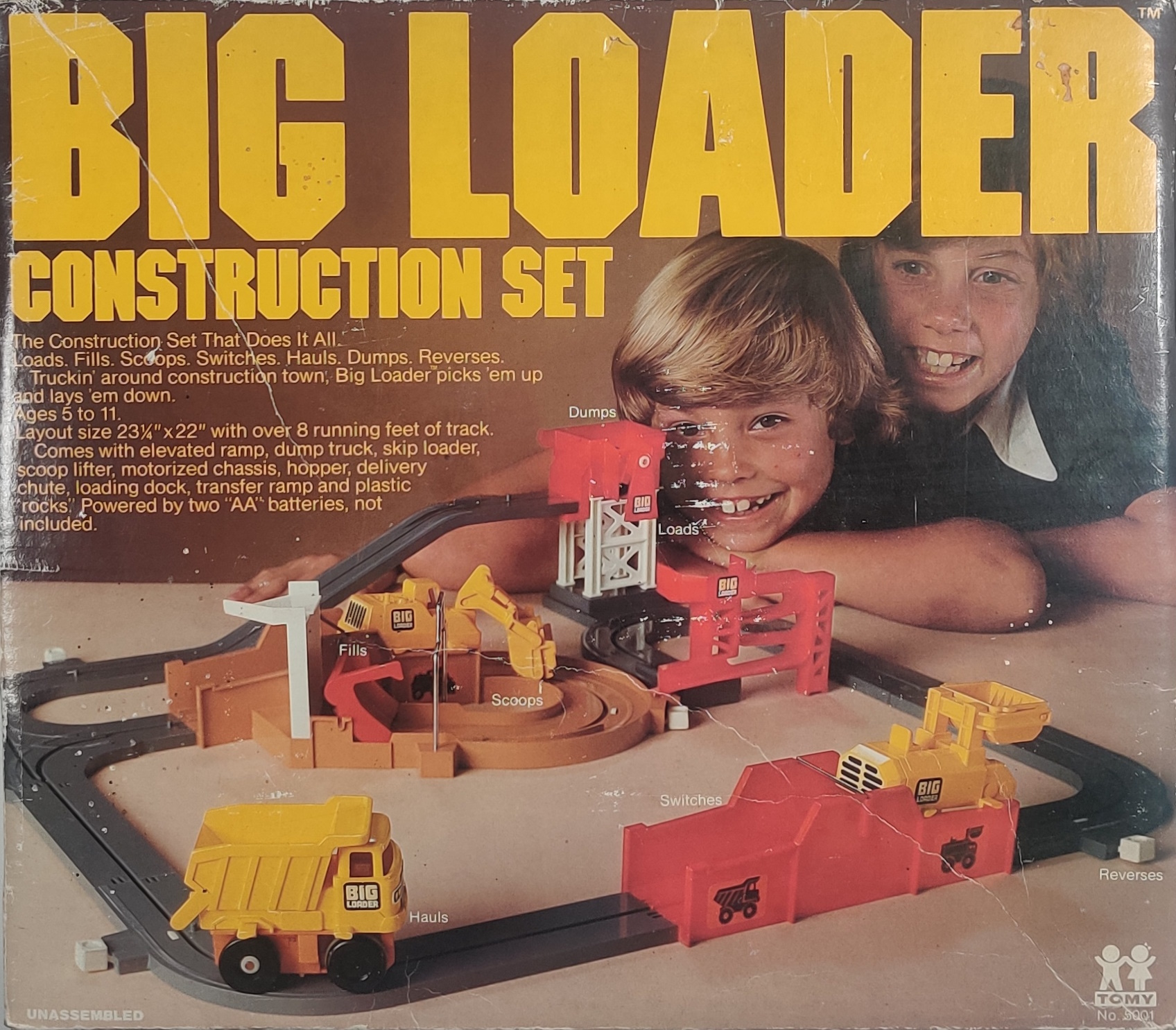
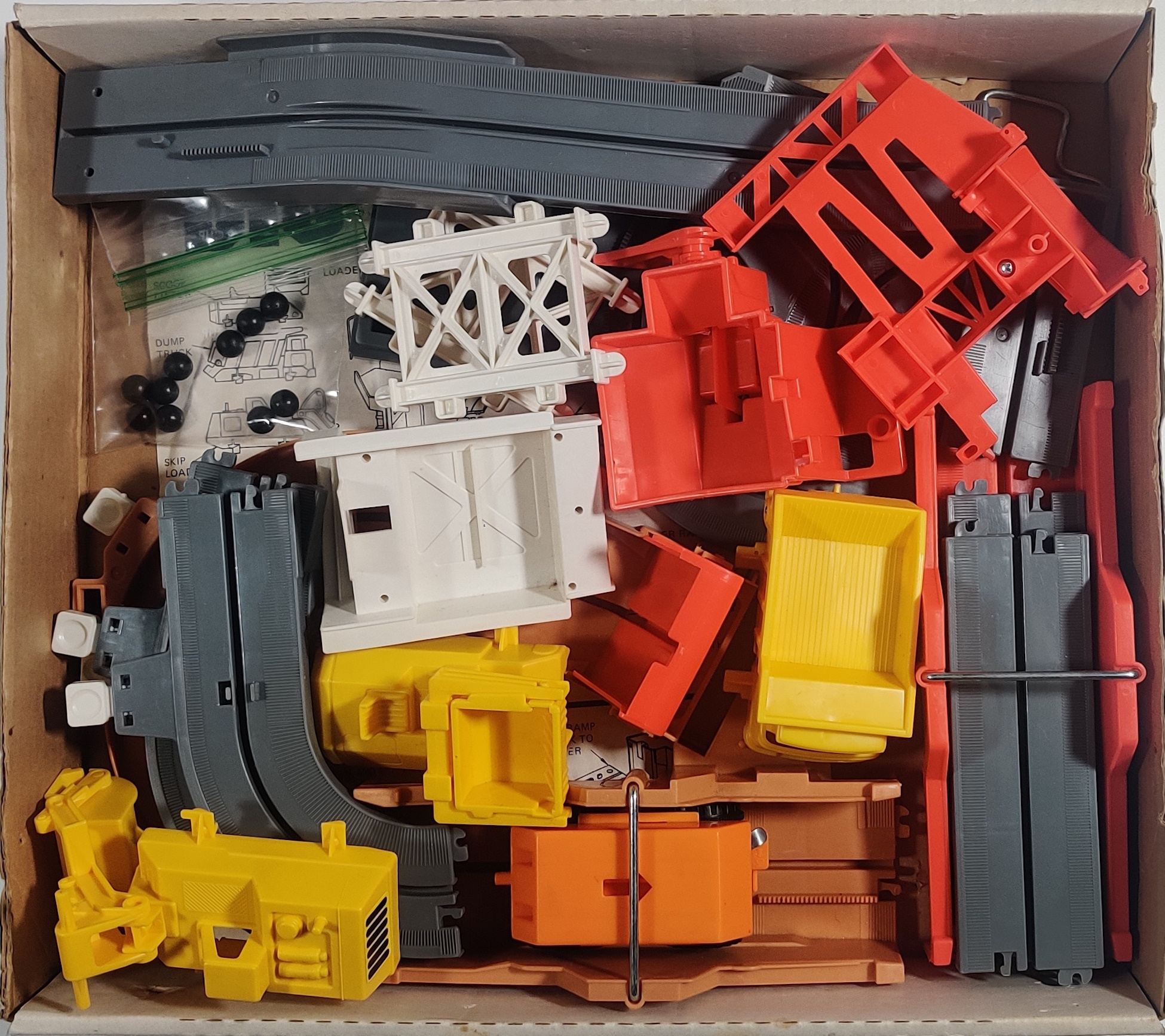
In 1977 the classic Big Loader was released in the United States in a nice 1970s brown and tan box with construction-y text. The set has nice bright yellow vehicles, grey roadway, and red, brown, and white destinations and trackside components.



Set contents
| Quantity |
Item |
Photo |
|---|---|---|
| 1 | Power chassis |
 |
| 1 | Dump truck shell |
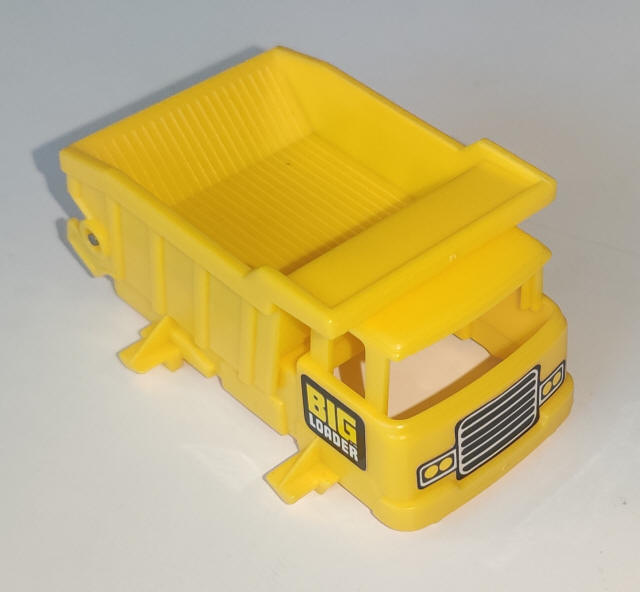 |
| 1 | Scoop lifter shell |
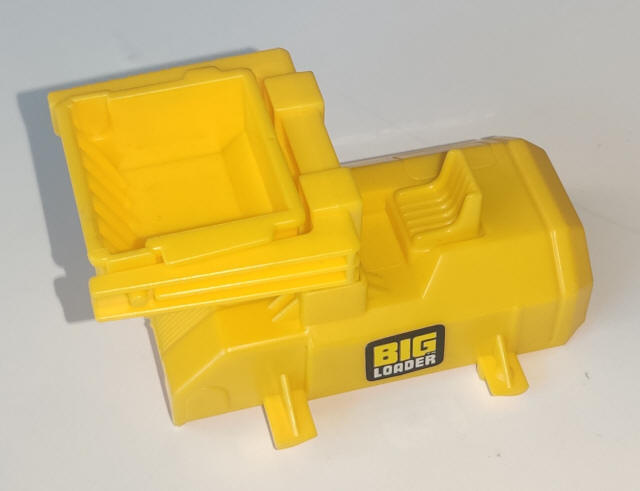 |
| 1 | Skip loader shell |
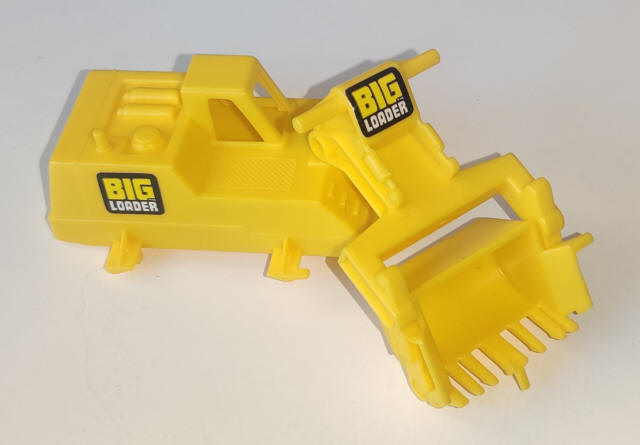 |
| 4 | Straight track |
 |
| 3 | Curve track |
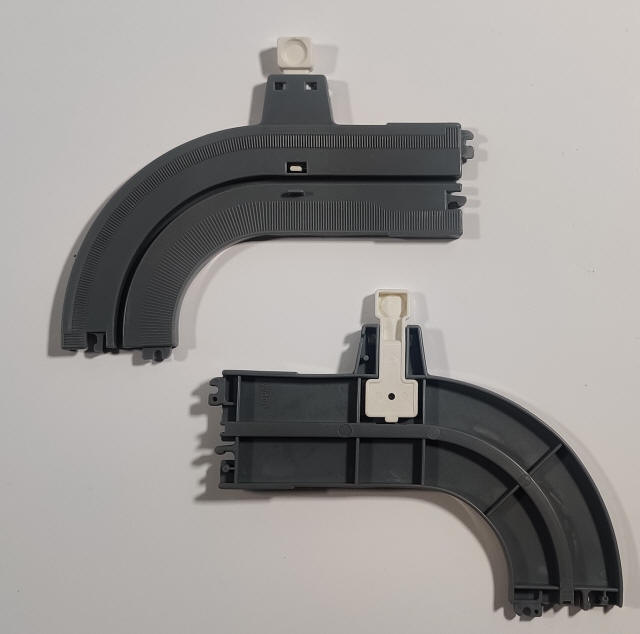 |
| 1 | Switch track |
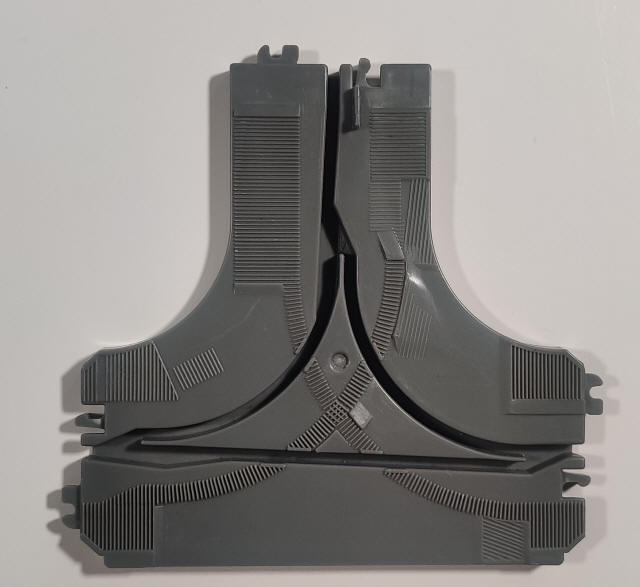 |
| 1 | Hopper track |
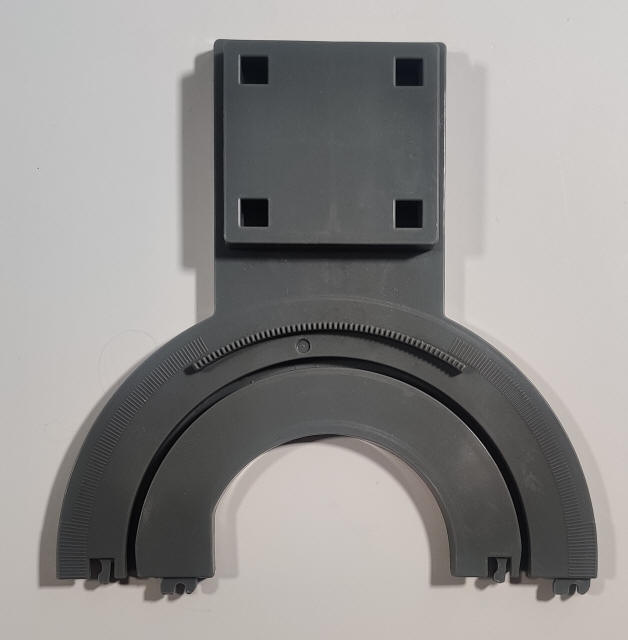 |
| 1 | Short track |
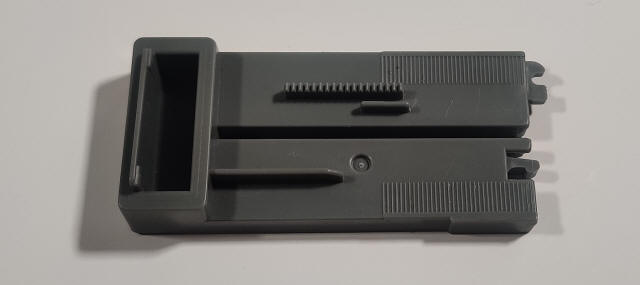 |
| 1 | Ramp track |
 |
| 1 | Transfer ramp |
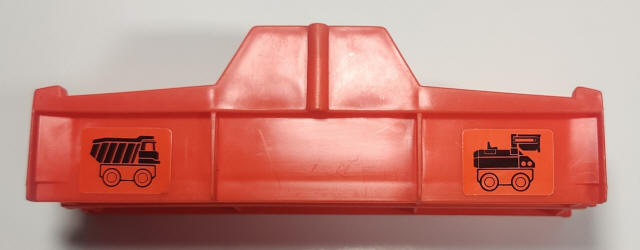 |
| 1 | Loading dock |
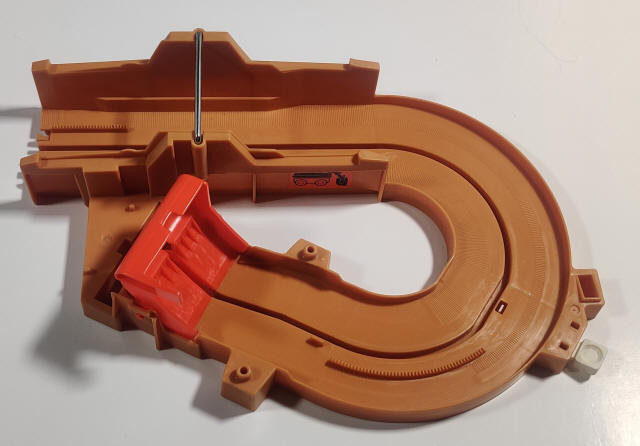 |
| 1 | Loader gate |
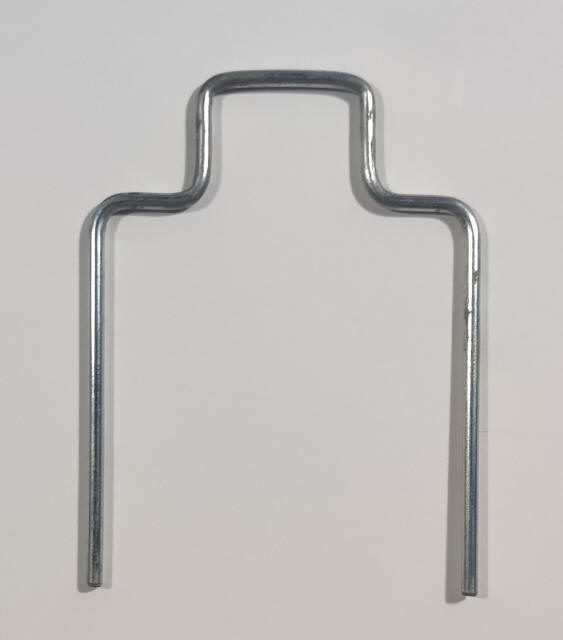 |
| 1 | Loading trough |
 |
| 1 | Hopper |
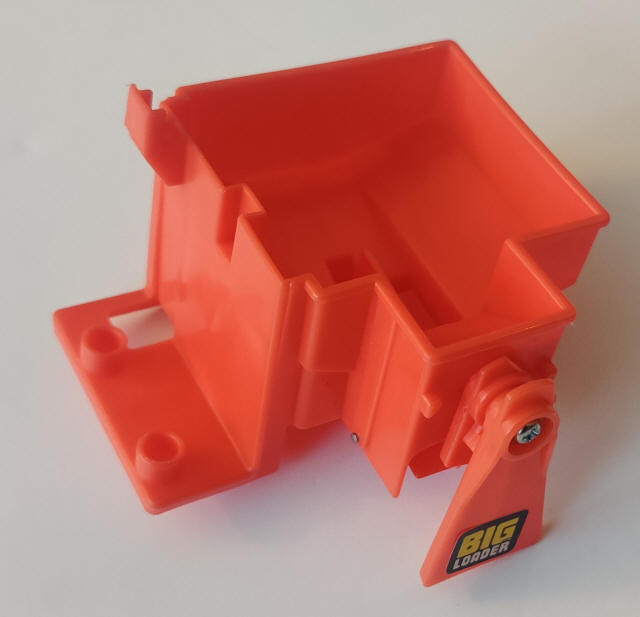 |
| 2 | Hopper supports |
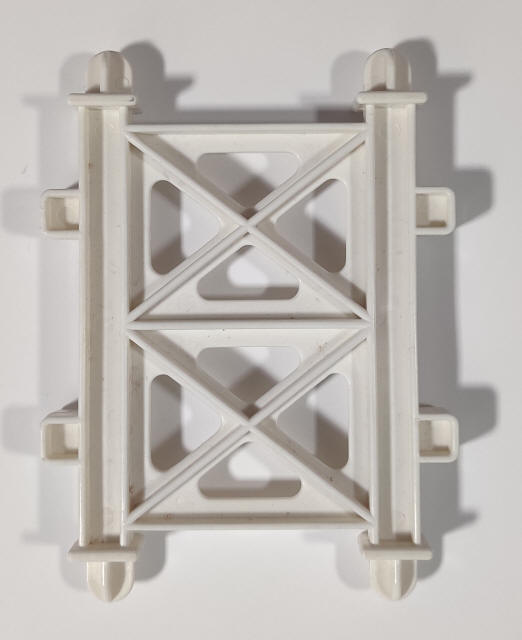 |
| 1 | Delivery chute |
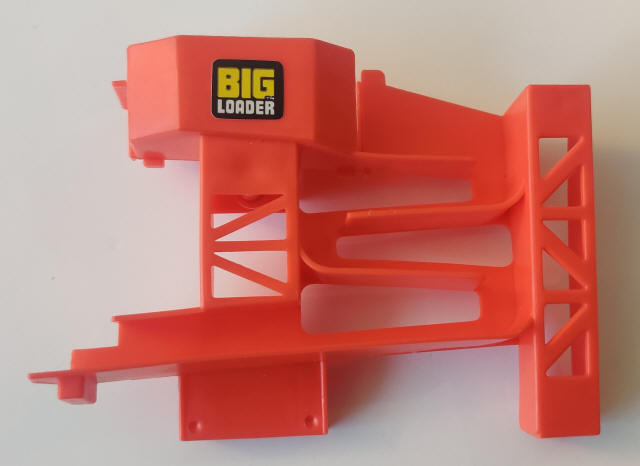 |
| 12 | "Rocks" |
 |
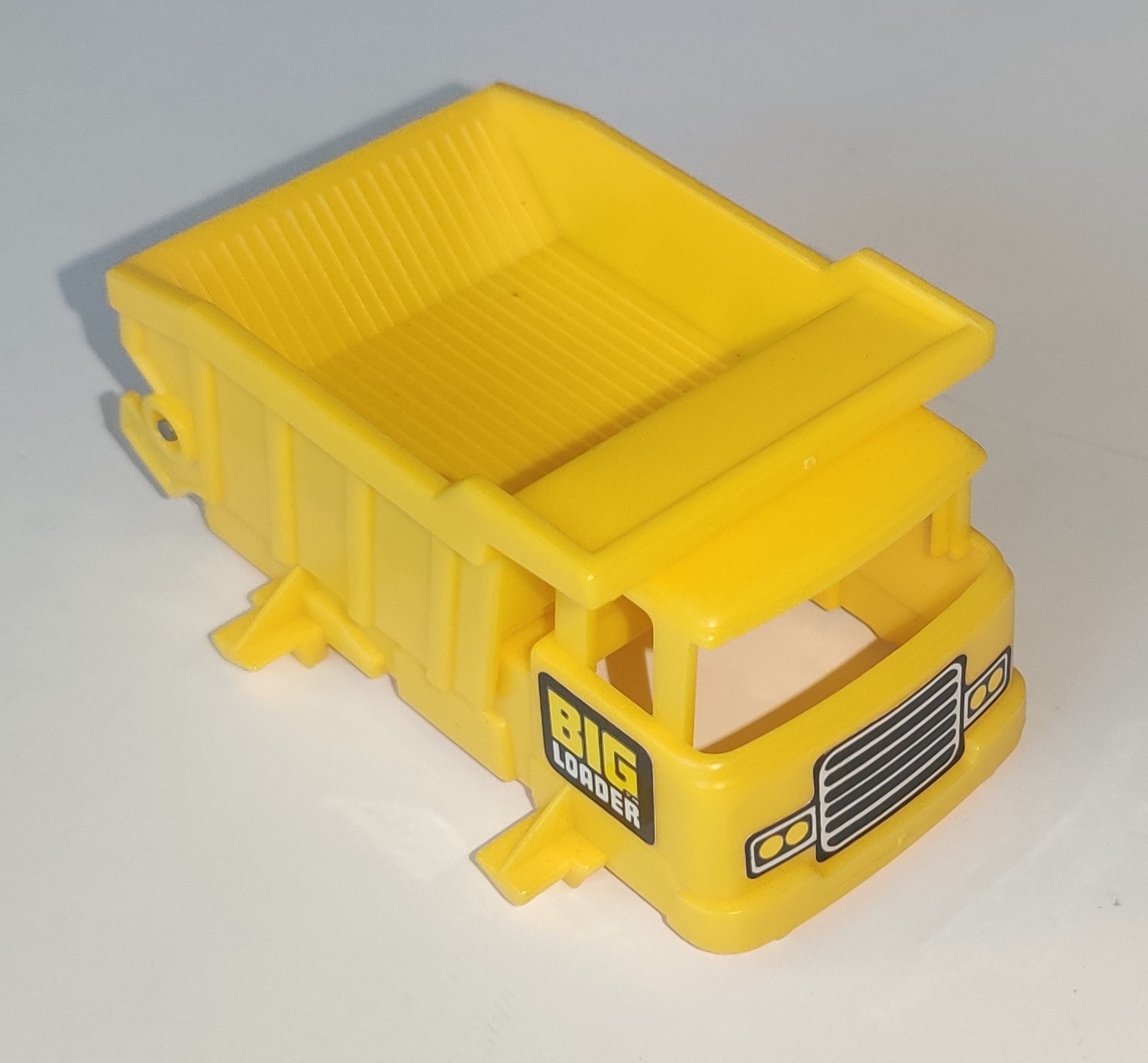
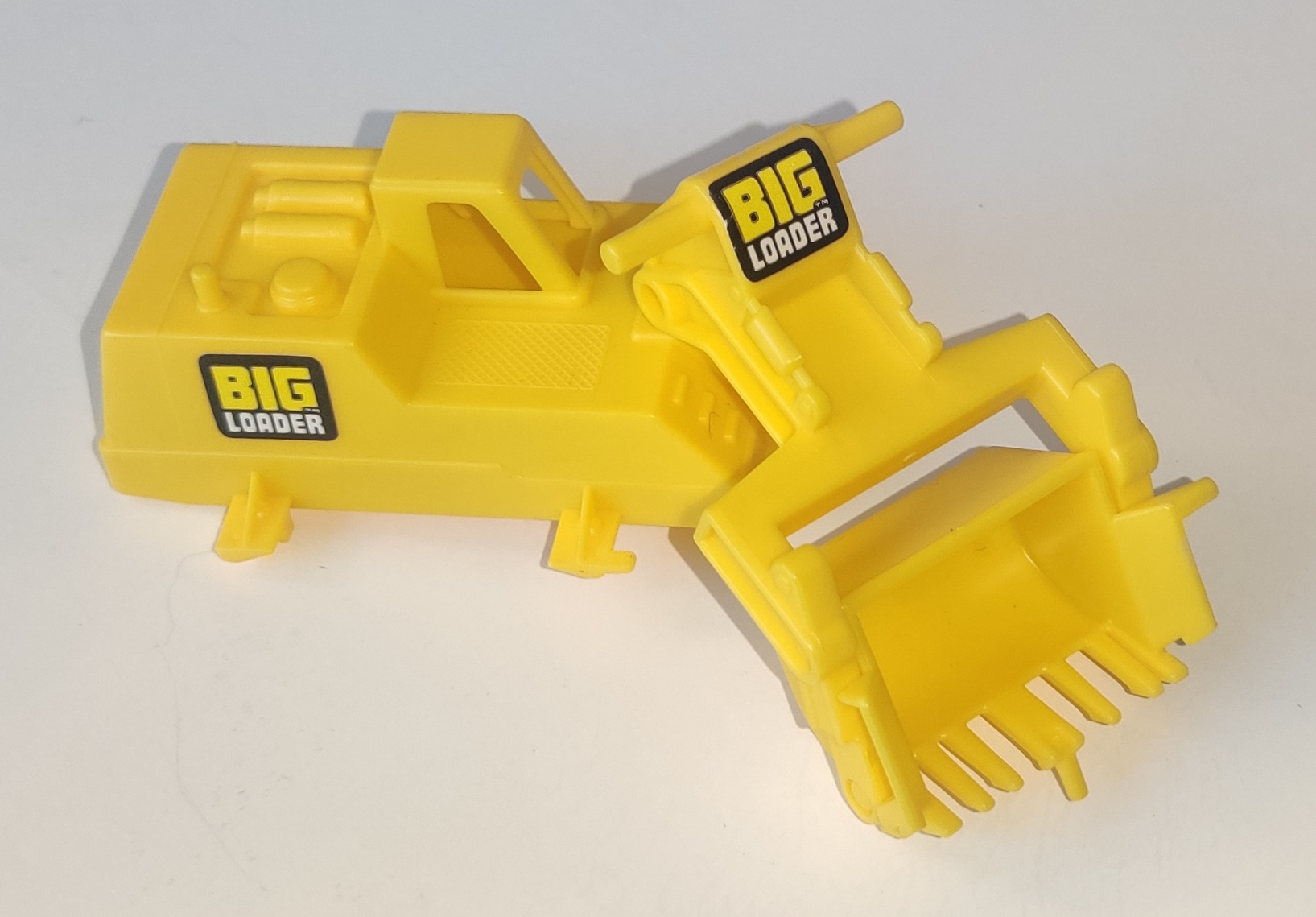
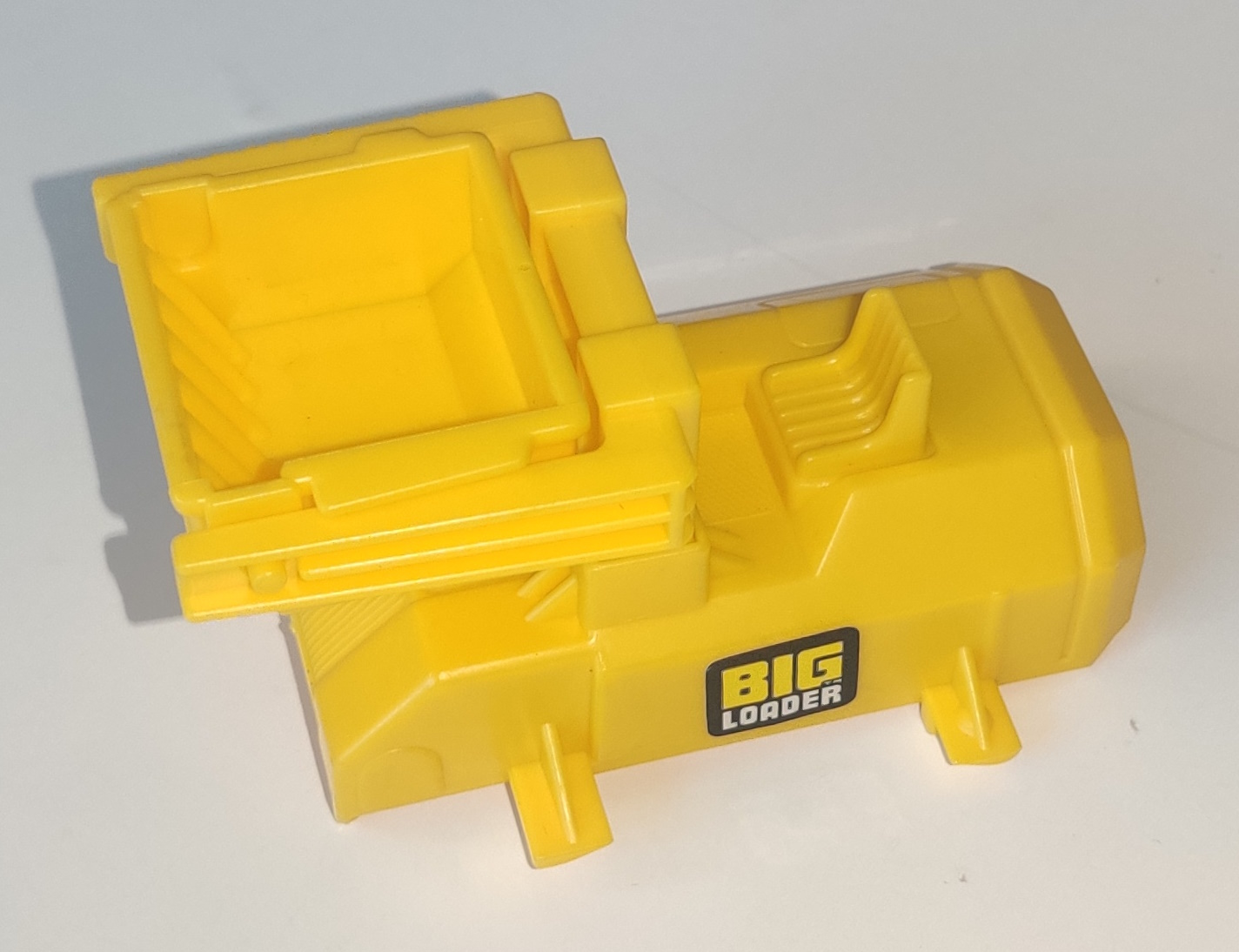
The original Big Loader uses three different construction vehicle tops; a dump truck, a skip loader, and a scoop lifter. In later releases, the vehicle pictured in the middle is called the scoop lifter and the vehicle on the right the skip loader instead, which seems to make more sense to me and seems to have been an error in the original English instructions.
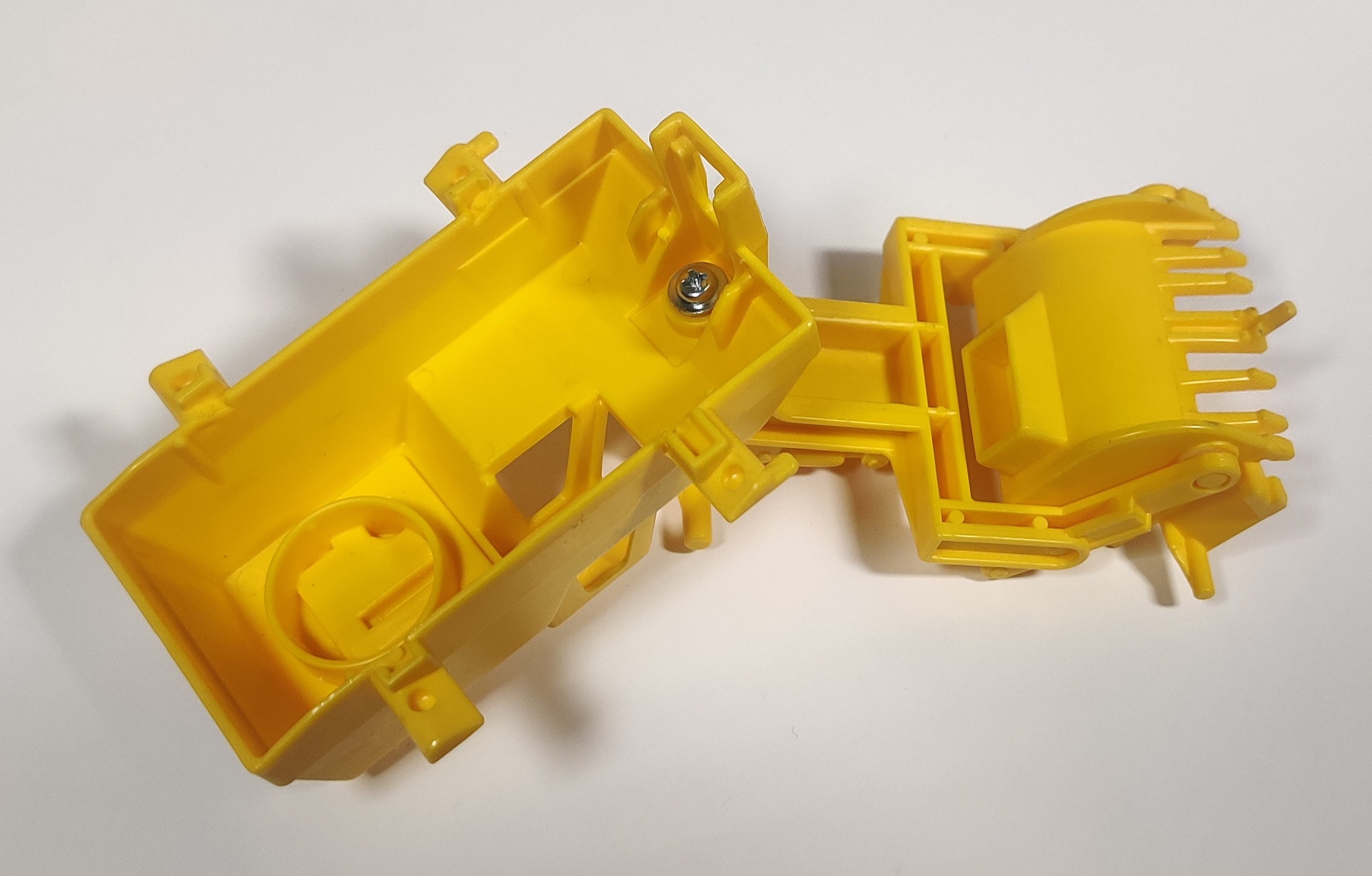
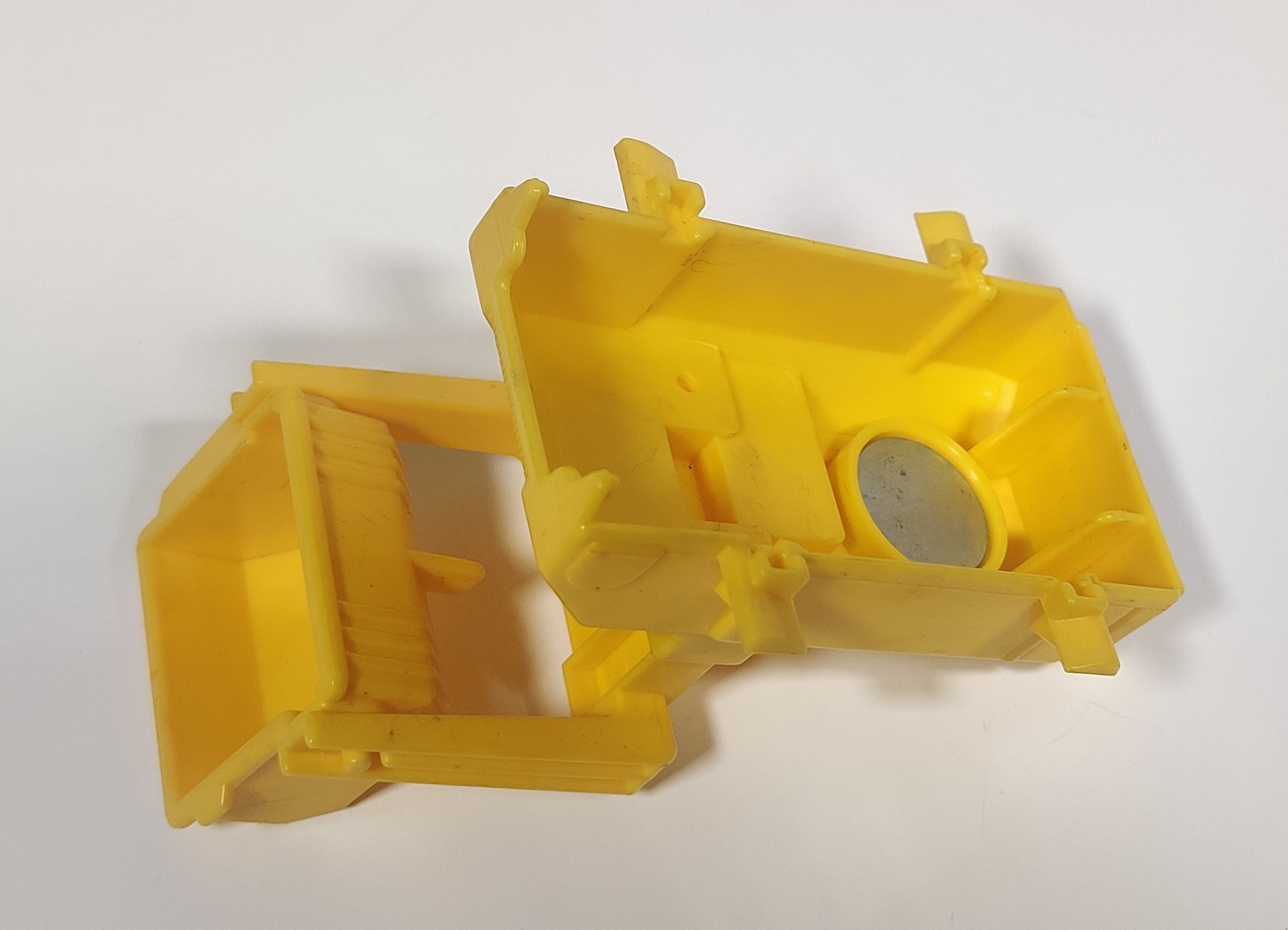

The scoop lifter has a round weight in the bottom, while the others have cutouts. Seemingly it was found during the development of the toy that extra weight was not necessary on the other vehicles. The vehicles are also marked Japan - the dump truck and skip loader under the cab roofs, and the scoop lifter under the scoop.
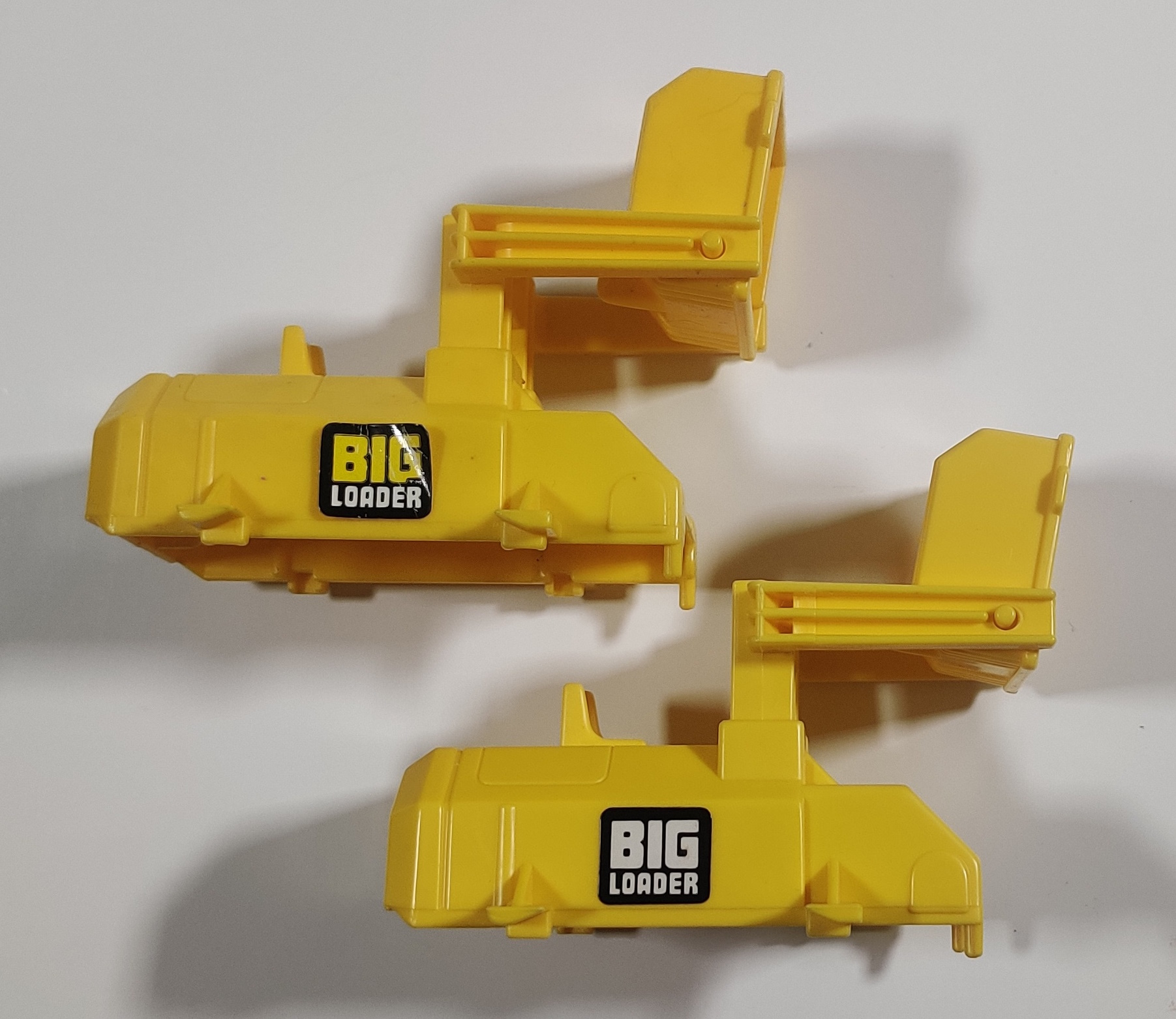
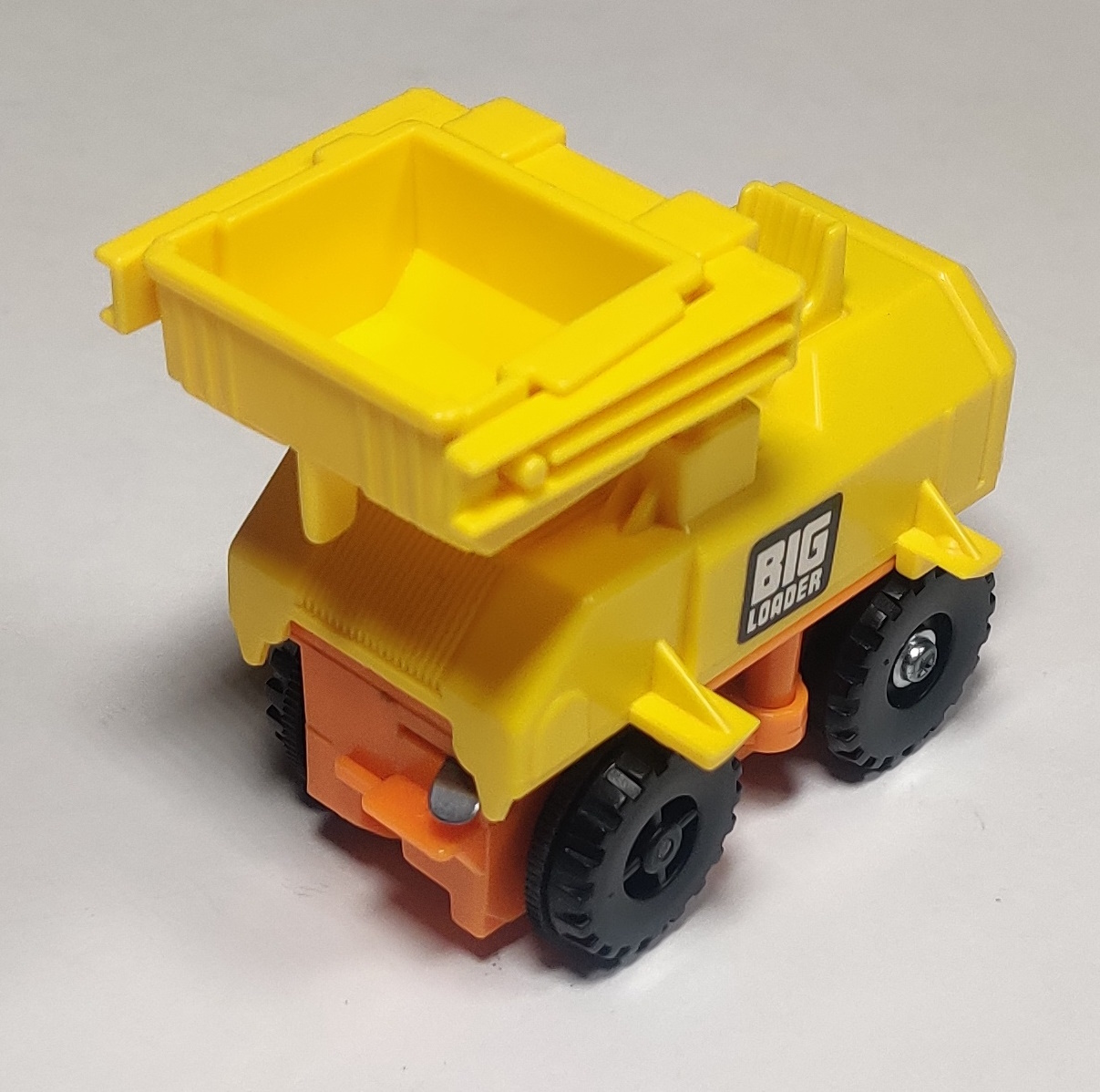
Earlier 1970s-early 1980s copies of the set have yellow and white Big Loader stickers with a TM mark in the lower right corner of the G. Later releases of this original color scheme use a lighter sticker design with no TM mark. I currently have two examples of early American Big Loaders, one slightly older than the other. The newer copy is missing most of its Big Loader stickers and is videoed running below (I owned it first and thus it was the one I initially filmed).
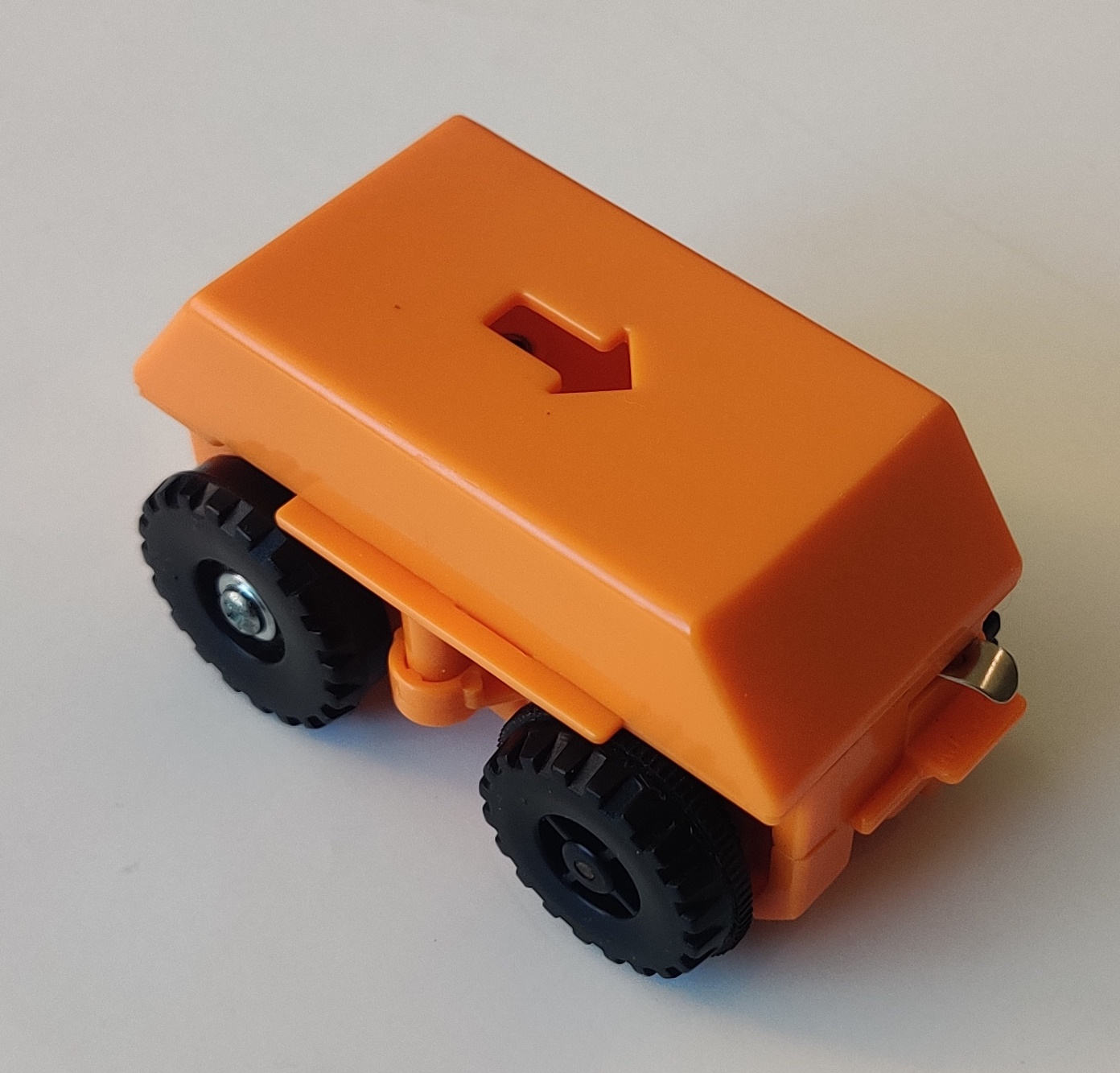
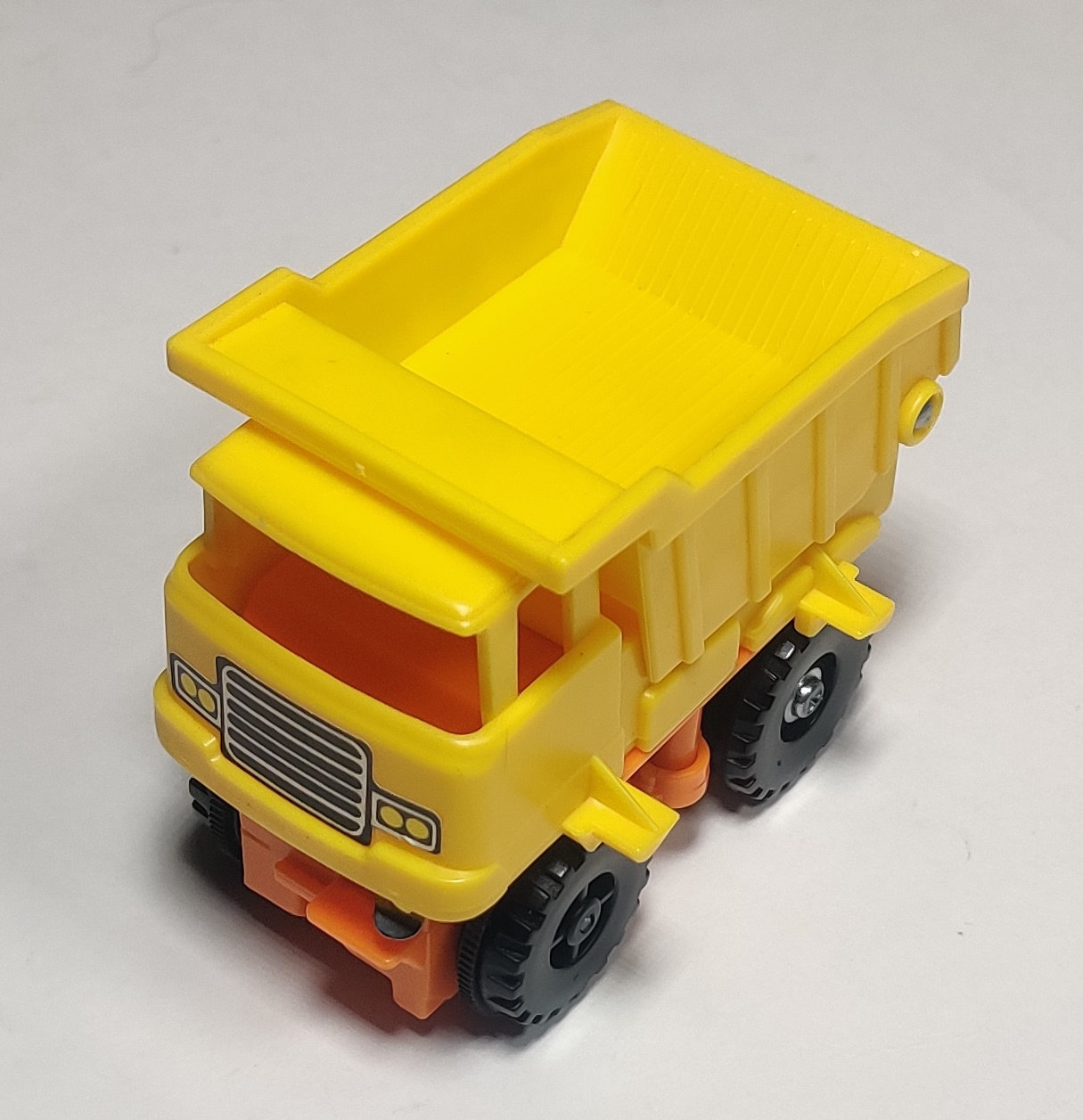
The powered chassis in the Big Loader sets is a squat four-wheeled trapezoidal shape with molding features to engage with different parts of the playset. The peg sticking out of the "rear" catches in the tooling of some of the vehicle shells, and the angled surfaces help the body shells swap places at the interchanges. An arrow on the top of the battery cover indicated which direction is forward. Chassis from the 1970s to the early 2000s use protruding metal power switches while later versions from 2002 and after use an off-the-shelf plastic electric switch.
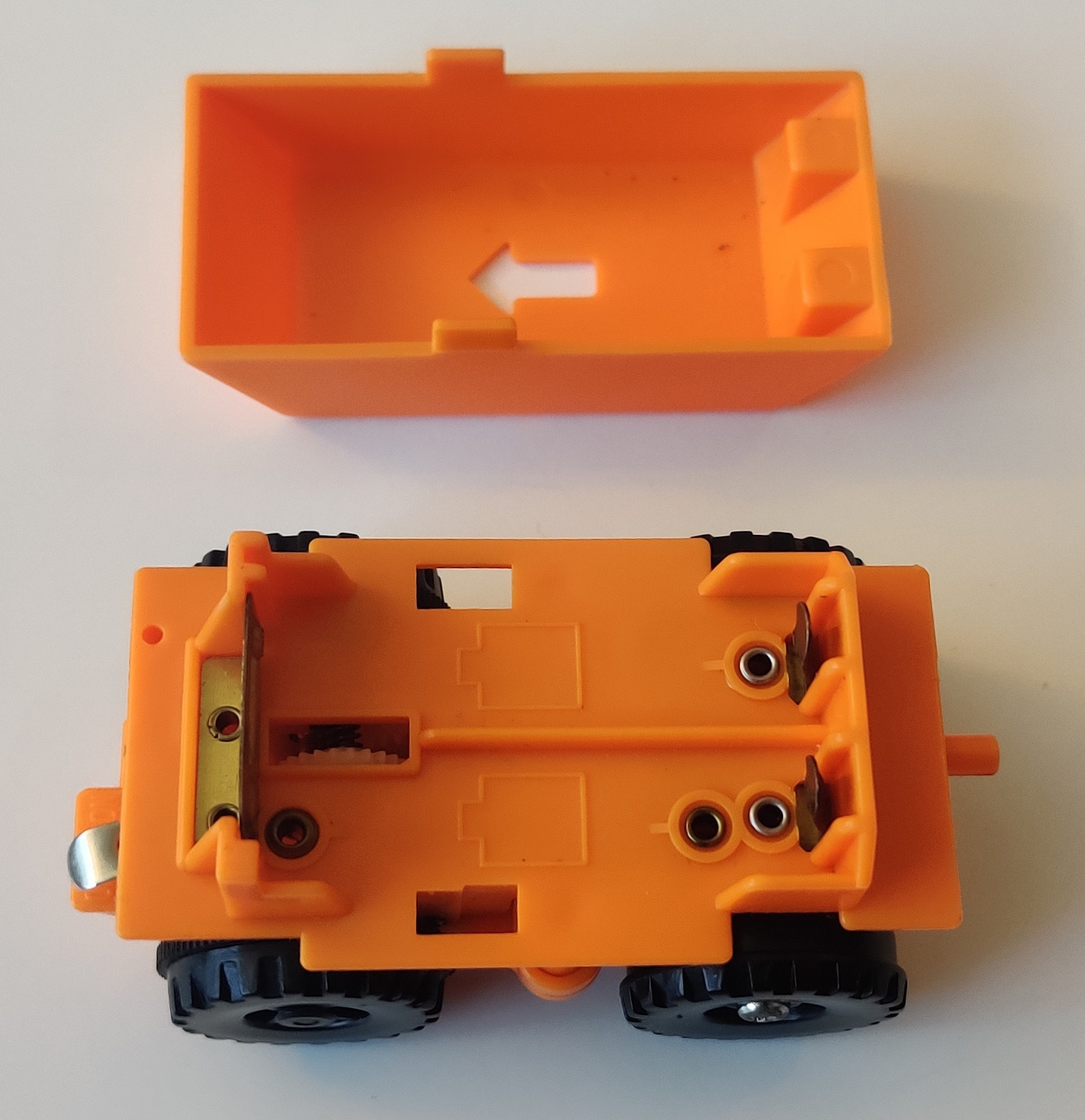
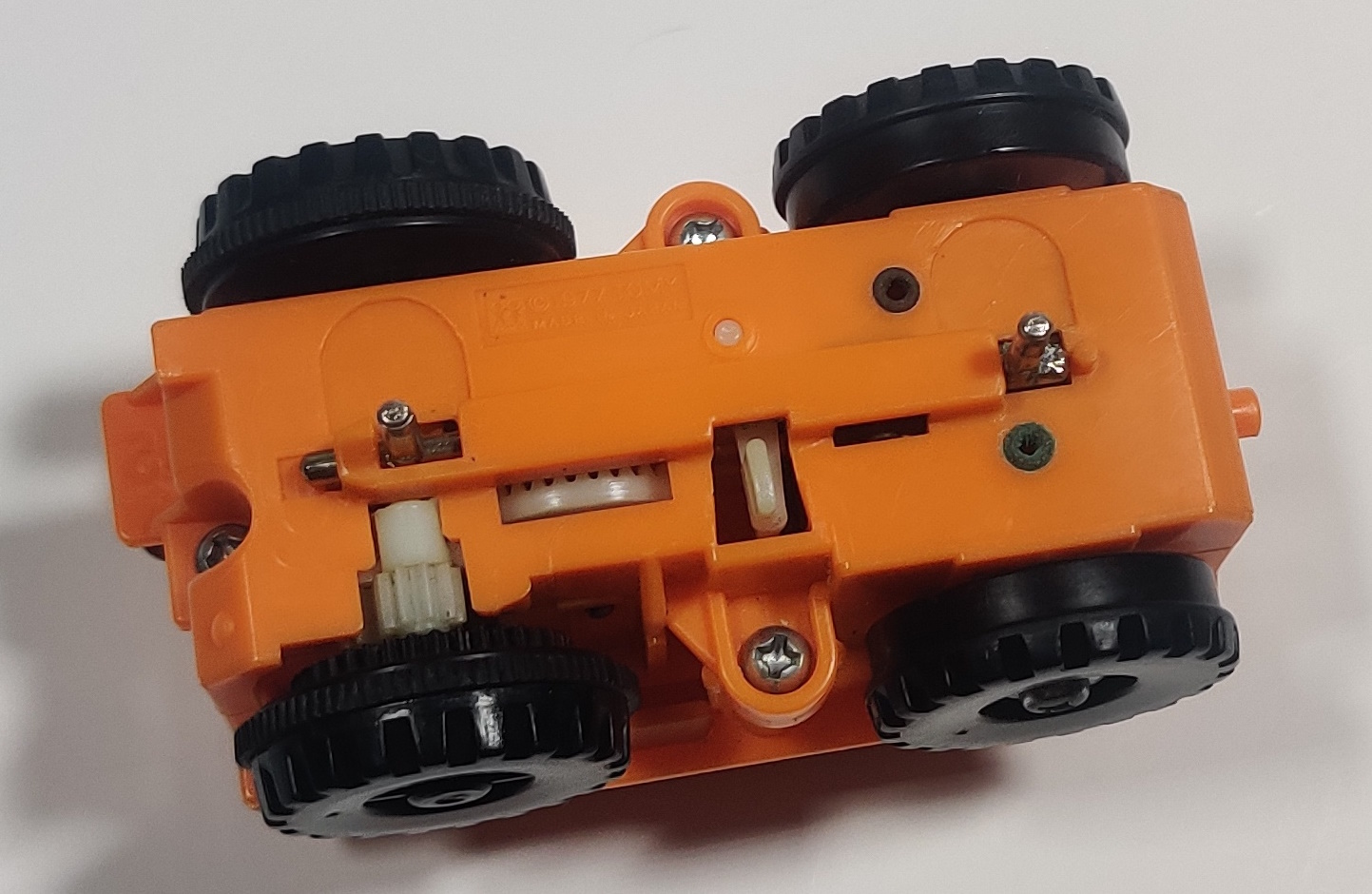
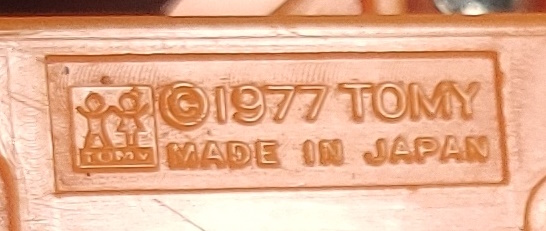
The original 1977 American Big Loader shown here uses two AA batteries in a Japan-made chassis, although most later Thailand-made versions used a single AA. The chassis in this set is burnt orange color. It is front-wheel drive and a gear system under the front right wheel engages with some parts of the track to slow the vehicles down. A hanging lever also to the left changes the Big Loader's direction. This directional changing lever is entirely mechanical inside the gearbox. These chassis are fairly complex little things and are often found with 15 to 40 year old batteries, corrosion, dirt, and dust still sitting inside - some notes about repairing them can be seen on this page. A swinging metal bar has protruding pegs that sit in a groove in Big Loader's track. These can be swung up against the chassis to allow the chassis to run on a regular surface.
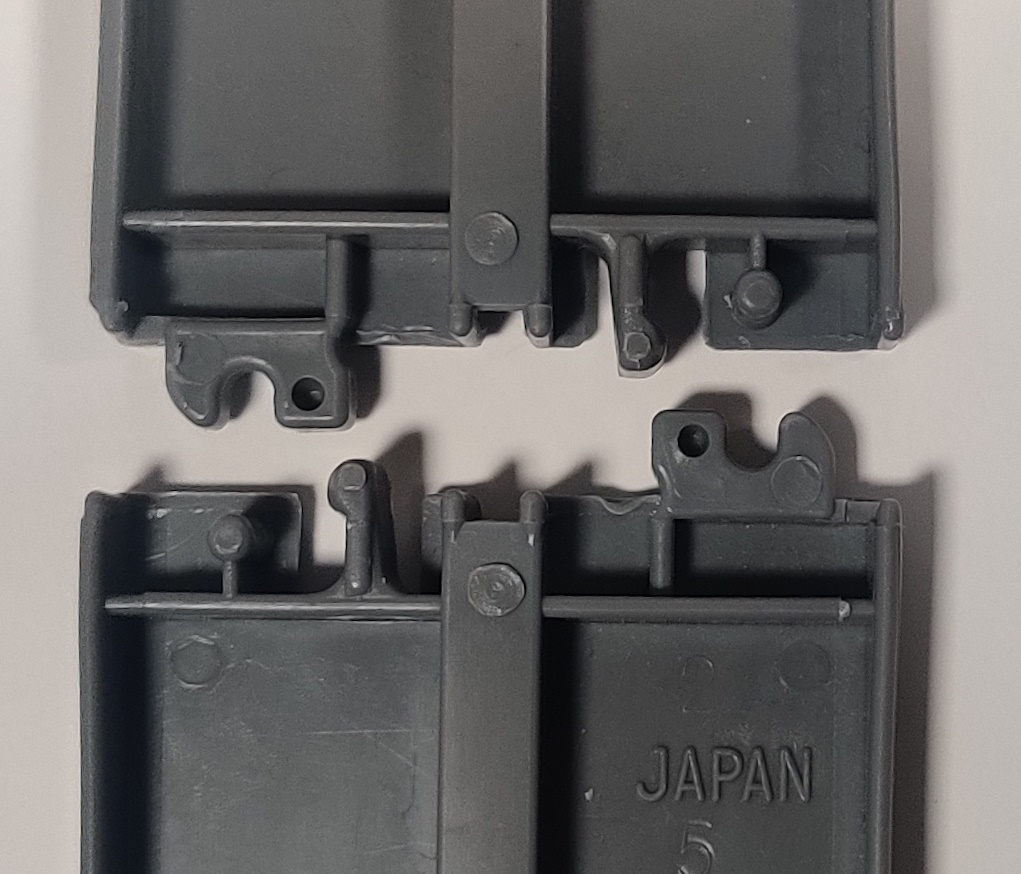
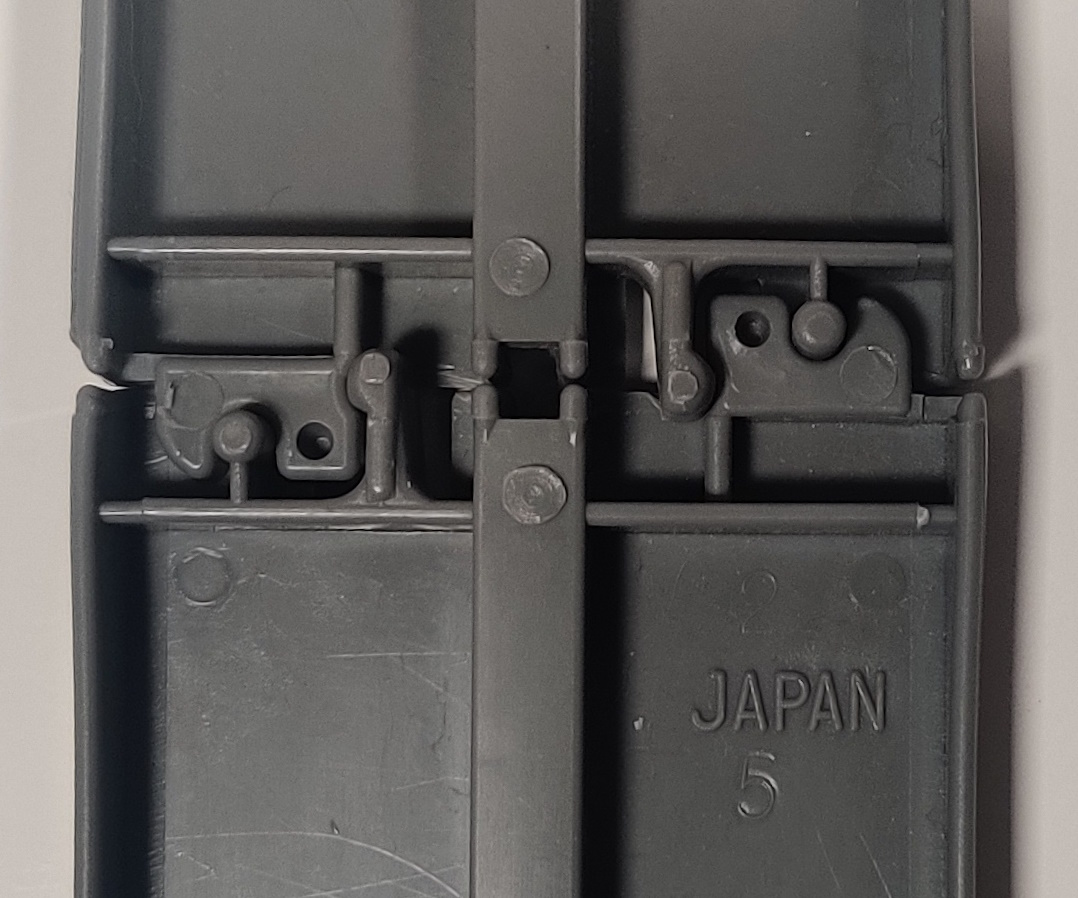
Big Loader is a "construction set" both in that it requires assembly and represents a construction site. Big Loader does have a track standard but it does not have a wide range of pieces and each set only includes specific pieces to make its own layout, so it is not really a "construction system" the same way LEGO or Meccano/Erector or K'Nex is.
The key to the functionality of the Big Loader is the interaction between the powered reversible chassis and the three-way switch track. In essence, the Big Loader is a state machine - every time the chassis returns to the switch it is sent travelling down a new branch in either the "forward" or "reverse" gear, whichever it entered in.
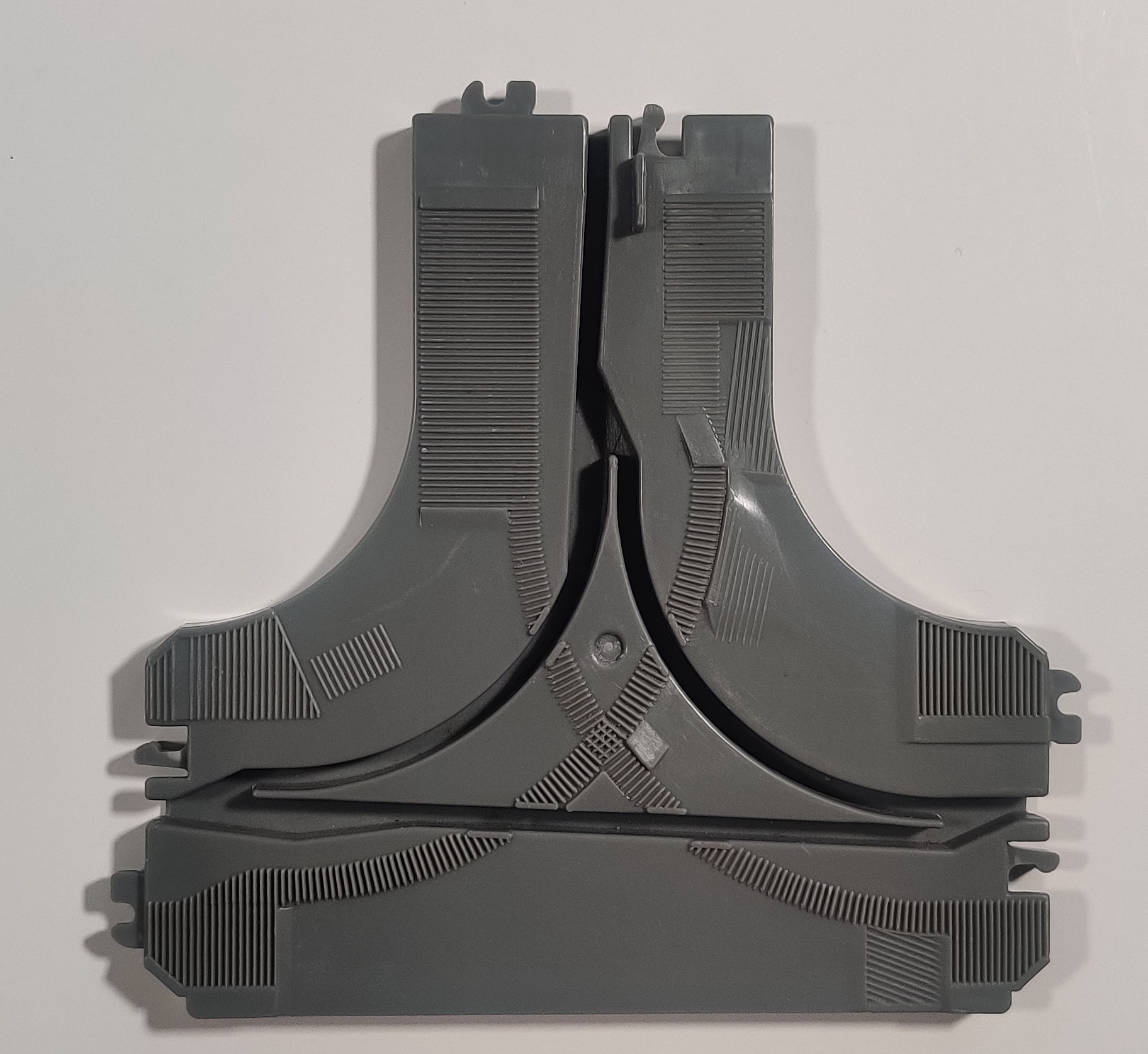
The guide groove present in the switch will guide the chassis out of the switch one counter-clockwise branch around the triangle, still heading the same direction, with the chassis reversing somewhere down each branch to head back. This three-way switch combined with the two directions the chassis can be running give the machine its six basic states. Because the power car is facing different ways in each of its two states spent in each branch of the switch, the reversing lever on the underside of the chassis will be on different sides of the guide groove in each state and thus the chassis will interact with a different set of reversing pegs, causing the vehicle to return sooner or later and, in particular, reach or not reach specific intractable accessories. I first heard this state machine description in a Julian Ilett YouTube video many years ago, and I have thought and re-thought about the mechanics of Big Loader and its expansions many times since.
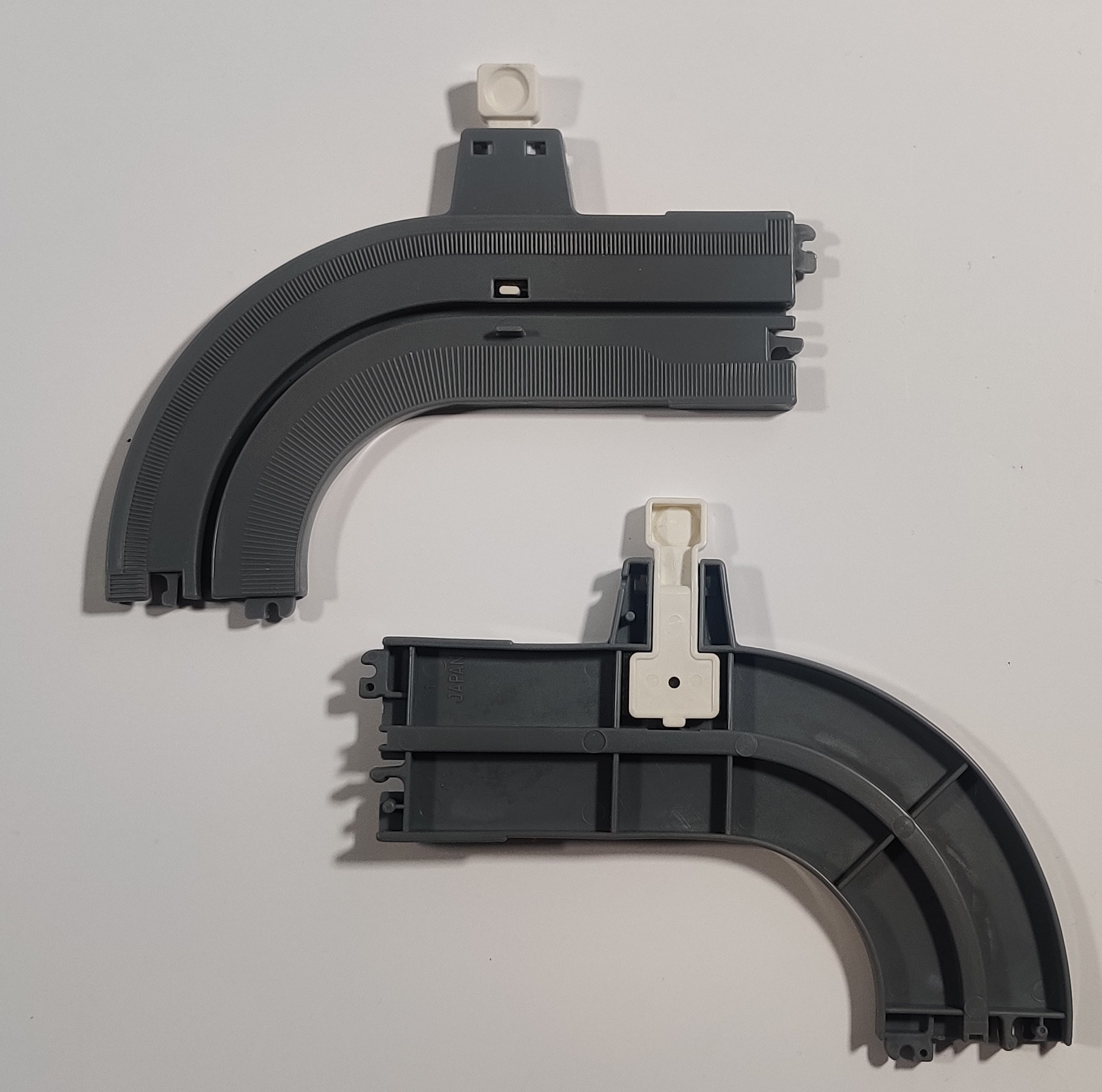
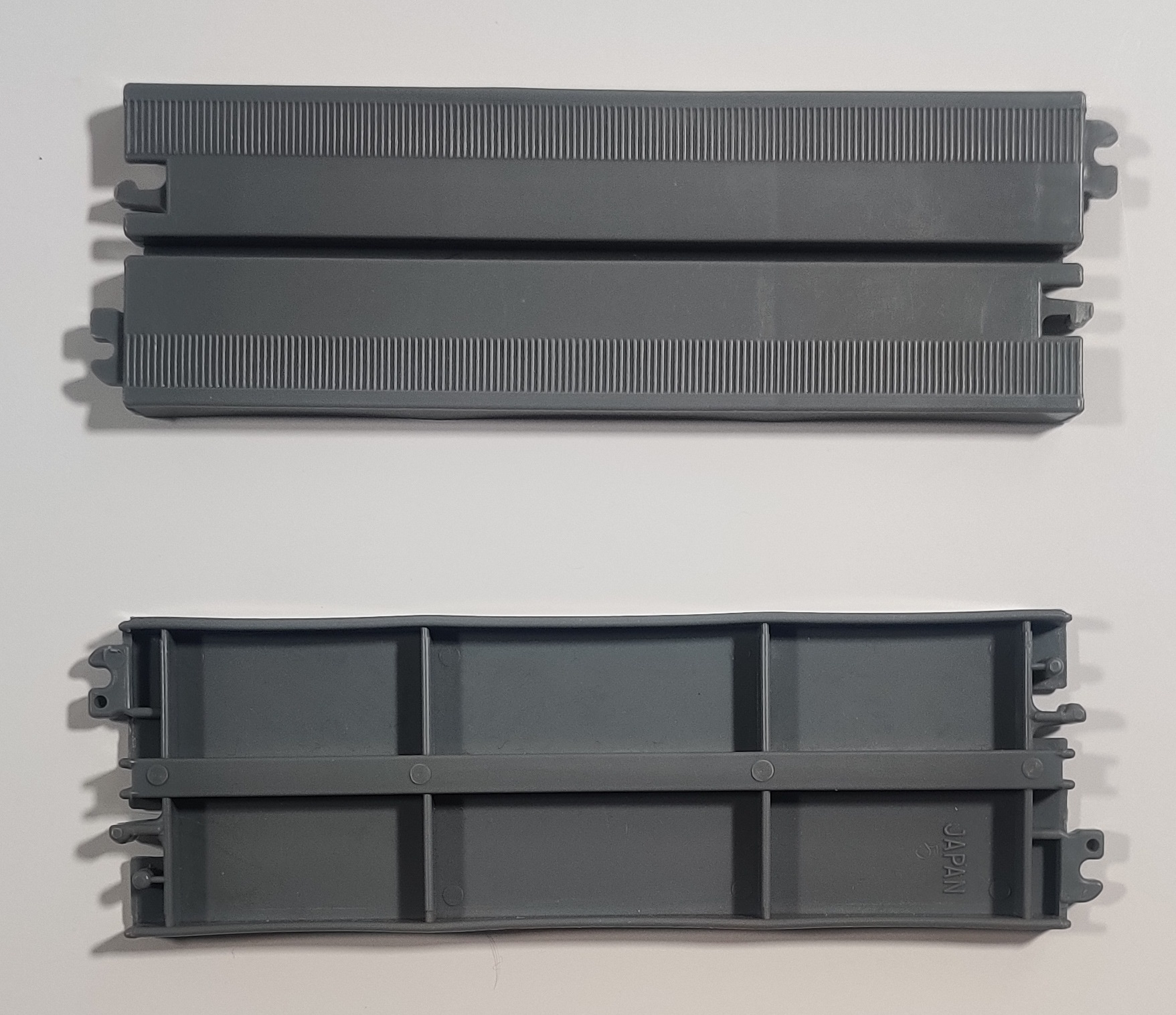
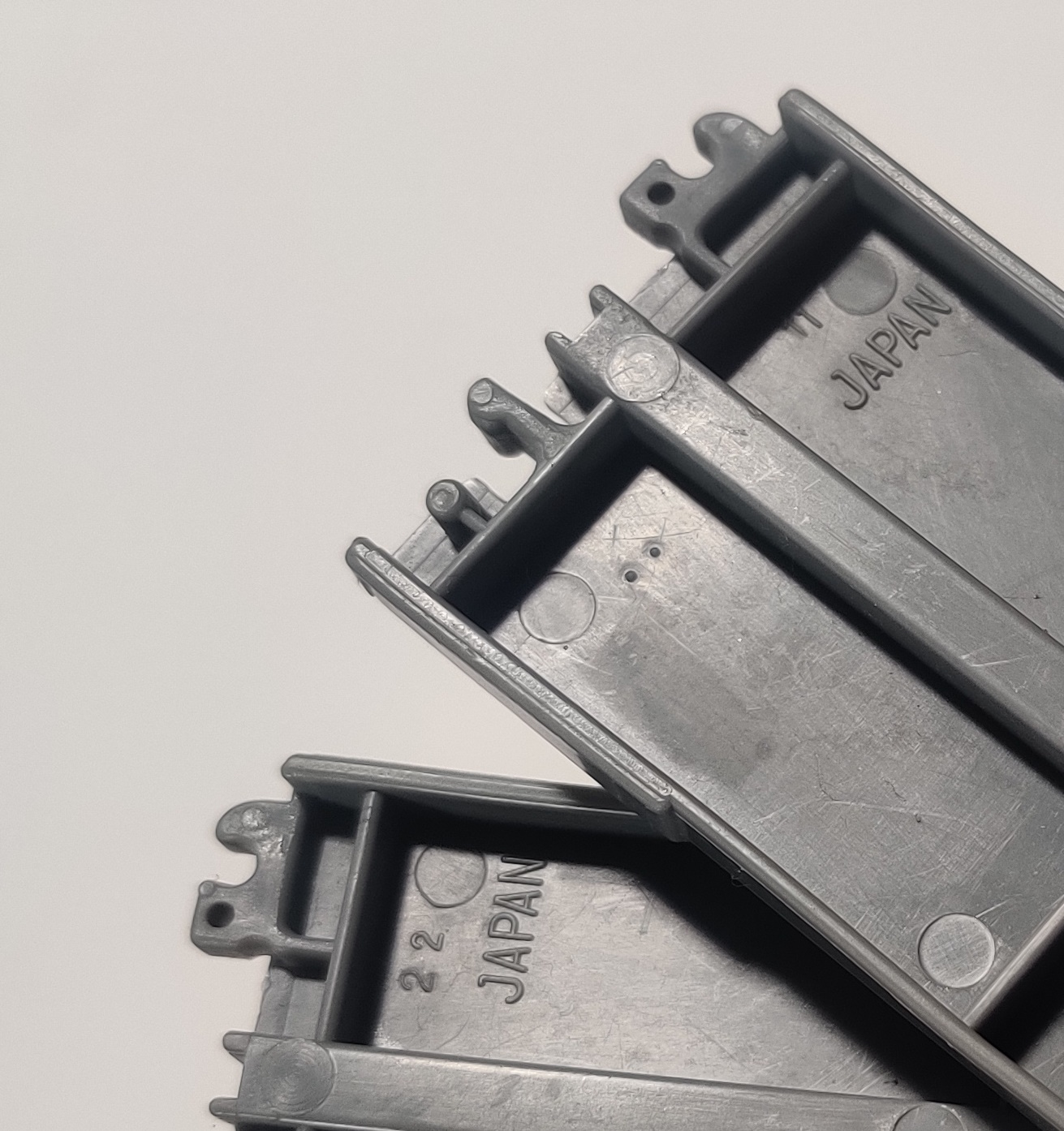
There are some more generic "track" pieces that are used multiple times like a standard straight track and curve track. Curve tracks have a built-in reversing peg in the inside of the guide groove with a button hanging out from the side of the track that raises a reverser on the outside of the groove. A piece of foam helps spring the button back up. The curve track is somewhat odd geometrically, with one leg having a longer straight section, but the Big Loader rail "standard" is really only designed to make its own specific courses, with new track pieces simply being molded to fit a new set's layout if necessary. You can see near some of the Japan marks multiple slot molding marks to keep track of which slot in a larger tooling die individual components came out of - there are some later versions with four different slot marks.
Three curves come in the standard Big Loader but by borrowing a curve and more straights from another set many simple square and rectangular layouts can be set up, although the chassis must be running with the reverser switching hanging to the outside of the groove.
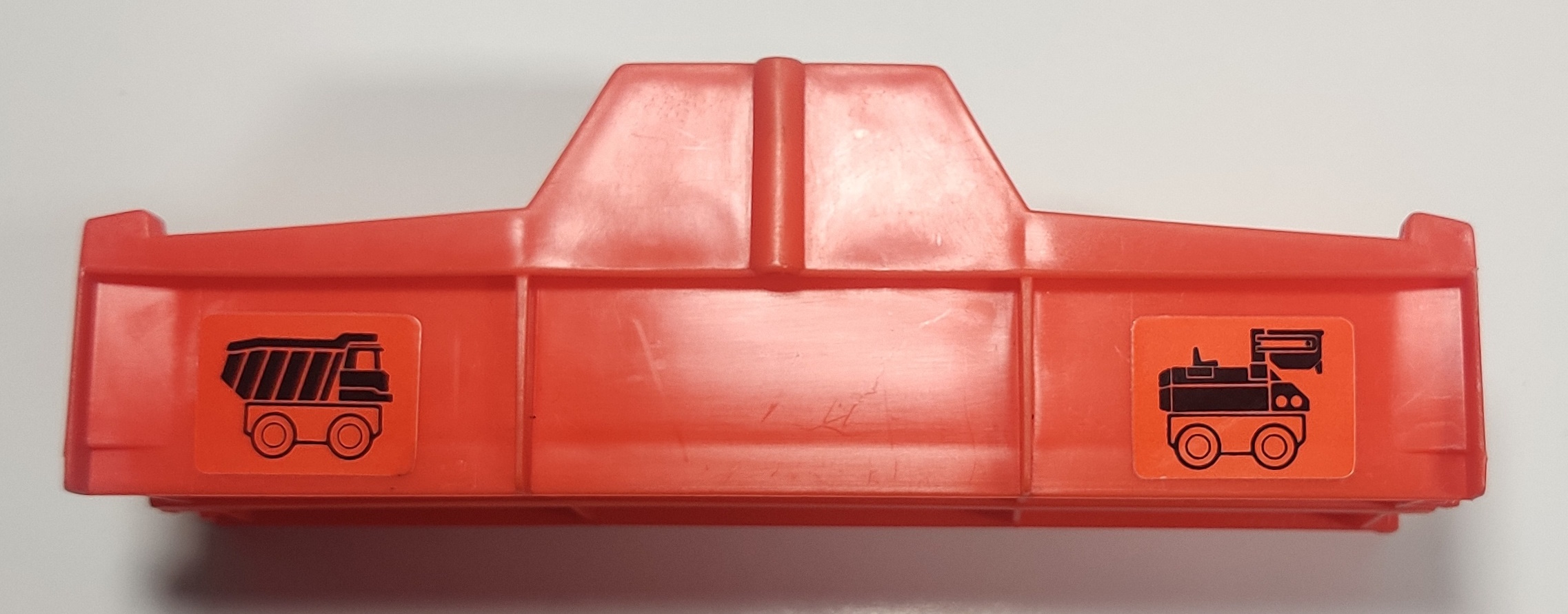
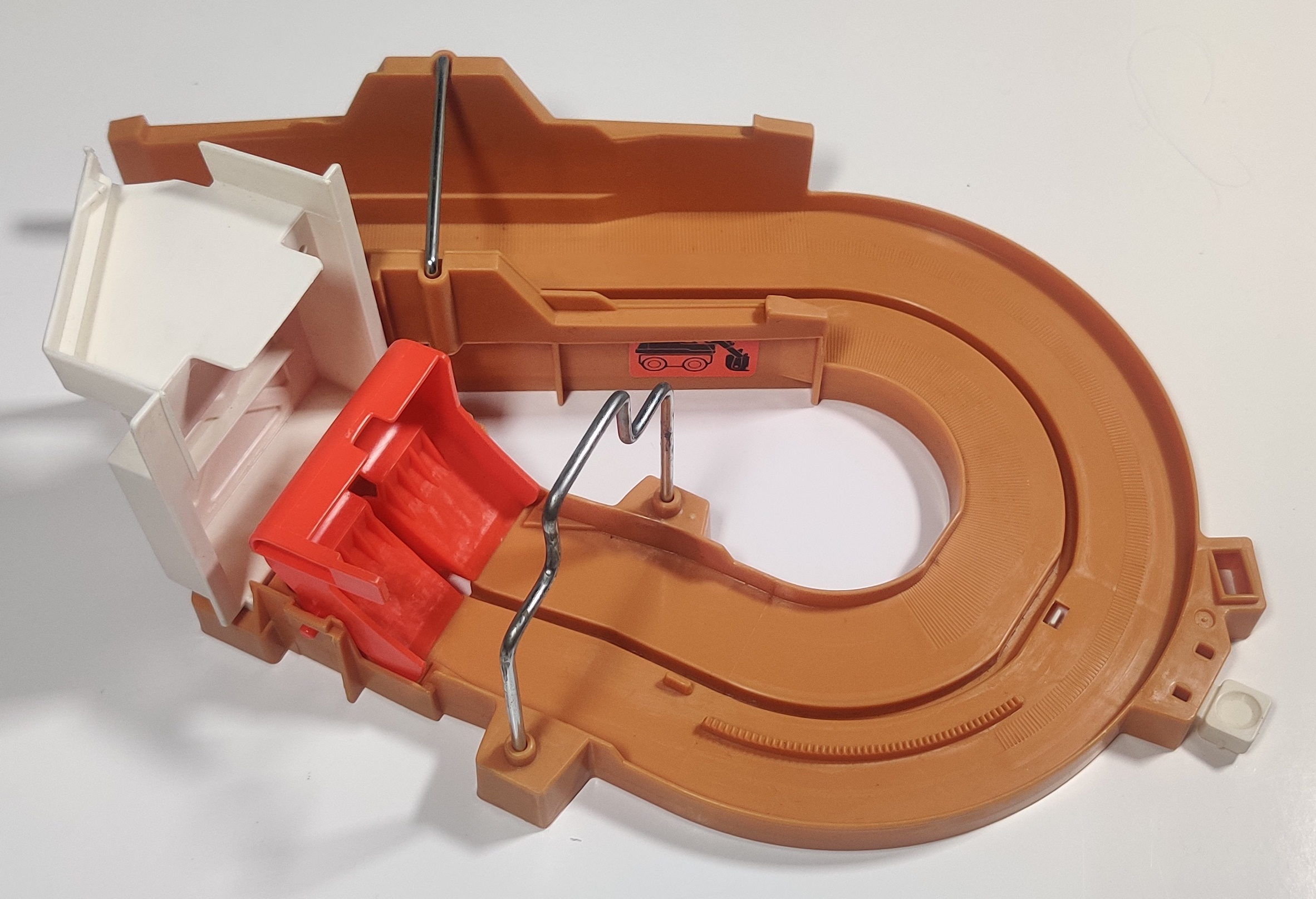
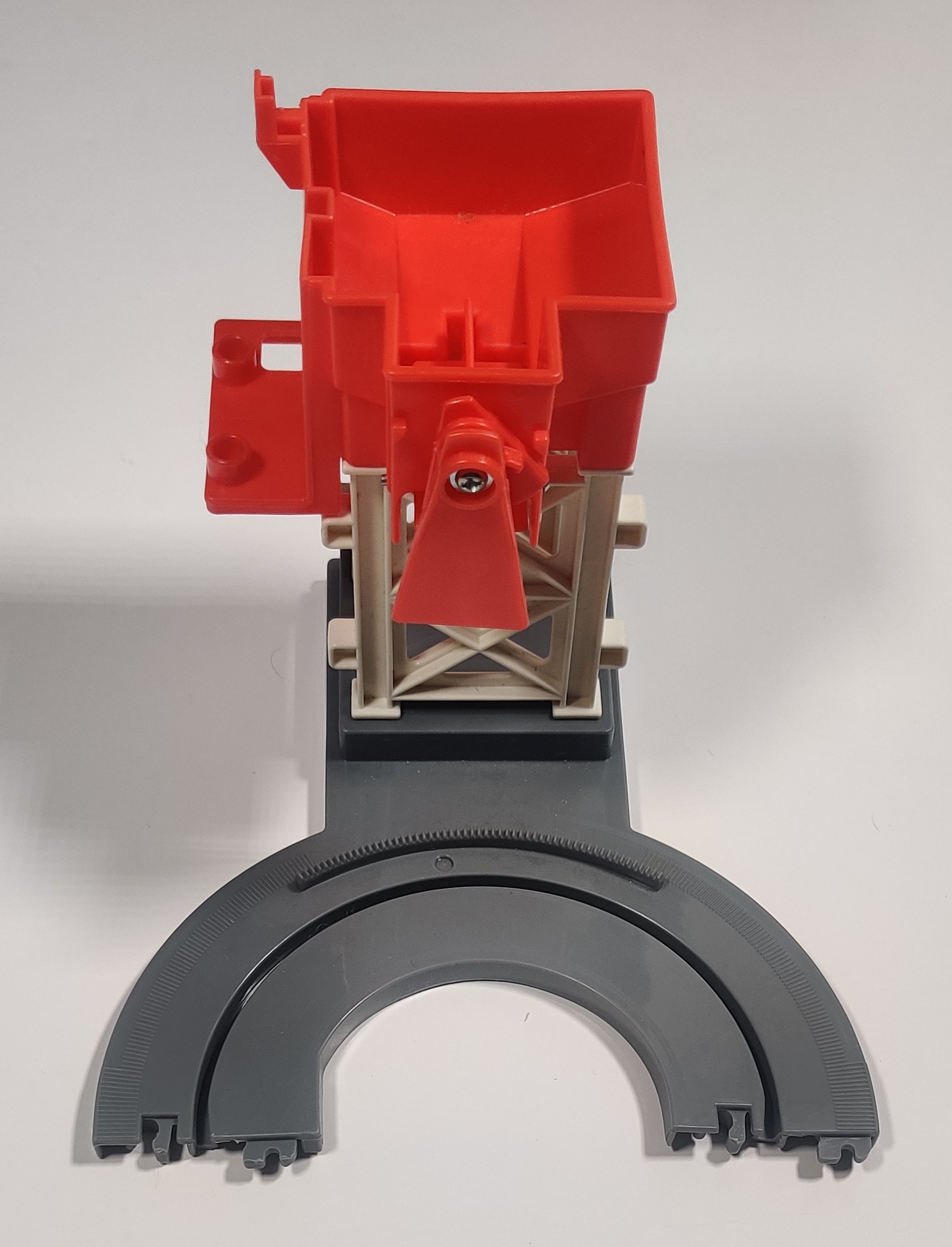
There are also some more specialized pieces like the dump truck and scoop lifter interchange or "transfer ramp" and the "loading dock" which encompasses an interchange and loading ramp and has the metal wire guide gate and loading trough added. There is also a tight 180 degree turn with supports for the hopper that also supports the raised portion at the rear of the layout. Some track pieces have a rack molded into them that will engage with the hanging gear under one of the powered wheels. These racks are all located downstream of an automatic reverser that will reverse the chassis if the gear is currently on the wrong side to engage with the rack - this is the interaction that ensures the different accessories are properly interacted with and prevents the chassis from reaching it if the top it is wearing is oriented incorrectly.




The bottom of larger components has the rectangular Tomy Japan mark with 1977 date while smaller parts have just the JAPAN text. The box image for Big Loader shows a style of sloping track with no outer guards - I have not yet seen a Big Loader with this style of slope track, but earlier copies of the set have a single "inner" guard and later ones from the early 1980s if not perhaps the later 1970s also have an "outer" guard. The bottom of the molding shows where the tooling was adapted with the additional guards. The Japanese version of Big Loader released in the late 1970s shows the single inner guard version of the slope rail on the box.


These pieces all really only come together one way - that is simply the nature of the specialized components that make up most of the actual intractable layouts. There are two straight "tracks" that are not strictly necessary, and they are actually left out of some of the more recent releases.
The different vehicle's tipping and loading features are set up in different ways to work with specific portions of the set to cycle several "rock" balls around the construction site. Let's follow the cycle of rocks around the layout:
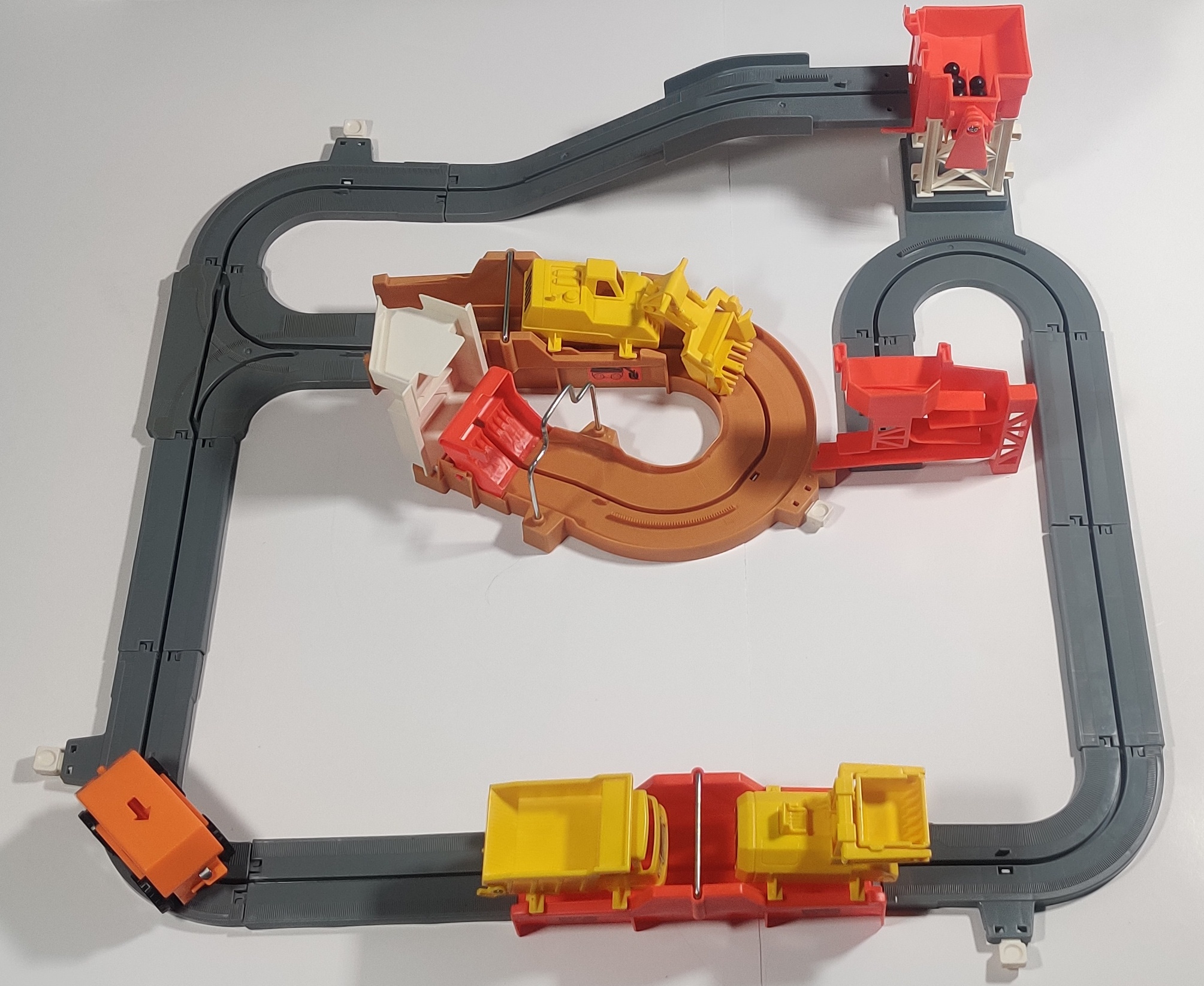
The rocks, vehicles, and chassis can really start in any valid normal configuration and start the cycle anywhere, but the suggested starting configuration is with the rocks starting in the hopper and the chassis starting heading forward away from the switch towards the dump truck. This is the state where the chassis is in forward gear and heading away from the bottom branch of the switch. In a regular loop the chassis would be carrying the dump truck facing away from the switch, as the loader will soon be. The reverser bar is currently hanging to the outside.
In the GIFs below, the reversers are indicated in blue and are either permanent reversers or are checking for interaction at the buttons. When the truck passes a reverser, it will go grey if the reversing lever is not in the correct orientation to interact with it, green if the reverser causes the chassis to return, or red if the reverser is not triggered (in the case of the button reversers). (There is actually an unlabeled static reverser in the layout because it is never interacted with under normal circumstances as it is really a byproduct of Big Loader being a manufactured toy that comes out of a series of shared molds. Can you spot it? Under what conditions can it be hit?)

The chassis heads under the truck and picks up the scoop loader and heads over to the hopper. Actions that are taken down these branches are determined when the set is put together - really, when it is designed - and the "control program" offers limited human interaction at the reverser buttons. The hopper's chute is designed in such a way that when the scoop loader heads past in the forward direction it allows some rocks to spill out into its bucket, but when heading back in the reverse direction no rocks are released (in fact, the door is designed in such a way that it jostles the rocks slightly to get more in position for the next run on the way out). The scoop takes the rocks to a delivery chute and dumps them out where they cycle back and forth a few times before being dumped into the loading dock. The scoop loader then heads back towards the dump truck interchange. The reverser switch on the curve rail before the interchange can be used to trigger the chassis to begin going forward again and collect another load of rocks from the chute and deliver them to the loading dock before heading back again, or it can be hit before the chassis ever reaches the switch to make it skip picking up rocks altogether.

After swapping to the dump truck, the chassis, currently in reverse, is guided by the switch track to the loading dock, now in the state of reversing away from the switch. A rack in the interchange helps the chassis smoothly transition out of the switch and into the skip loader vehicle body (which sits backwards on the chassis), engaging with the peg on the rear of the chassis. The skip loader's scoop rides in the track slot and is guided around the loading dock to collect the rocks and scoop them up a weighted ramp to a chute that loads them into the stationary dump truck body. A long rack keeps the loader running slowly while scooping up the small rock balls. The chassis hits a reverser switch and heads back across the rack, now technically in forward gear and heading back towards the switch. A button on the loading docks can be pressed to put the chassis back in reverse so the skip loader tries to load any straggling rocks into the chute, or to make the chassis skip loading any rocks at all.

The chassis then heads back to the loading dock interchange to pick up the loaded dump truck, now in forward. The switch now sends the dump truck out the top of the switch towards the incline up to the top of the hopper, but first it needs to somehow get the dump truck's bed to actually be facing the right way to drop off the rocks. Up until now it has taken the "long" path on two of the three branches and "done" something but the chassis is now aligned to hit the three closer permanent short reversers in its path down its next three branch traversals. When the truck approaches the curve at the base of the hill in forward gear, it reverses back towards the switch and heads down the bottom branch in reverse. It then hits the reverser on the curve rail down there and heads back up towards the switch to head out towards the loading dock before getting reversed by the switch itself and heading out the top, dumper now facing the hopper and ready to unload, come down the switch in forward gear, and start the cycle over again.

Click for video with sound!
The operation of Big Loader is mesmerizing. Part of the attraction of the toy is the sound, the whirring motor and gears and clanking, sliding plastic and the rolling and dropping ball rocks. The video version of the longer cycle diagrammed above can be seen here.
Big Loader has been rereleased and expanded in many variations over the years. Big Loader is truly an ingenious toy, running off a simple can motor that drives a complex gear train with reverser that can navigate a variety of different tracks.
In America this toy was released under Tomy's own brand by Tomy Corp. of Long Beach, California. This initial version of Big Loader was also released in Japan in a similarly designed box and in the UK by Palitoy in a box very similar to the American style one a few years later. In Canada it was imported by Parker Brothers and in Australia it was sold by Toltoy. The most common Big Loader variation is different colors or designs of this original layout.
While writing this page, I was contacted by the author of this article which recounts some of the cultural impact the toy had in the west, being a hot seller whenever it was rereleased and regularly captivating viewers.
Big Loader (Japanese release) (1977)
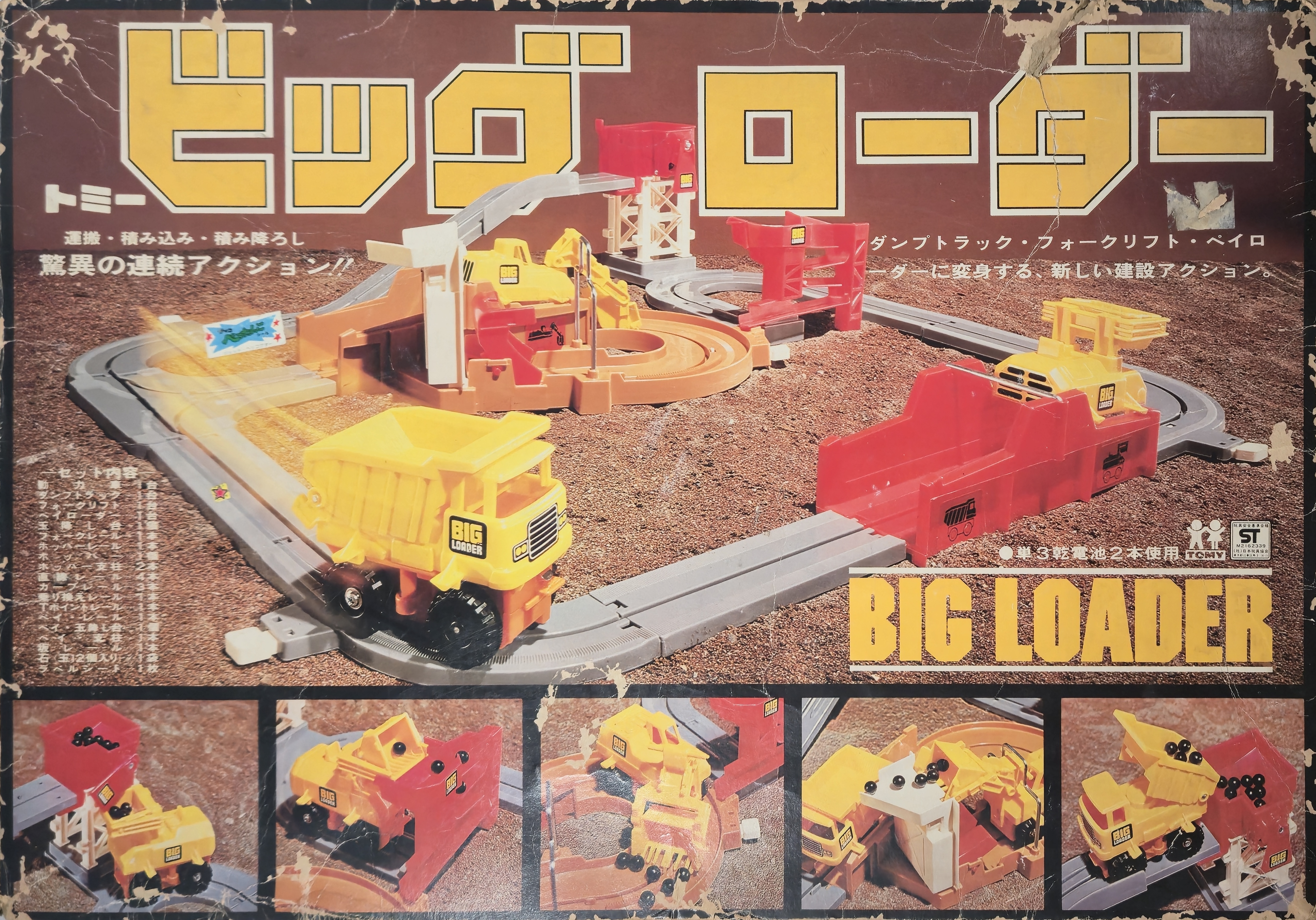
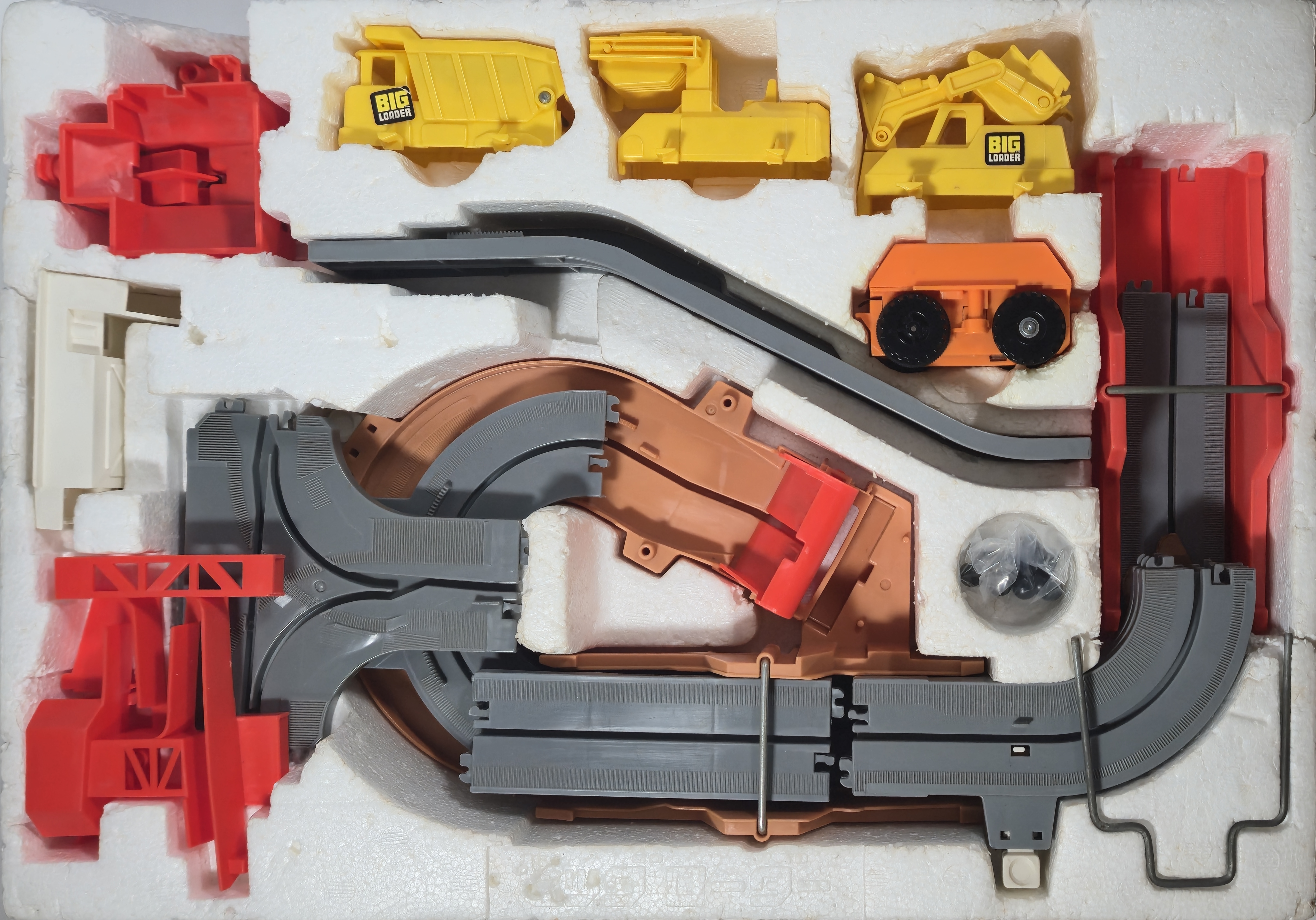
The first Japanese release of Big Loader (ビッグローダー) came in 1977 in this brown and yellow style of box similar to the American release. The box shows the slope track with just the inner guard rail, implying this box and release was put together slightly after the initial American release.



The box shows many scenes of the trucks in action. The N-26 mark implies the box was printed between March 1977 and 1978. It does seem that the Japanese patent was filed before the American one, but it seems to have been produced for the American market first.
Palitoy Big Loader (First Singapore production) (1979)
The Big Loader seems to have first reached the U.K. by way of Tomy's deal with Palitoy to import and market some of their toys to the U.K.. The initial Palitoy boxes are very similar to the American ones but with a Palitoy logo in the bottom right and a black Tomy "boy and girl" logo on the left. These sets were the first to be produced in Singapore and used the style of slope rail with no "outer" guard.
Big Loader (1980s Japanese production) (1980)
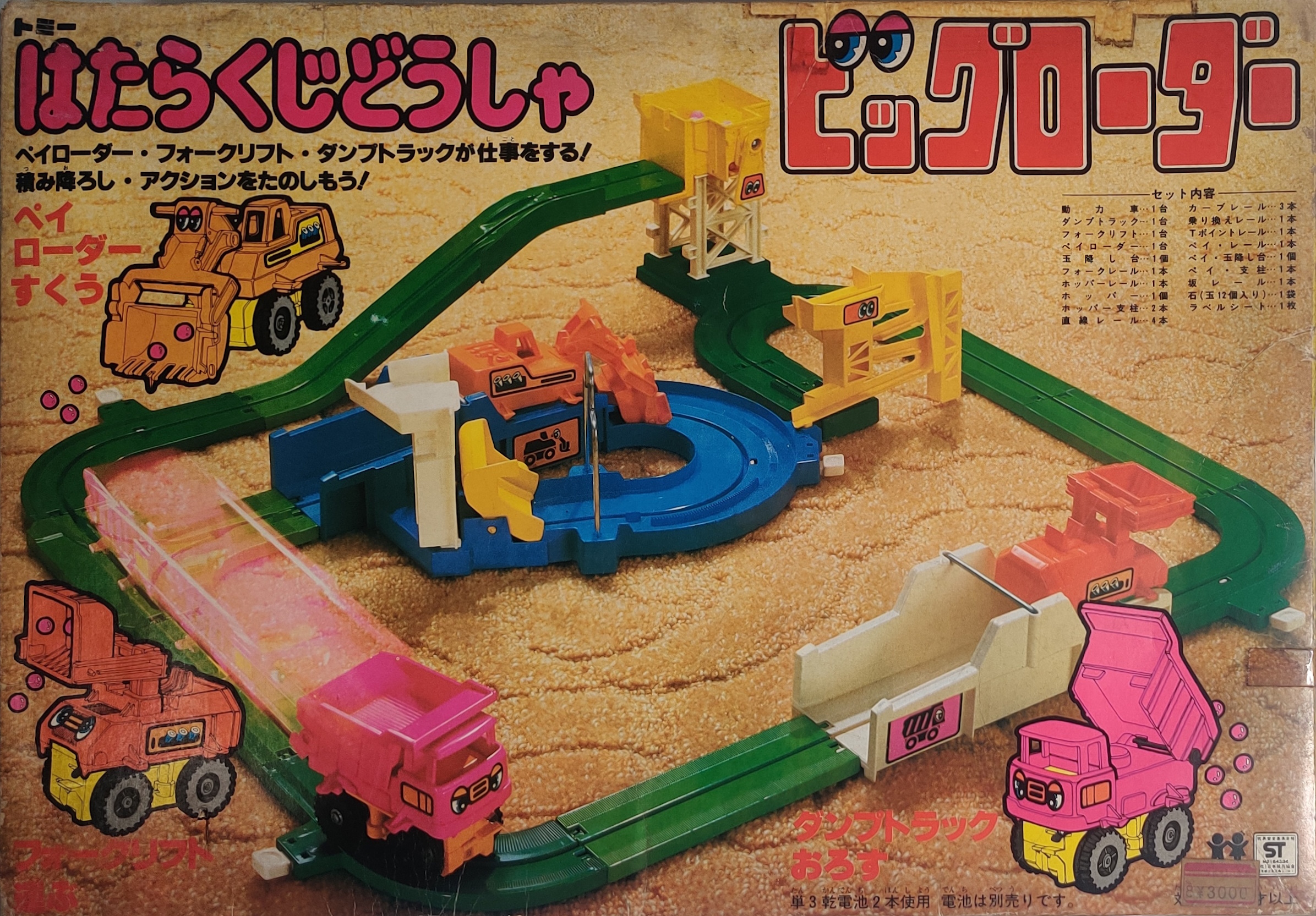
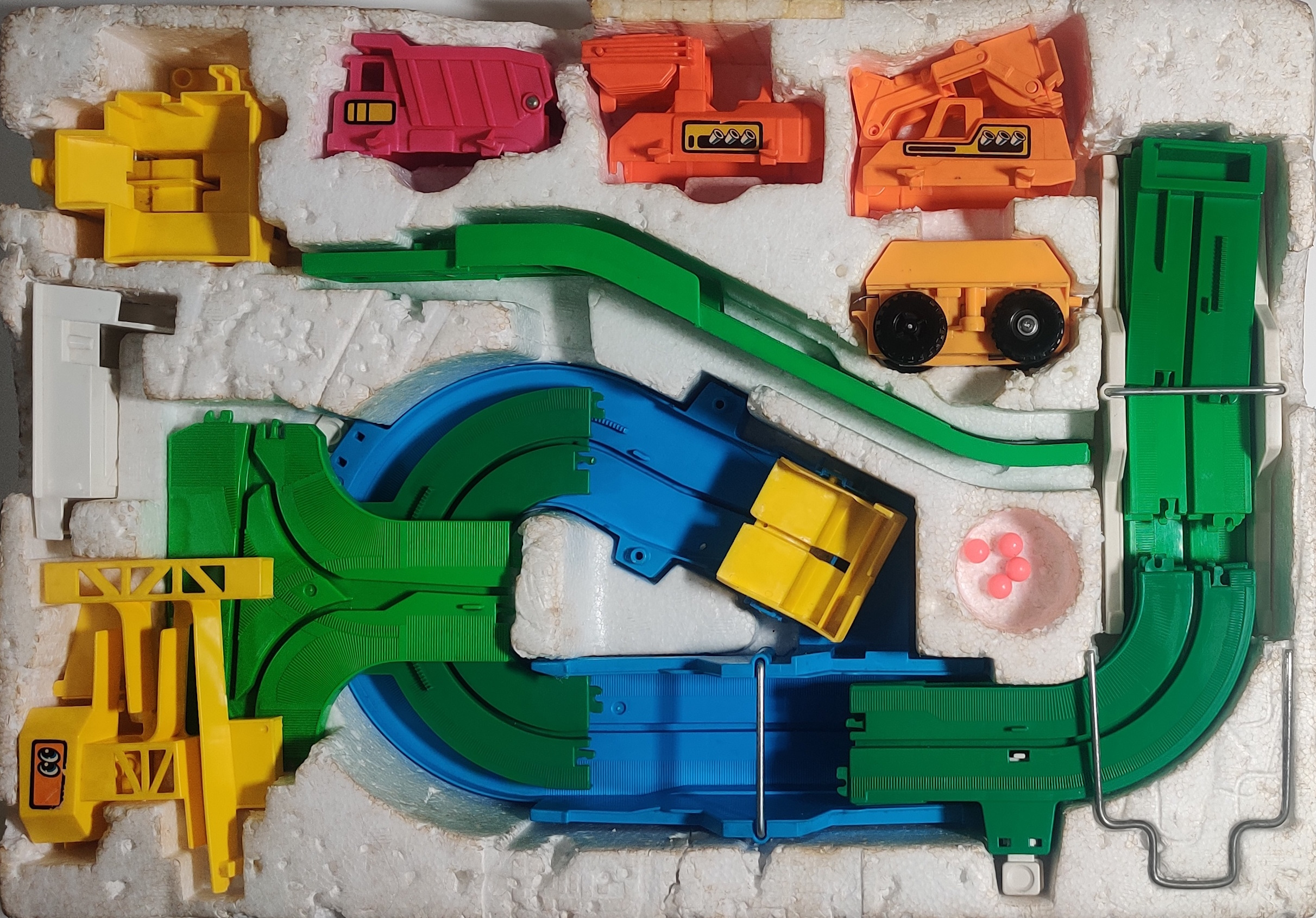
I quite like this Japanese Working Vehicle Big Loader (はたらくじどうしゃビッグローダー) set that seems to have first been released around 1980. This version has new colors for the Japanese market and is one of my favorite Big Loaders. I have seen this called "Pink Loader" a few places but I am not sure if this is entirely intentional - the characters ビッグ used for big are similar to the characters ピンク for pink but the text on the box appears to be stylized rather than trying to attempt a pun. The color scheme is certainly less "boyish" and Tomy may have been aiming at a more mixed market. I really like the multiple exposure shot used to do the motion effect on the front of the box - Tomy used to do these on boxes and I really like the effect.



The vehicles are interesting colors with stylized eyes and rather cool exhaust pipe stickers. Some of the other parts around the layout also have different stickers, and the whole set is made in different colors from the more traditional construction site design. The N-29 designation on the top panel of the box designates that the box was printed in 1980. The box actually shows a different design of slope rail used on earlier Japan and Singapore production Big Loaders.
Set contents
| Quantity |
Item |
Photo |
|---|---|---|
| 1 | Power chassis |
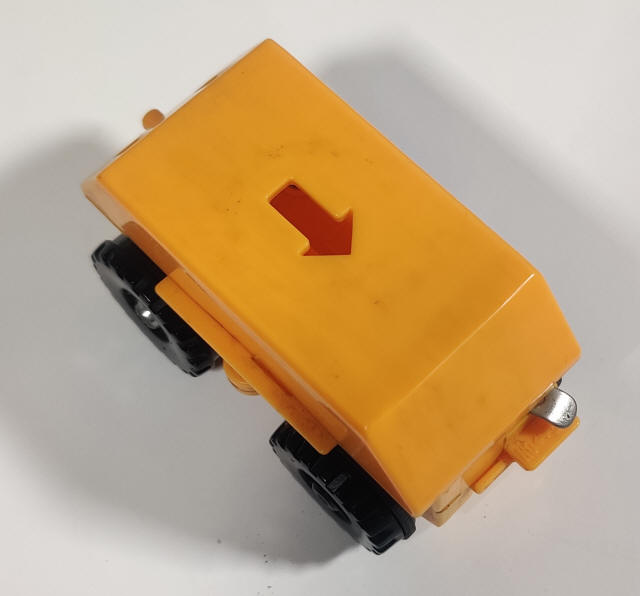 |
| 1 | Dump truck shell |
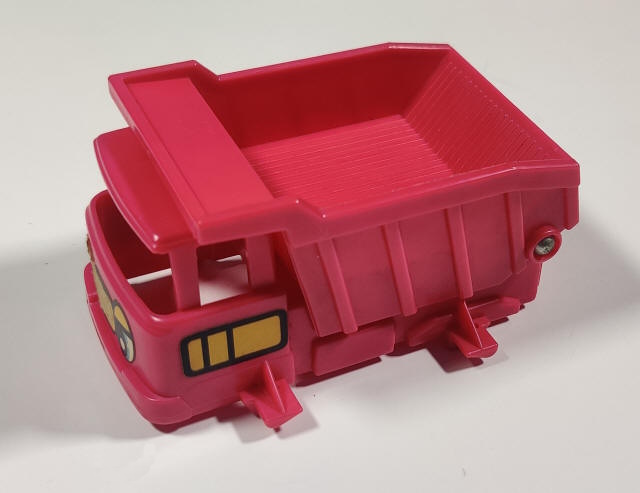 |
| 1 | Forklift shell |
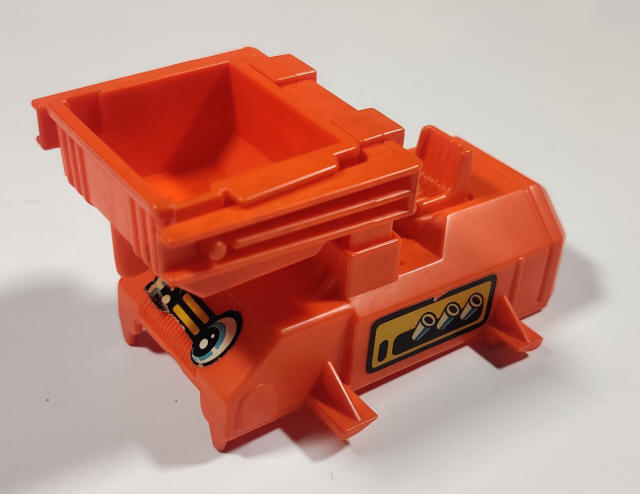 |
| 1 | Payloader shell |
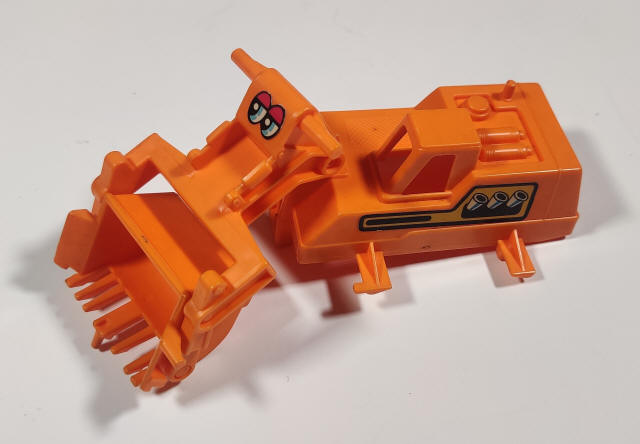 |
| 4 | Straight track |
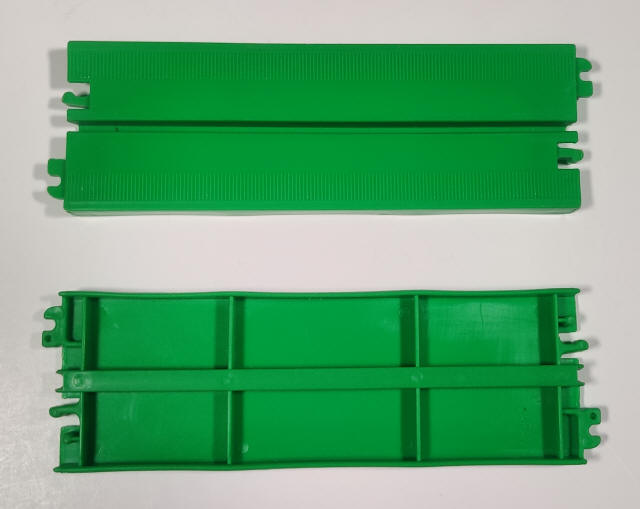 |
| 3 | Curve track |
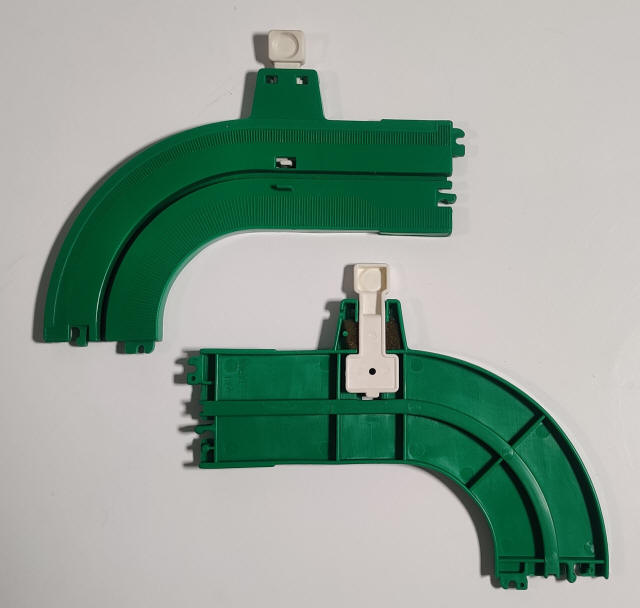 |
| 1 | Switch track |
 |
| 1 | Hopper track |
 |
| 1 | Short track |
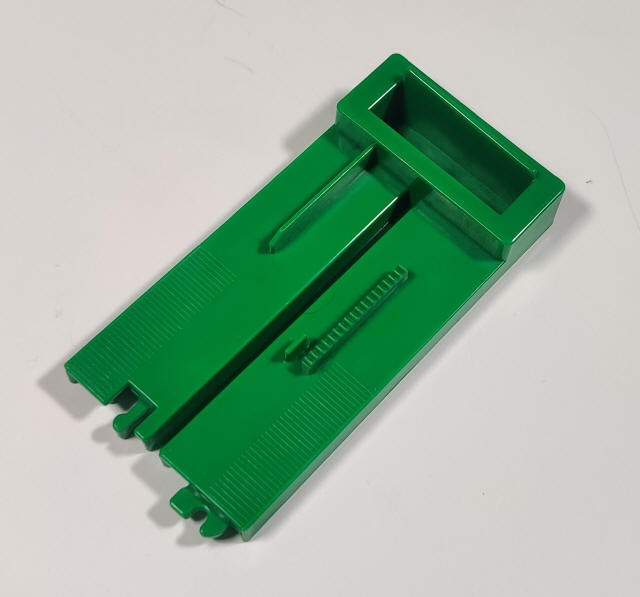 |
| 1 | Ramp track |
 |
| 1 | Transfer ramp |
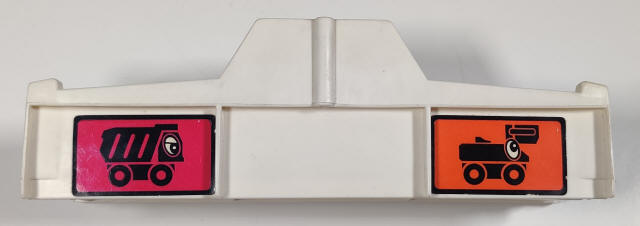 |
| 1 | Loading dock |
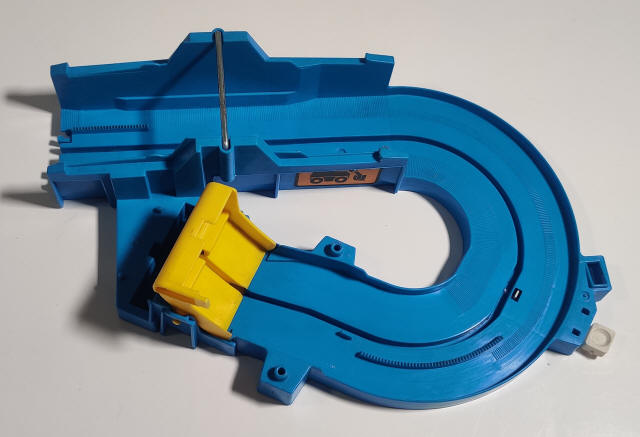 |
| 1 | Loader gate |
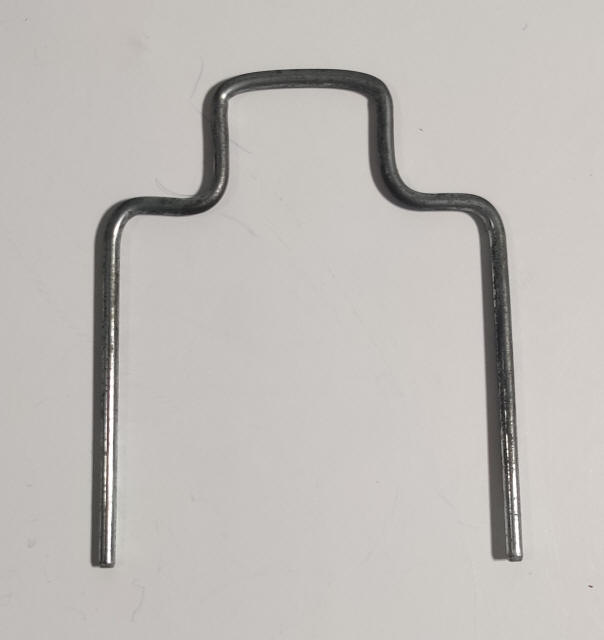 |
| 1 | Loading trough |
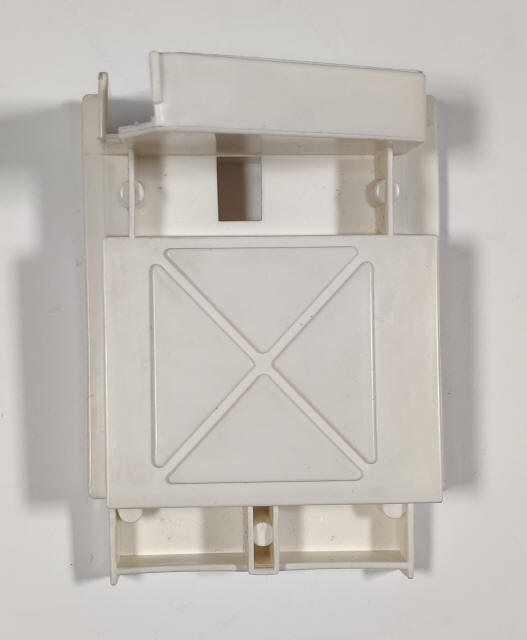 |
| 1 | Hopper |
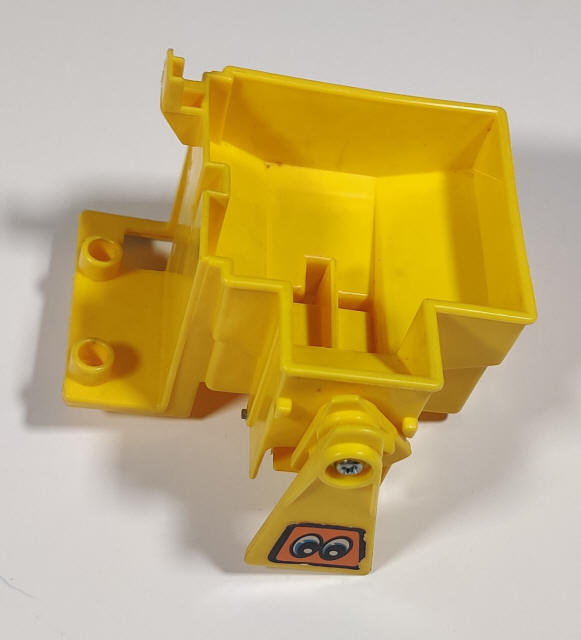 |
| 2 | Hopper supports |
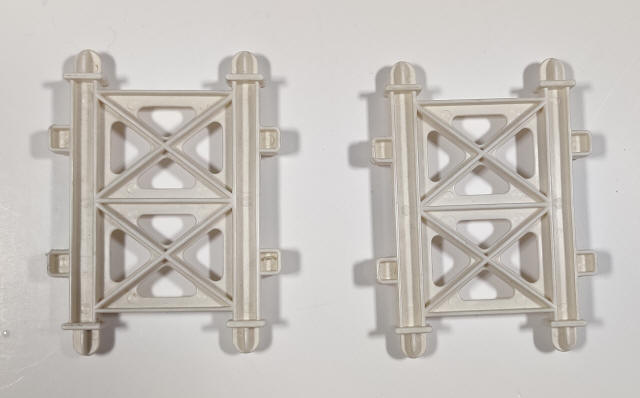 |
| 1 | Delivery chute |
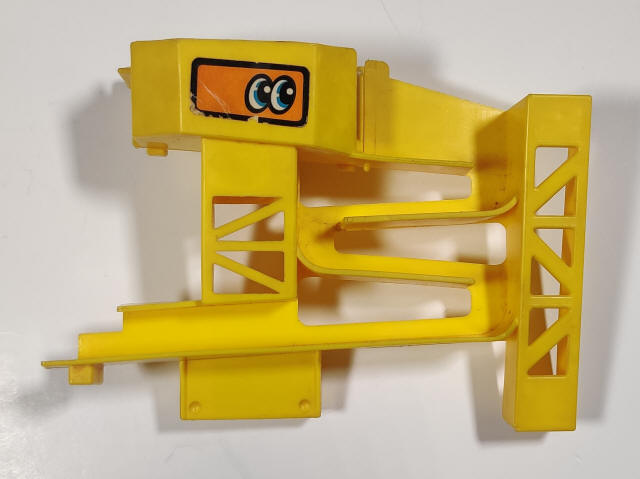 |
| 12 | "Rocks" |
 |
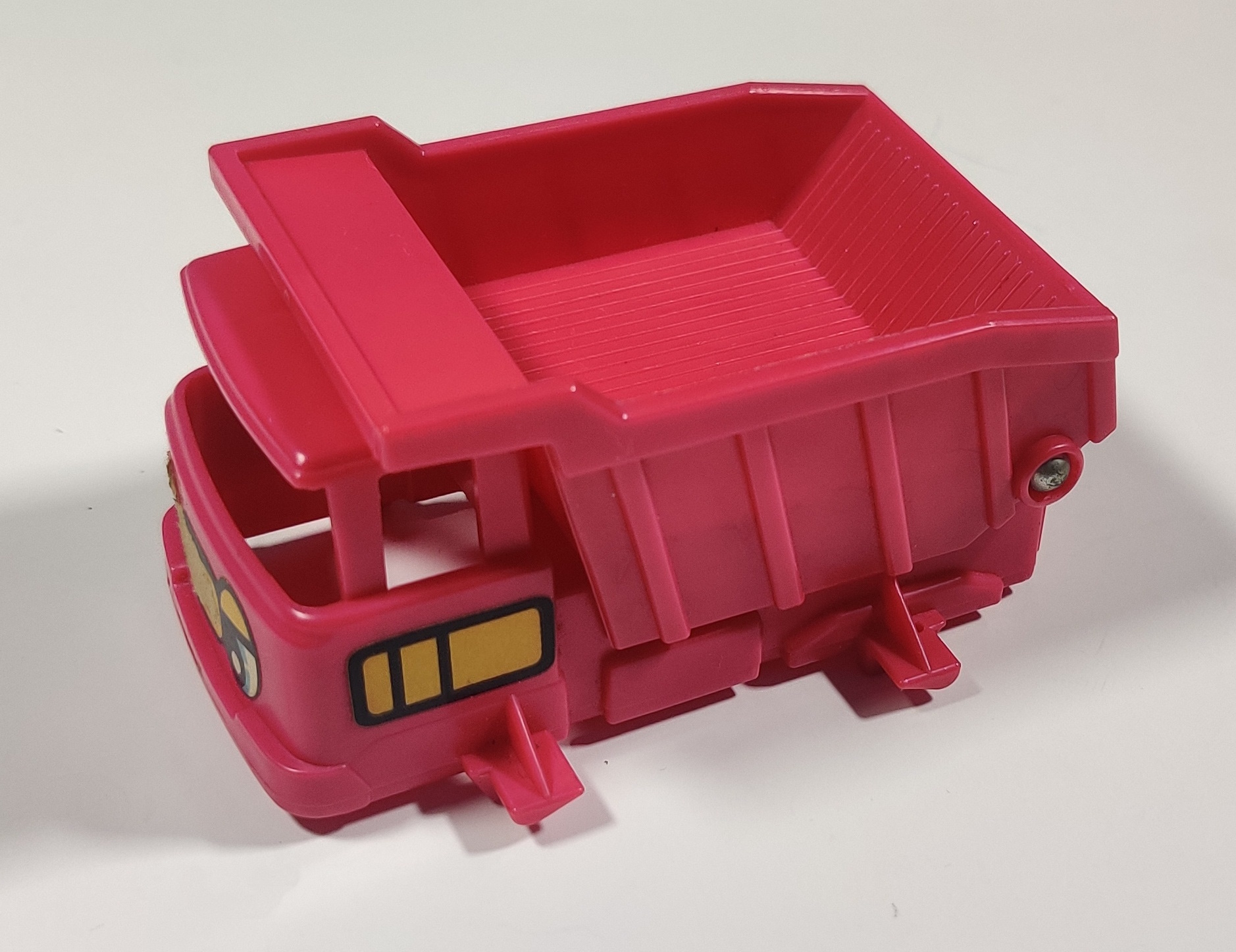
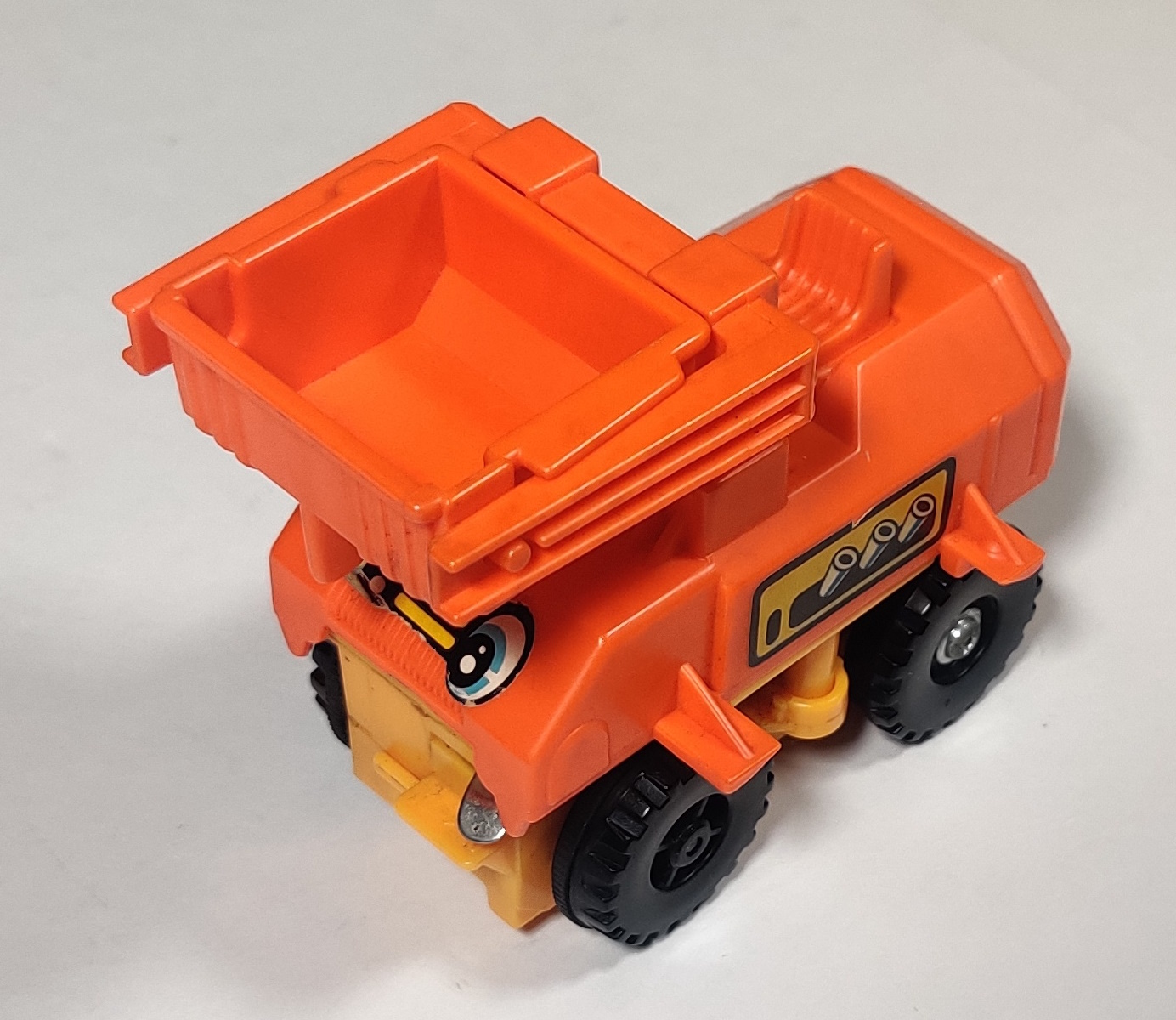
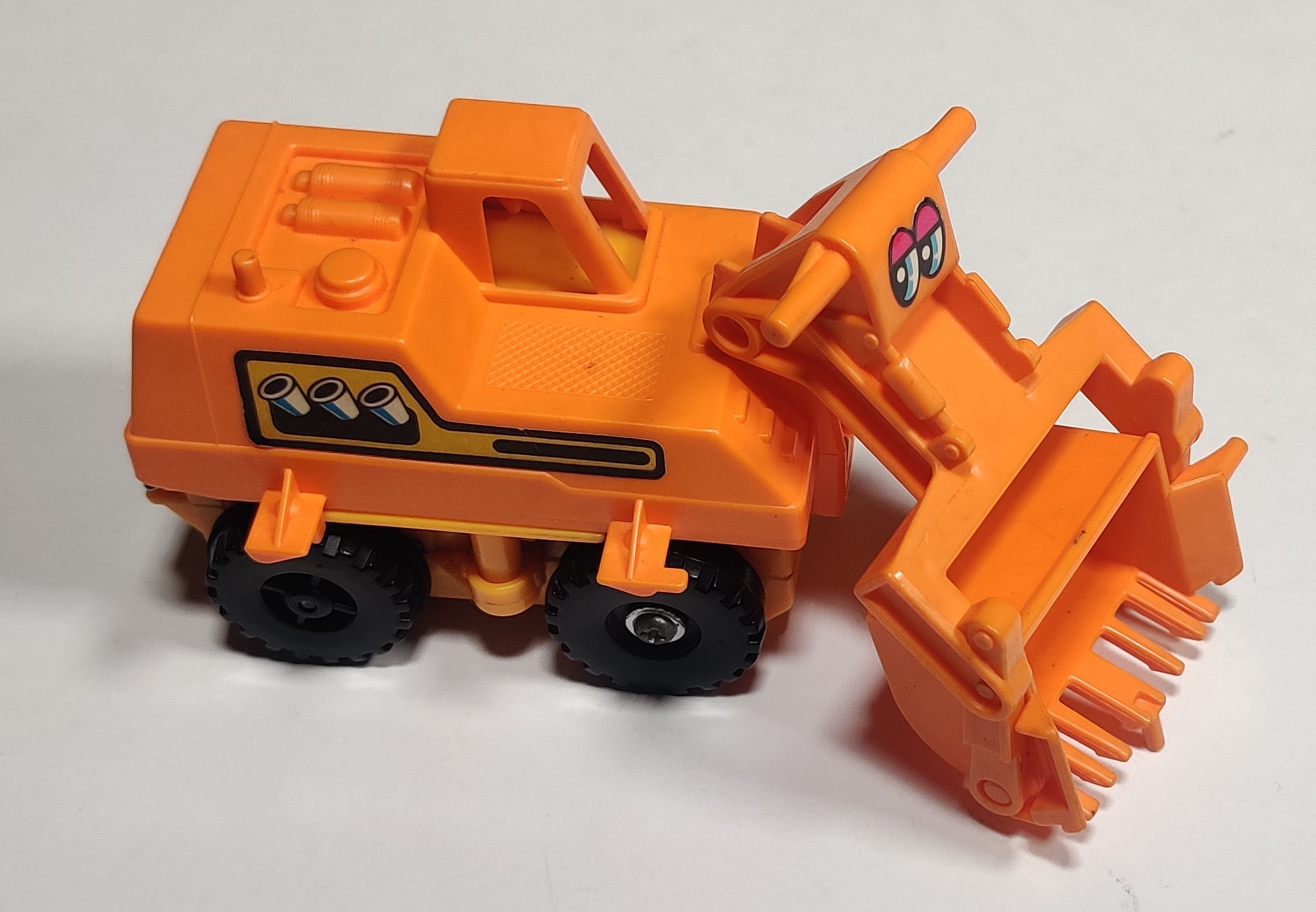
This version of the Big Loader uses three brightly-colored tops which the box refers to as the dump truck, forklift, and payloader. The three little trucks have sort-of funny eyes and coolly-styled exhaust pipe stickers. The hopper and chute also have eye stickers applied.

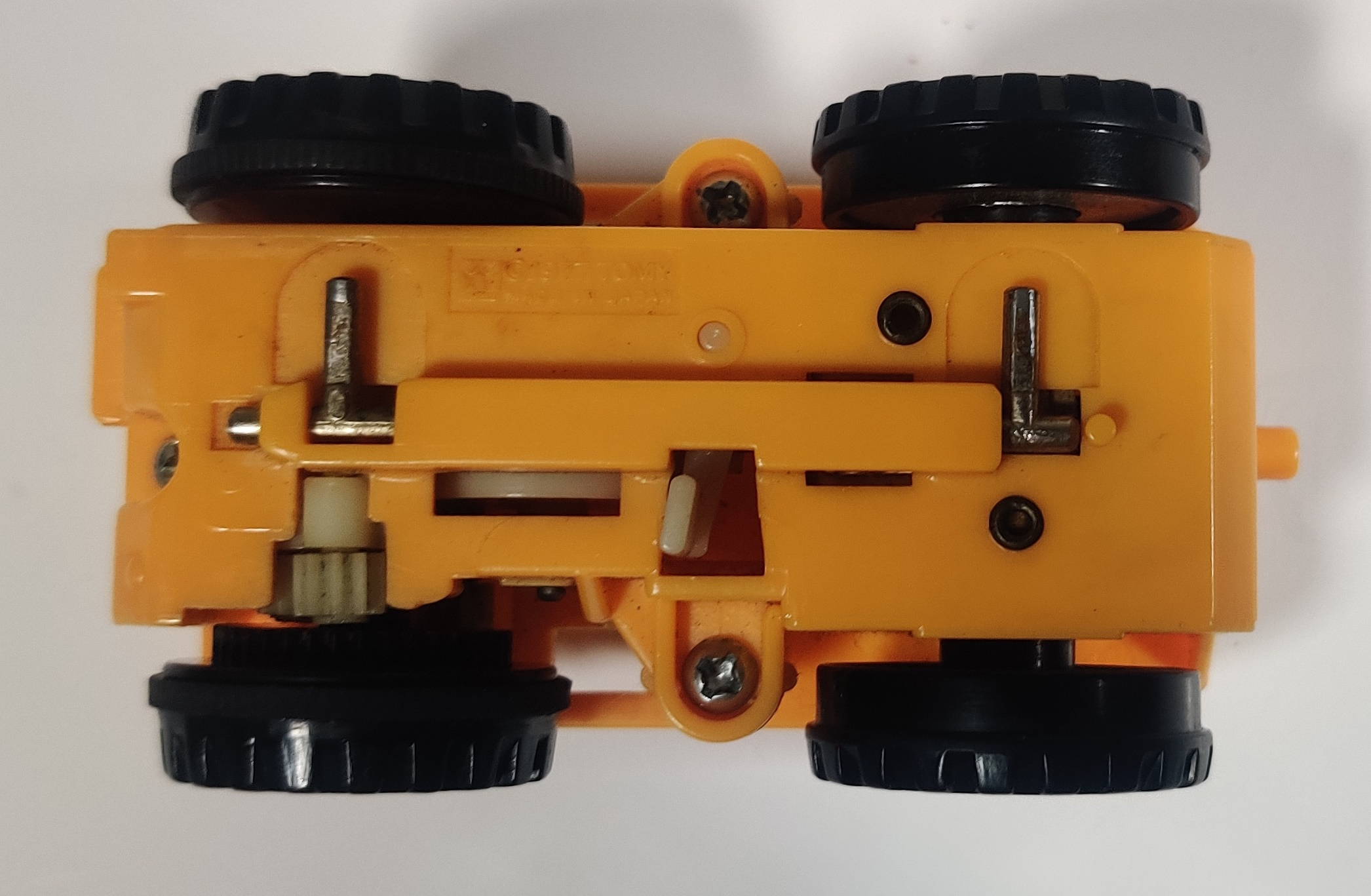
The chassis in this one is a lighter, perhaps less red orange than the original American version but otherwise has the same battery compartment layout and chassis design, including the 1977 Tomy Japan mark.
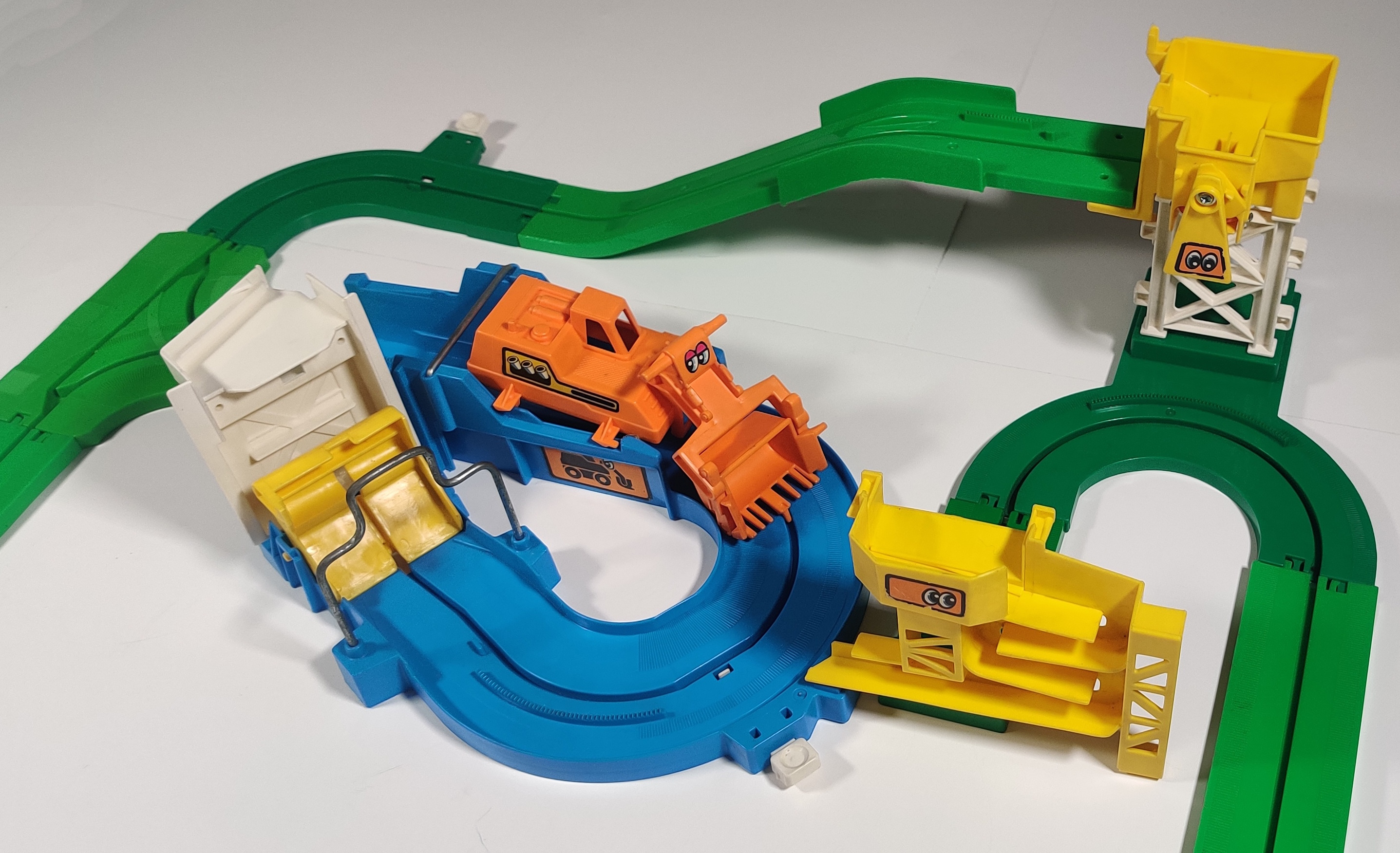

The colors on this release are quite nice and I really like the aesthetic. The operation is, of course, otherwise the same as other "standard" Big Loaders, with the forklift delivering rocks to the chute and loading bay where the payloader scoops and lifts them into the dump truck which dumps them back in the hopper. This style of Big Loader was one of the first produced in Tomy's Thailand factory in 1988.

The dump truck in my copy of this set has a torn sticker - here is the set running with the Thailand-made truck from the set shown below.
Little Loader (Singapore production) (1983)
In 1983 an American market set called the Little Loader was released in the woodgrain boarder style packaging Tomy used in the later 1970s (although not for the original American Big Loader). These sets were produced in Singapore like the earlier U.K. market Palitoy sets and have a brown track layout and new stickers. Although seemingly mostly identical to the UK release other than plastic color, this does appear to be the first version to use plastic separator bars on the interchanges as a cost-saving measure - the bulldozer (as this version calls the skip loader, which is what this version calls the "scoop loader" - this version makes more sense to me) still has a metal guide to scoop the rocks. The slope track only has one a guard on the inside of the track, with an added rail in the track surface to help align the chassis.
U.K. Big Loader (Taiwan production) (early-mid 1980s?)
At some point seemingly after their deal with Palitoy ended (Palitoy was restructured and functionally did not exist after the early 1980s) Tomy produced Big Loaders in nearly identical 1977 American-release style packaging but without any Tomy or other logos obviously on the box. These Big Loaders were seemingly based on the Singapore production style with single-guard ramp track and used plastic interchange separators but were produced in Taiwan, where Tomy had produced some other export versions of toys in the late 70s.
Tomy Preschool Big Loader (Singapore production) (1987)
Around 1987 the classic colorway Big Loader was repackaged in new white with red and blue grid Preschool Tomy packaging for the American market. At this point in time, Coleco owned the California-based Tomy Corp. and instructions were marked Coleco with the box saying that Tomy Corp. was a division of Coleco Industries. Early examples of Big Loaders in this packaging were later Singapore production types with two AA batter drive units, plastic interchange bars, and single-guard slopes. Later, this same style of packaging was used for the 1989 Thailand-made single AA battery American rerelease.
Big Loader (Early Thailand adaptation) (1988)
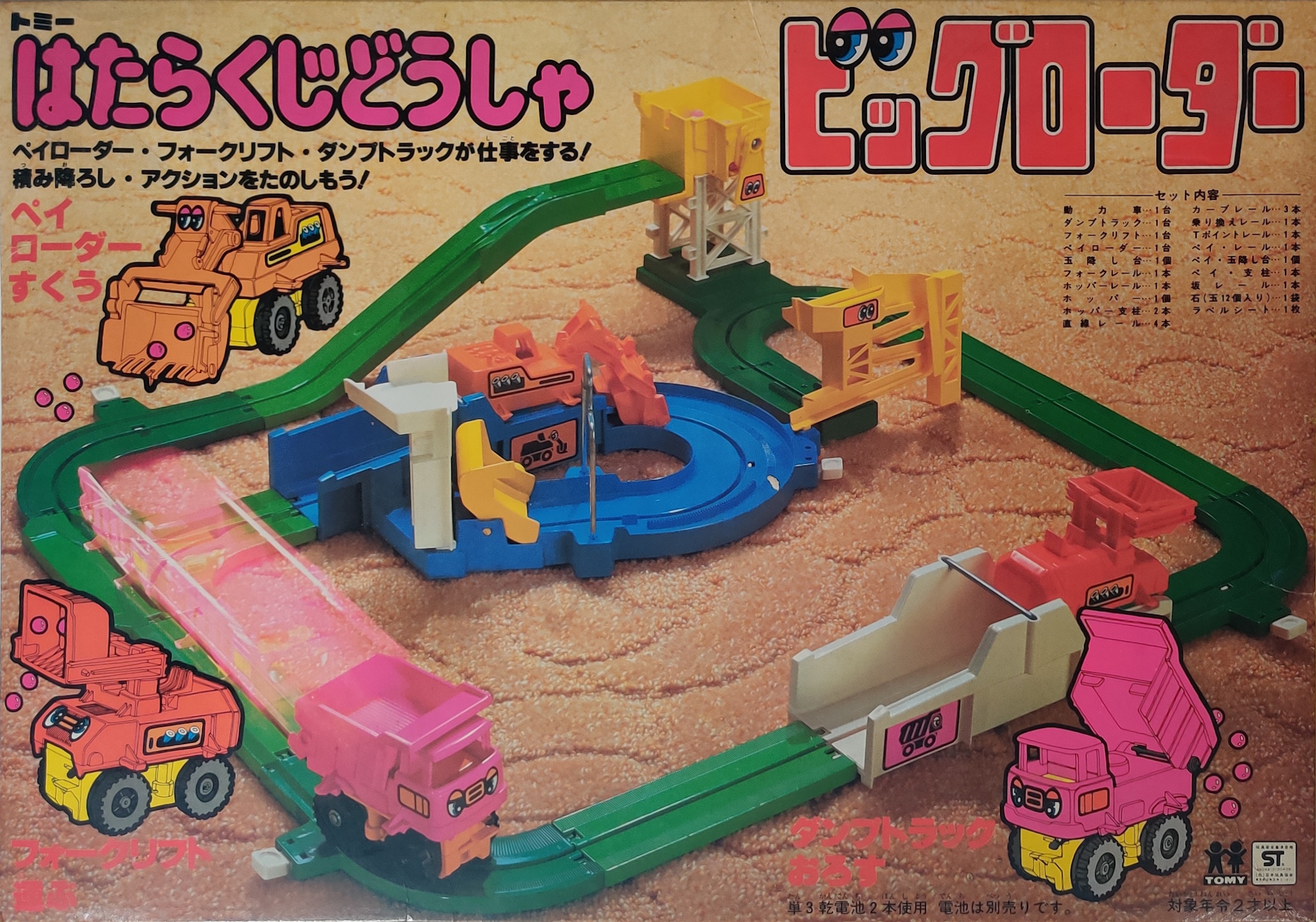
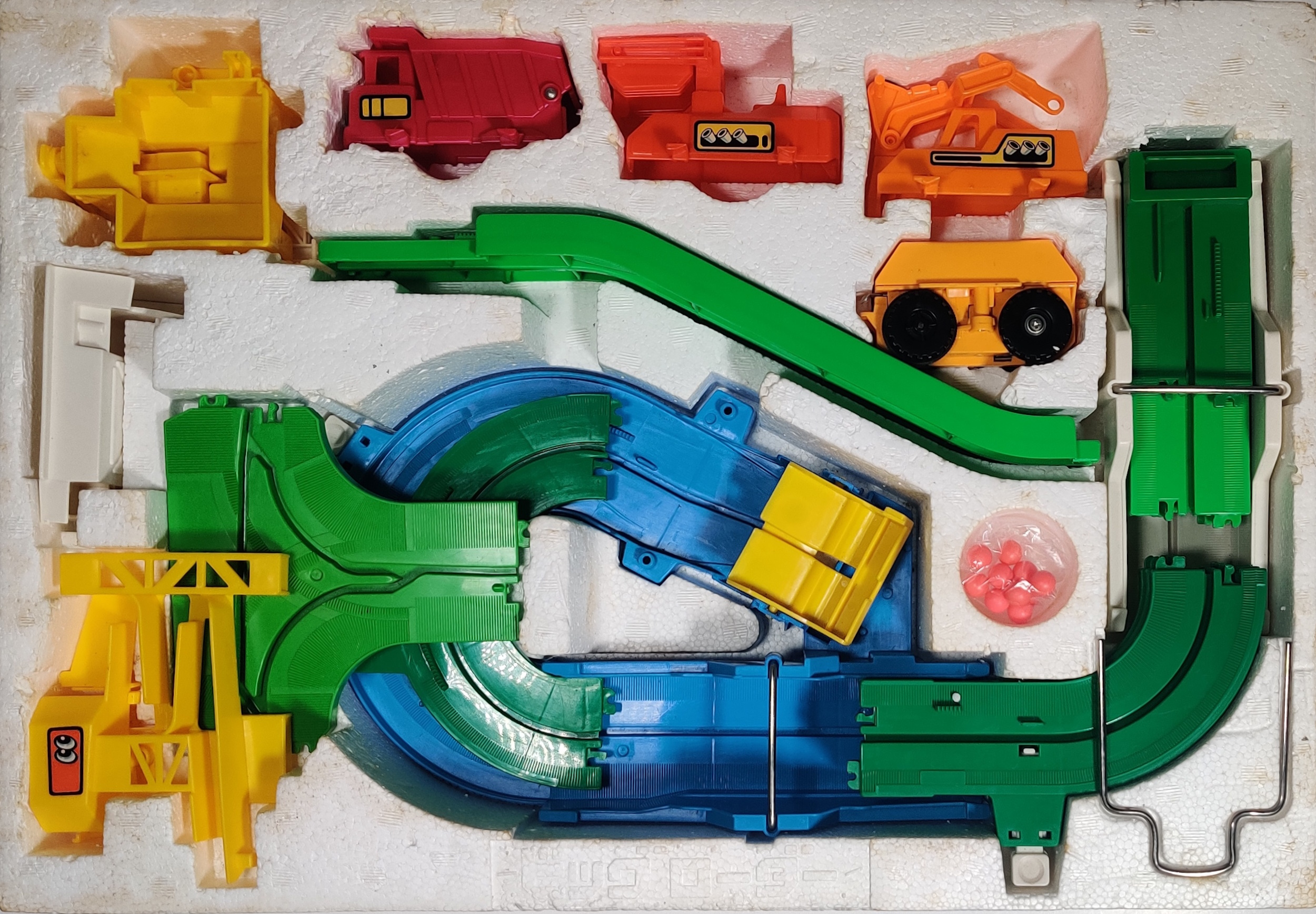
Circa 1988 production for the Japanese Working Vehicle Big Loader (はたらくじどうしゃビッグローダー) set shown above was moved to Tomy's new Thailand factory that opened in 1987. Production was nearly identical to the Japanese version of the set, with all-metal interchange and loading dock wire. Nearly the only changes from Japan production were a reinforced battery compartment and the fully-guarded slope rail.



The box design is almost entirely the same, although the ST mark and product numbering schemes have changed. The small 8 after the ST in the bottom right corner of the box indicates that it was printed in 1988.
Set contents
| Quantity |
Item |
Photo |
|---|---|---|
| 1 | Power chassis |
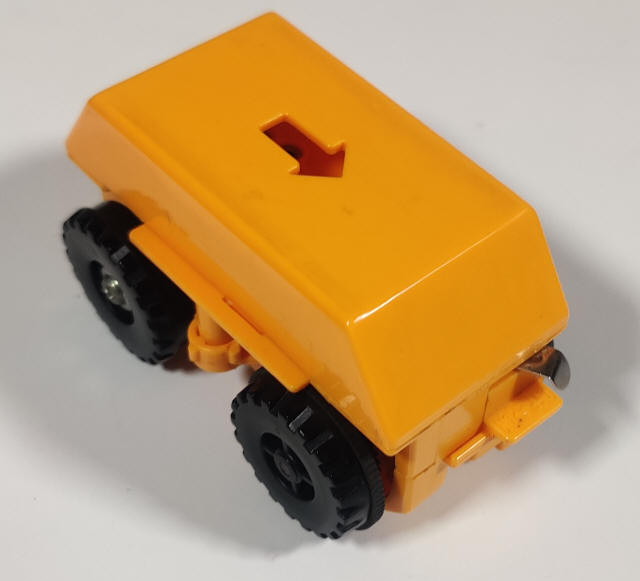 |
| 1 | Dump truck shell |
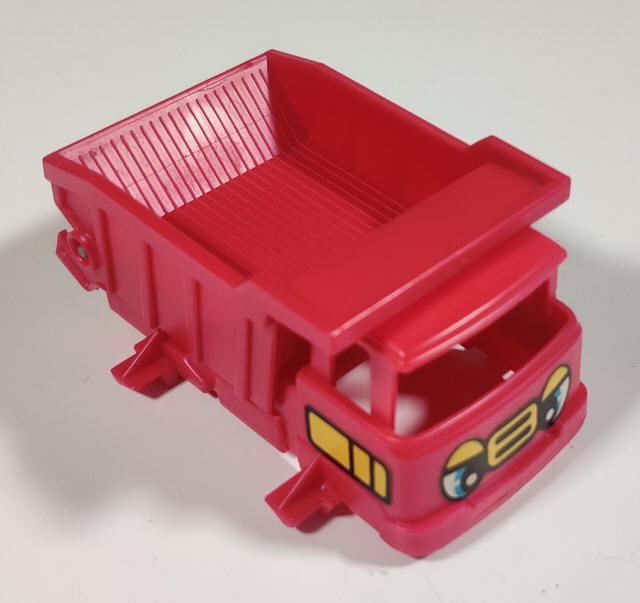
|
| 1 | Forklift shell |
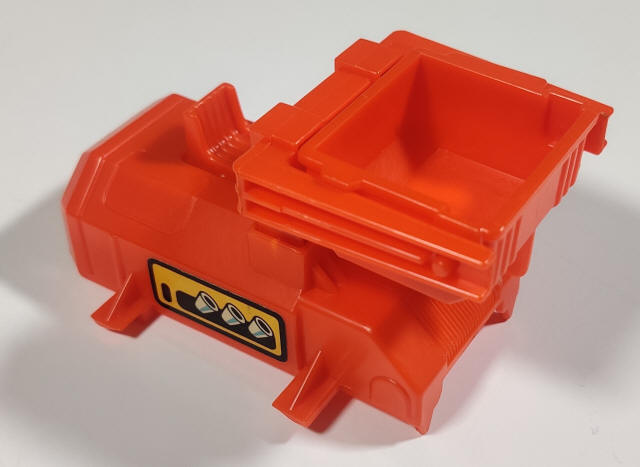 |
| 1 | Payloader shell |
 |
| 4 | Straight track |
 |
| 3 | Curve track |
 |
| 1 | Switch track |
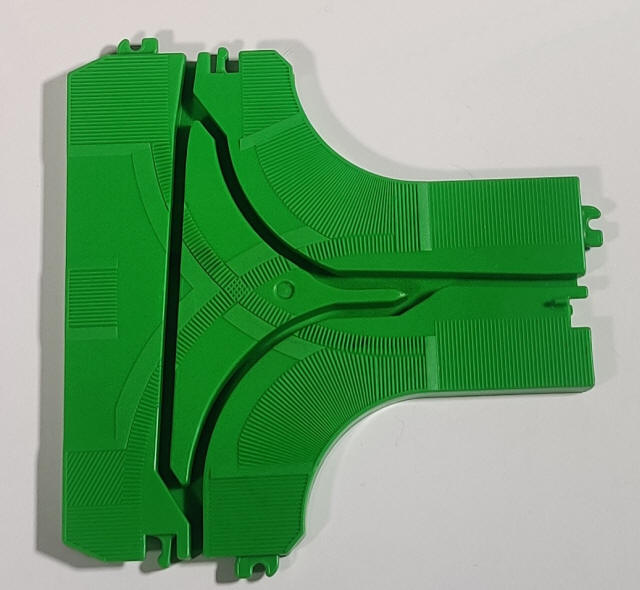 |
| 1 | Hopper track |
 |
| 1 | Short track |
 |
| 1 | Ramp track |
 |
| 1 | Transfer ramp |
 |
| 1 | Loading dock |
 |
| 1 | Loader gate |
 |
| 1 | Loading trough |
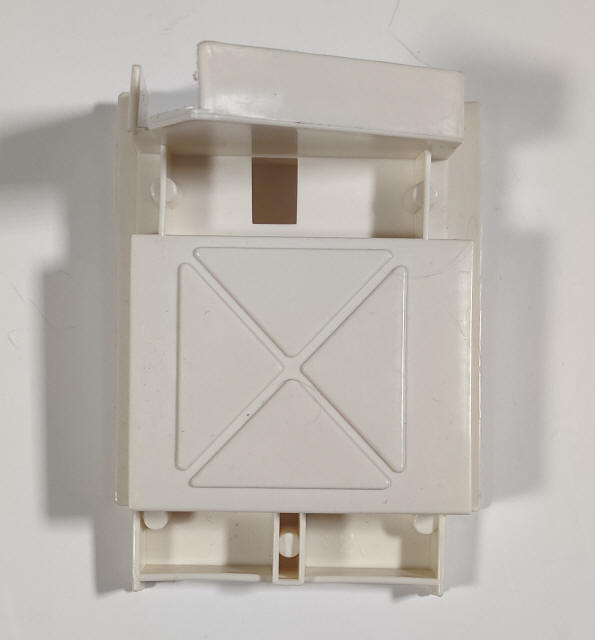 |
| 1 | Hopper |
 |
| 2 | Hopper supports |
 |
| 1 | Delivery chute |
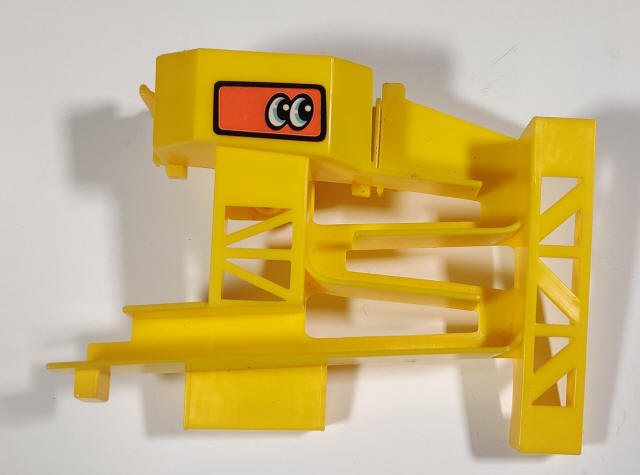 |
| 12 | "Rocks" |
 |
The forklift in my copy of this set is missing its eye stickers, and the payloader is missing its scoop. Between this set and the Japanese one shown above, I luckily have a complete set (actually, I did not even notice I was buying two slight variations when I bought the two sets, I just wanted at least one nice copy of the set and as sometimes happens I managed to stumble across a variation).
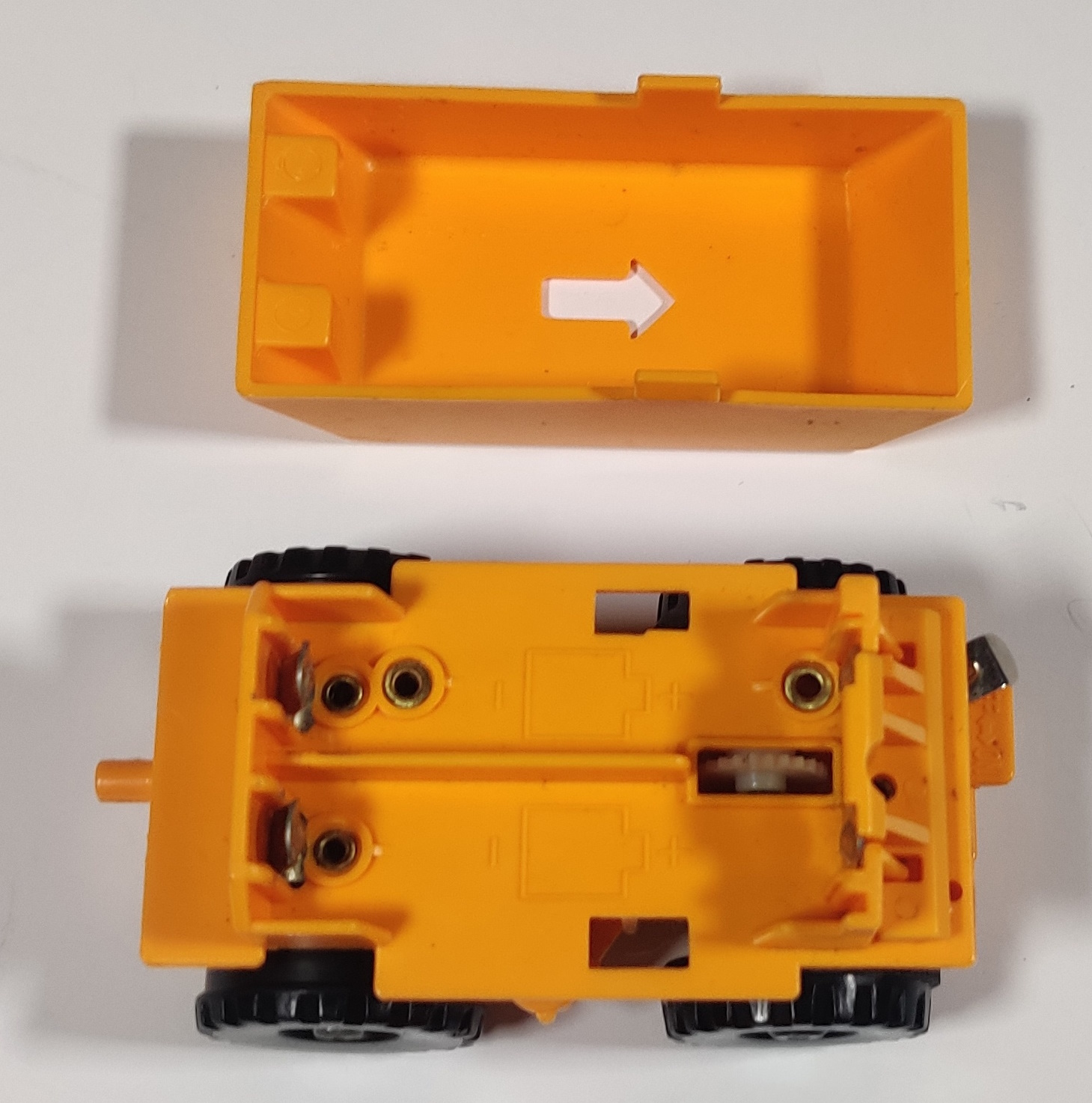
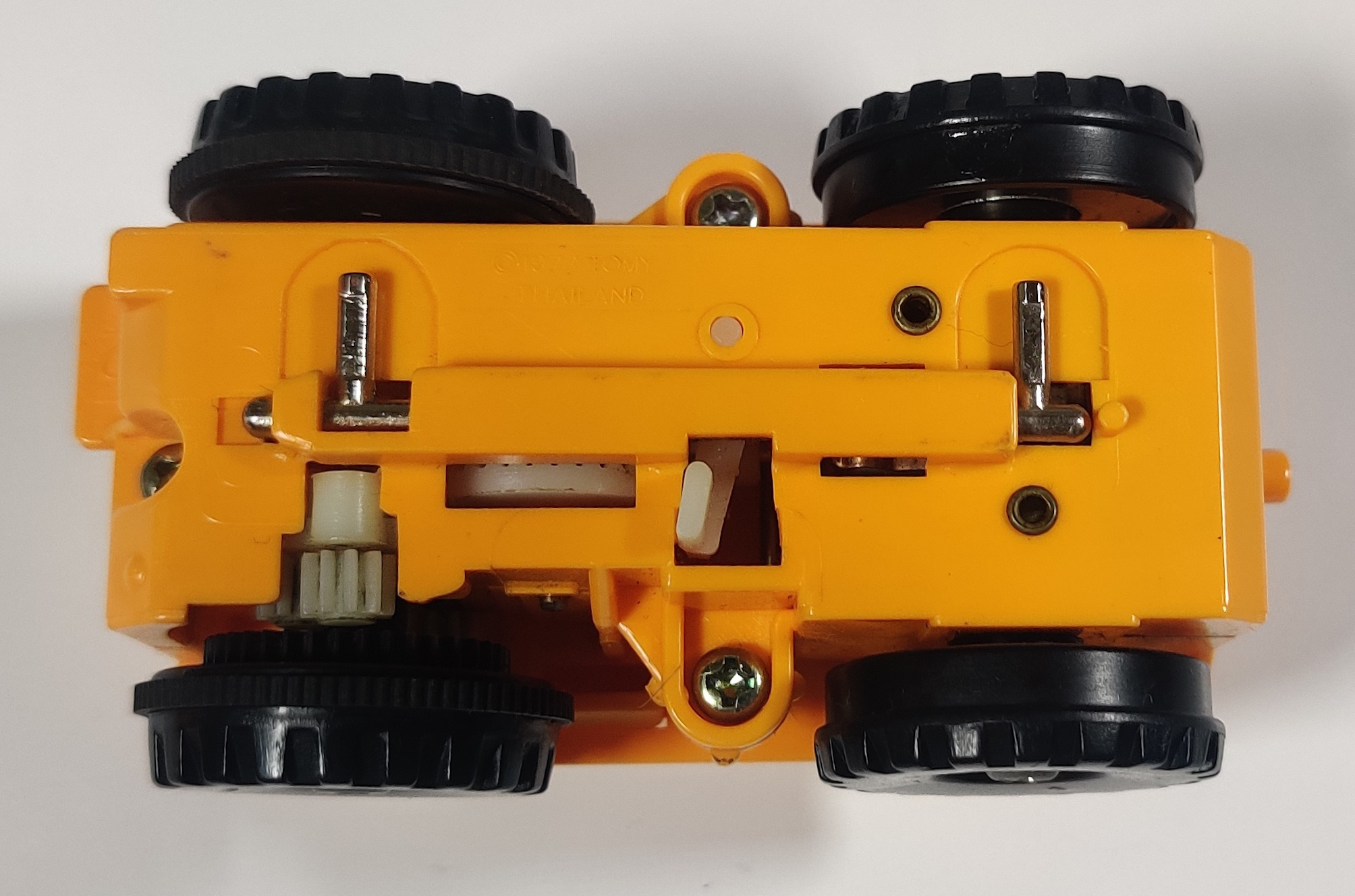
This early Thailand-made chassis uses a reinforced two AA system - later chassis would use a single AA.
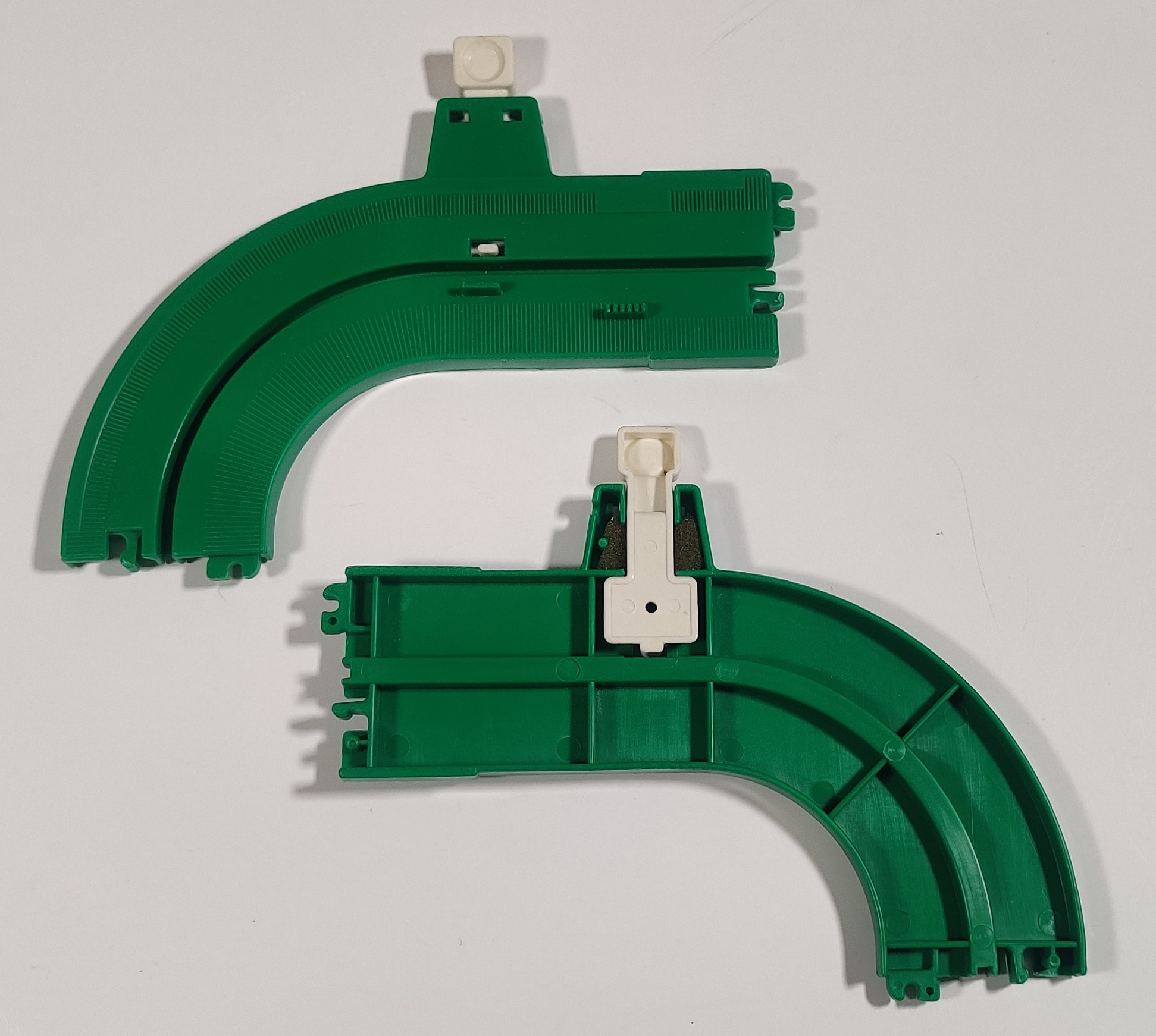
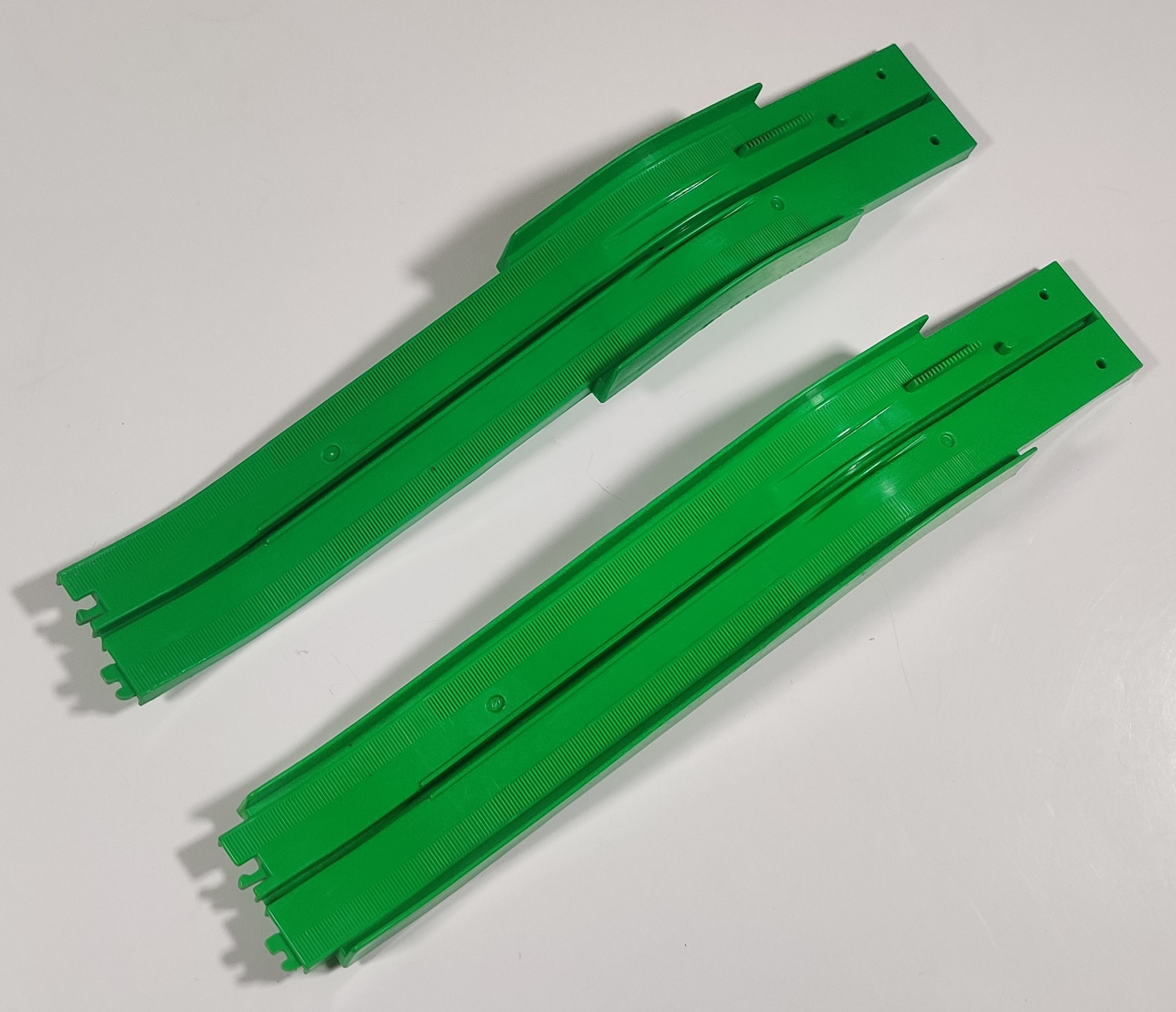
The curve track in this set has short rack sections added that slow the truck down when it enters from the longer straight side and is lined up to hit the static reverser - this slows the truck down as it approaches the reversing bump when travelling forward towards the curve before the ramp in the upper branch and when travelling backwards towards the first curve in the lower branch. The ramp track now has guards that extend the entire way down - I found the Big Loader chassis to be surprisingly spritely even with age and different chassis would occasionally tumble down various slope tracks.
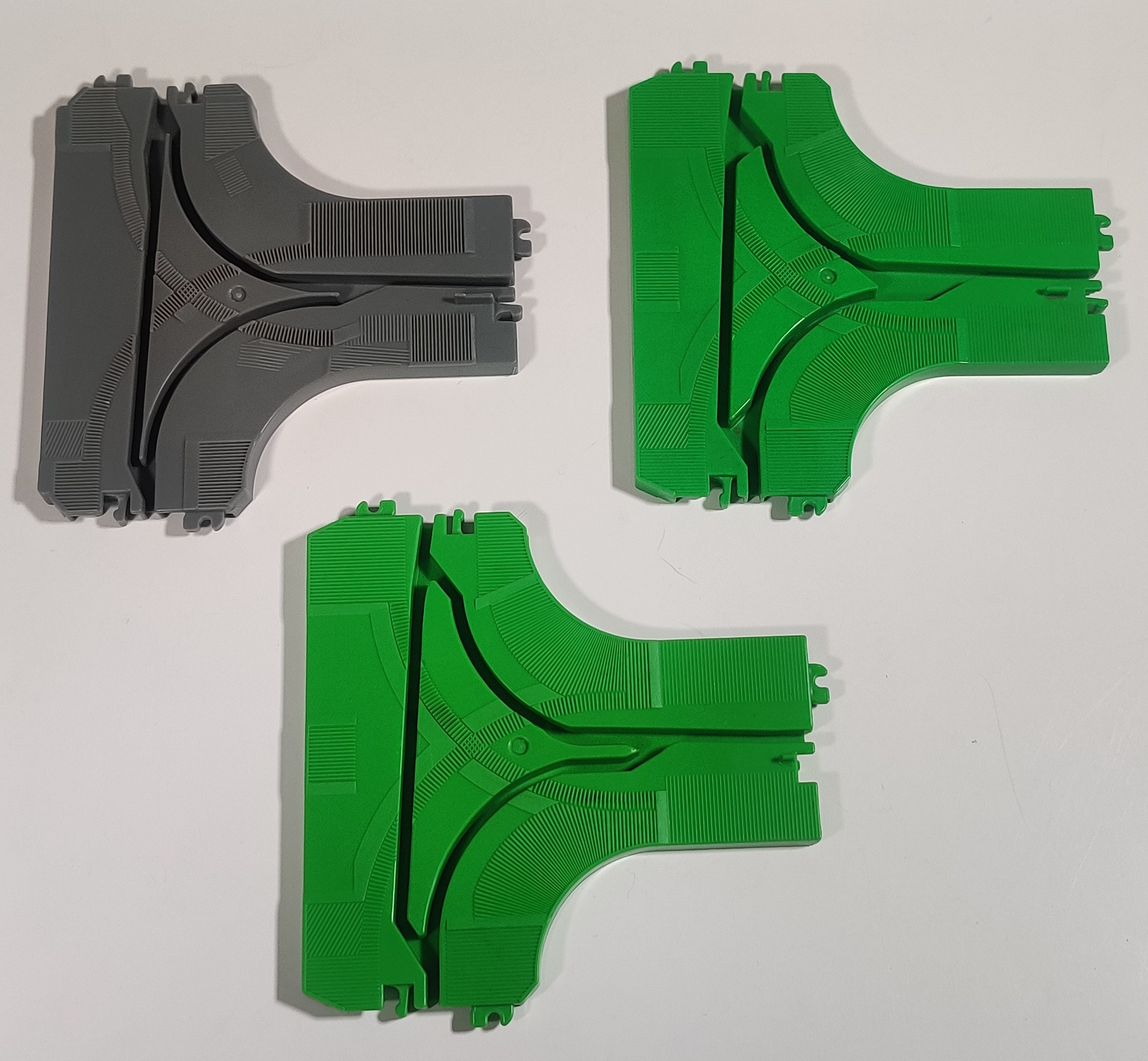

The switch track is another piece that saw some advancement, with redesigned tread and guide patterns. Pictured here is the original design, the circa 1980 Japanese version, and the 1988 initial Thailand version that future releases were based on. The Singapore version used an odd design with an open cutout. JAPAN marks on most components were removed while specific Tomy made in Japan marks were changed to Thailand.
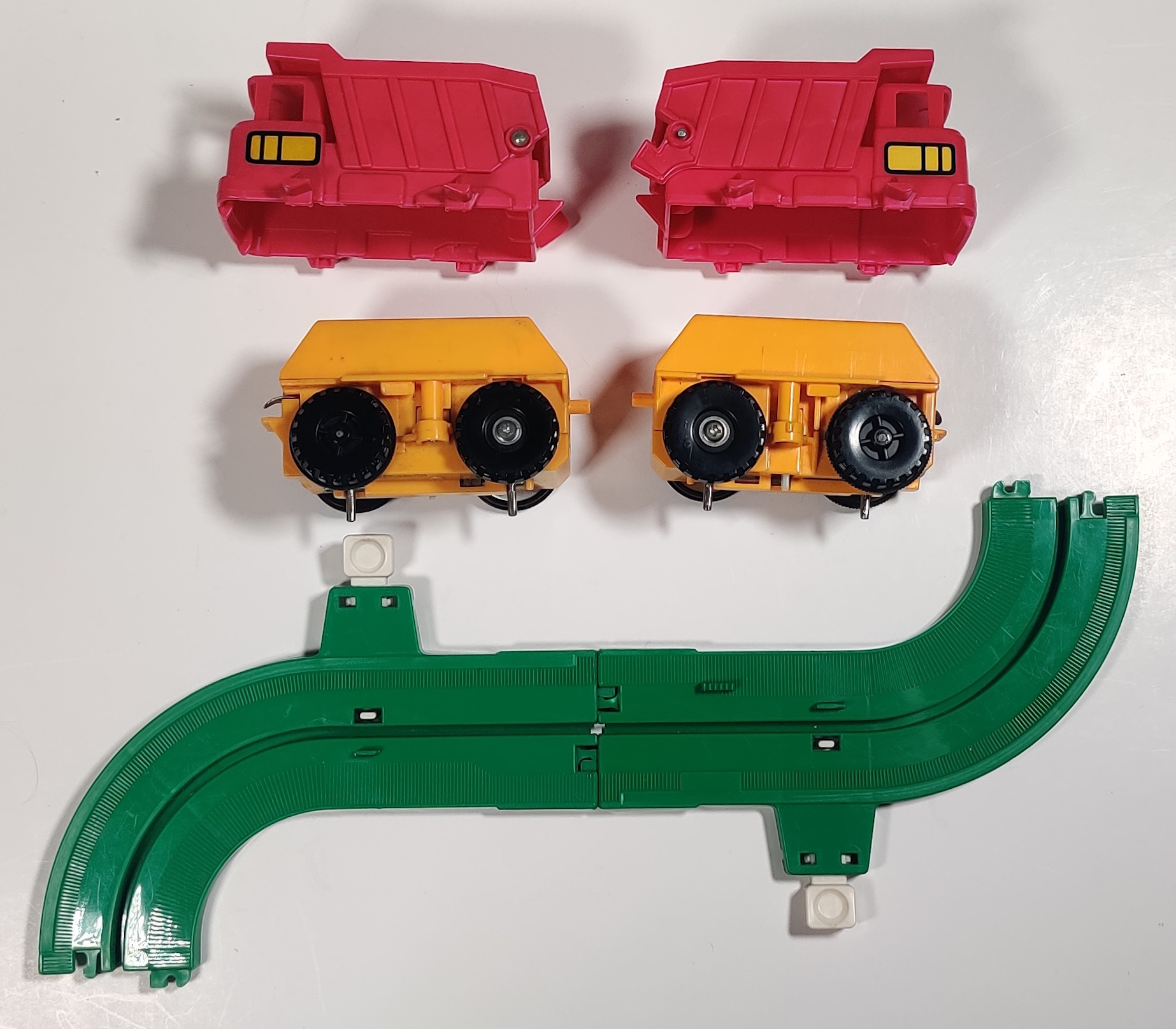

Some components of the set are slightly different colors, probably due to changes in the exact production or material process (or even just age or storage conditions - I can tell that both of the dump trucks look "burnt" darker on top). Japan-made components are on the left, with Thailand ones on the right.

You can just about see where the truck slows down to reverse when making its three-point turn.
Big Loader (Thailand AA rerelease) (1989)
In 1989 the American Big Loader in original colors with lighter stickers in the white with red and blue grid Preschool TOMY packaging moved production to Thailand and was distributed under Tomy's new American offices. This version uses the new single AA battery chassis but still the metal interchange bars.
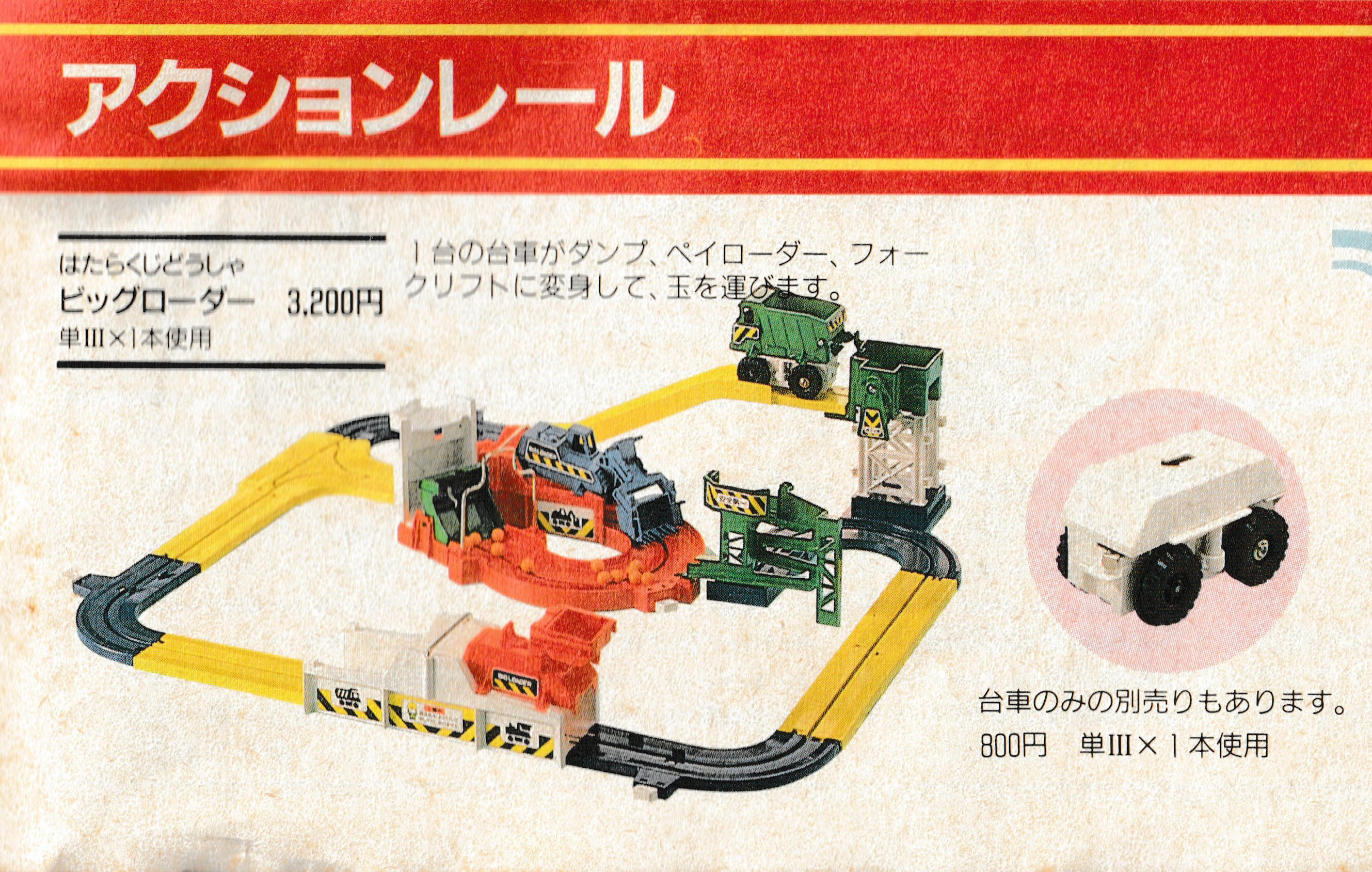
In 1990 a new Thailand-made version of Big Loader was released in Japan with some updated plastic colors and the updated single AA battery chassis. Powered chassis were also sold individually in Japan.
Starting around 1991 new Thailand production Big Loaders began being exported to America and different parts of Europe. These sets used updated Big Loader stickers with red track and blue and green accessory pieces but are otherwise based on the updated single AA Thailand version of Big Loader. In Europe these were sold in "Big Fun" packaging - I have actually even seen one of these European sets marked for import into America at a thrift store, although it was missing the power car and vehicles so I did not buy it.
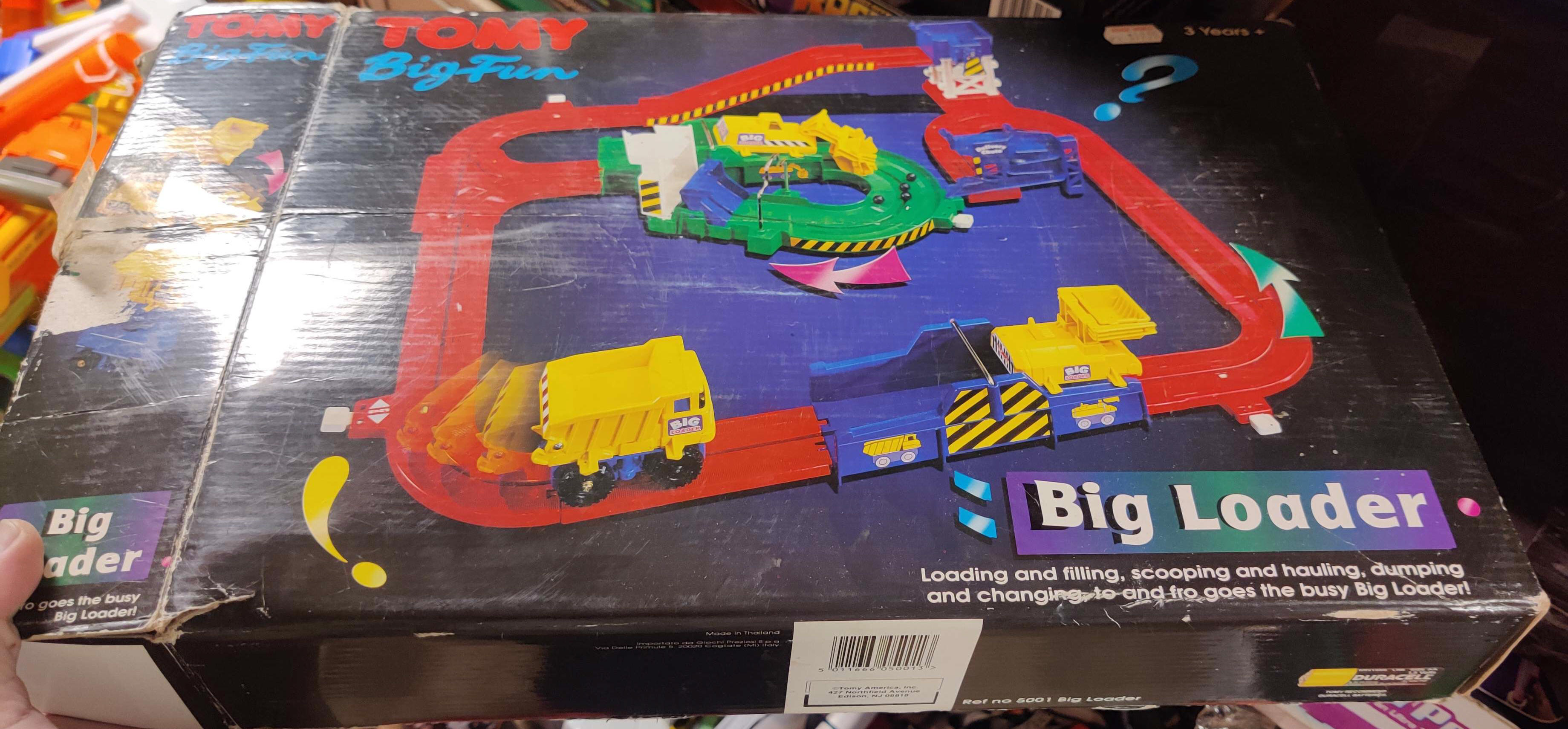
Note the Tomy America Inc. sticker on the bottom - this is an official import, not an individual buying or moving with a European release
This style box was also imported into Canada and used in the U.K. and some other regions throughout the early and mid 90s, with several "Automatic Transport" and other regional variations.
In the U.S., both a rerelease of the original-style colorway Big Loader (but with later paler stickers) like the previous 1989 white grid box American Big Loader as well as the updated 90s color version seen here were released in this "TOMY Classic" style box with 70s Playrail-style wood boarder in 1991. A slight variation on the classic coloration was also rereleased in 1991 in a red with gold accented "Tomy Big Loader" box with a closeup of the truck at the top of the ramp on the front for the bargain price of 15 dollars by Dayton-Hudson Corporation at their Target stores - it has a grey loading bay that matches the rest of the road instead of the usual brown. Big Loader would continue to stay relatively cheap throughout the 1990s, hovering around 15 dollars or 11-12 British pounds.
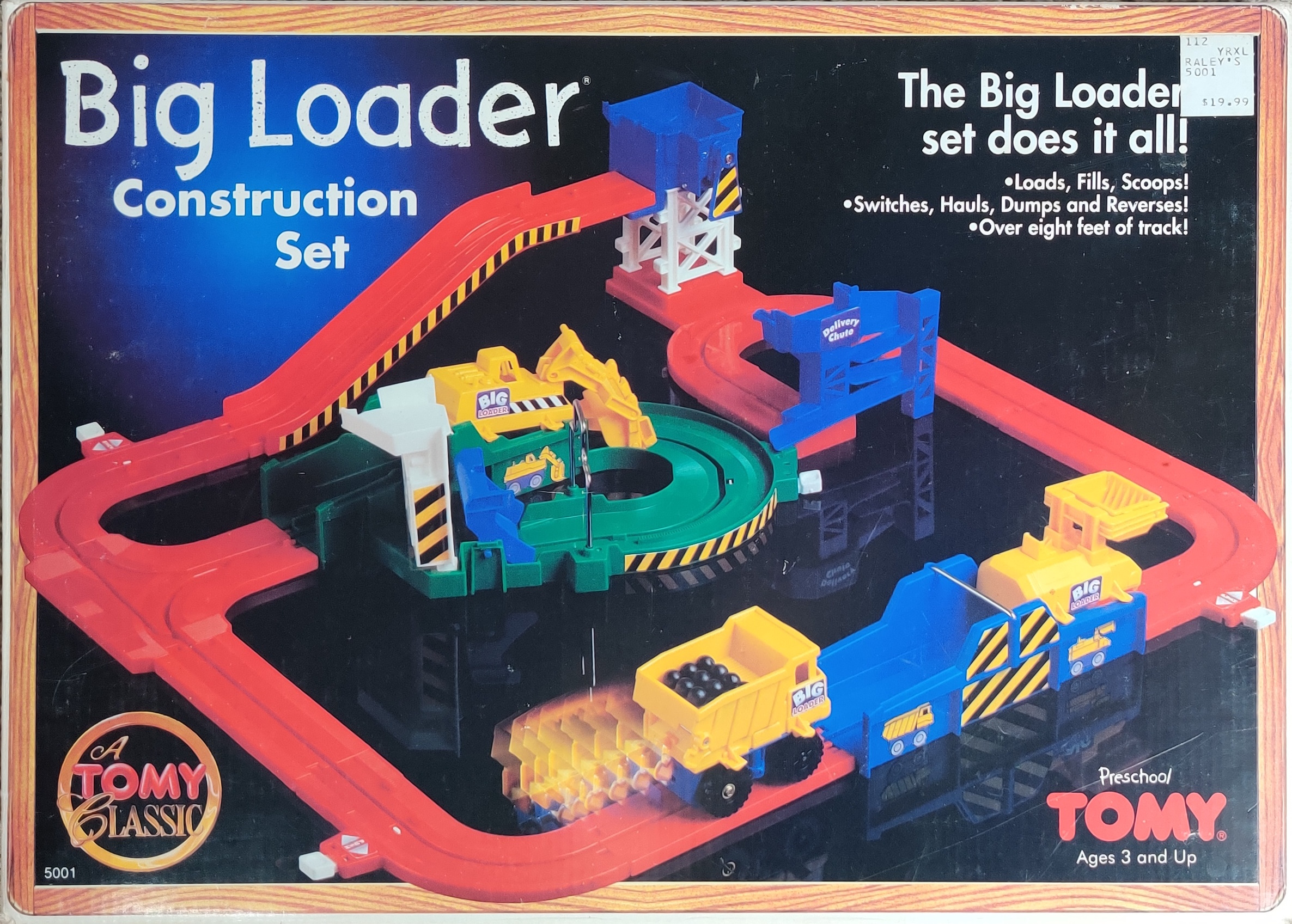

The colors in this track set are nicely updated for the 1990s and I think the classic yellow truck bodies on the blue chassis on red track looks rather nice as do the new hazard stickers. Unfortunately, I do not currently have a little blue chassis to properly demonstrate this set with (although they are all (mostly?) cross-compatible, I will probably just wait to find a 90s blue chassis in a thrift store set or something to set it up), but it performs exactly the same actions as all the others.


Set contents
| Quantity |
Item |
Photo |
|---|---|---|
| 1 |
Power chassis |
|
| 1 | Dump truck shell |
 |
| 1 | Skip loader shell |
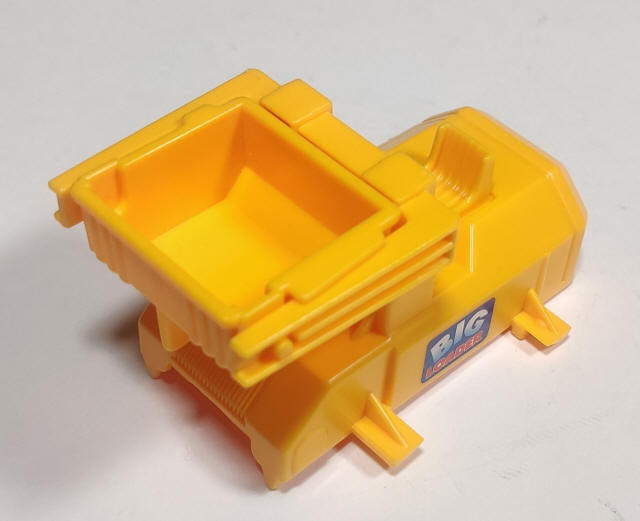 |
| 1 |
Scoop lifter shell |
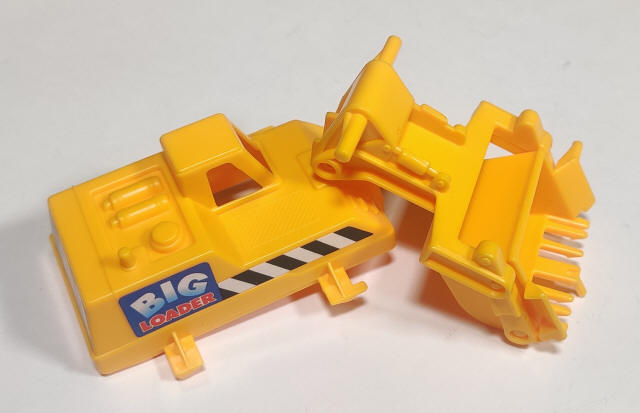
|
| 4 | Straight track |
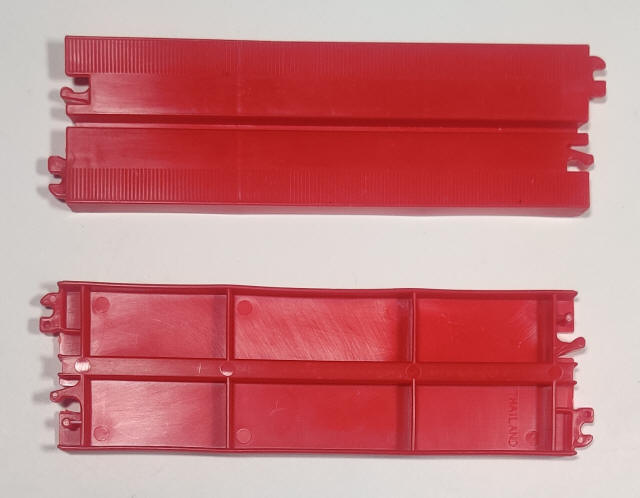
|
| 3 | Curve track |
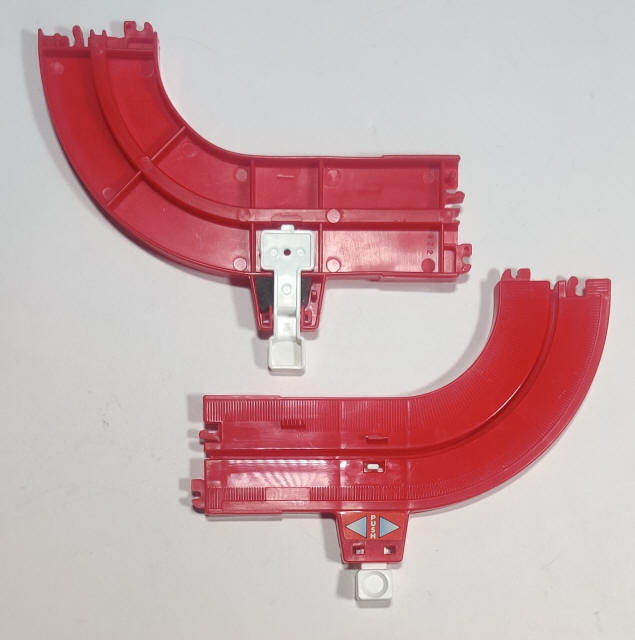 |
| 1 | Switch track |
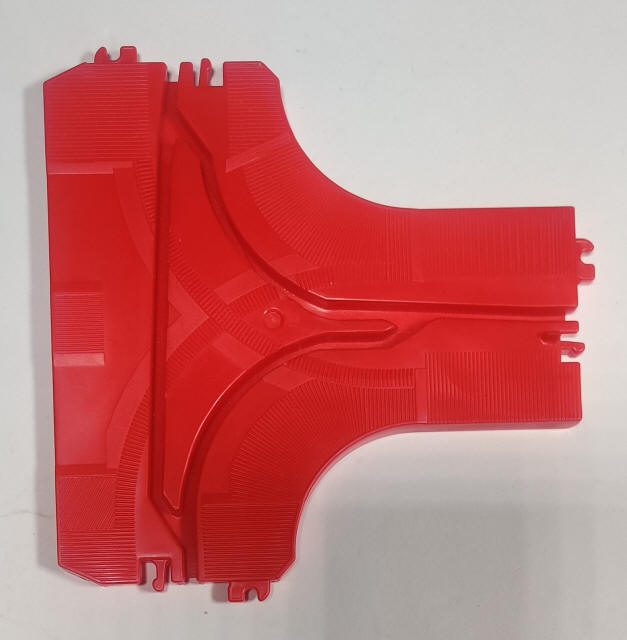 |
| 1 | Hopper track |
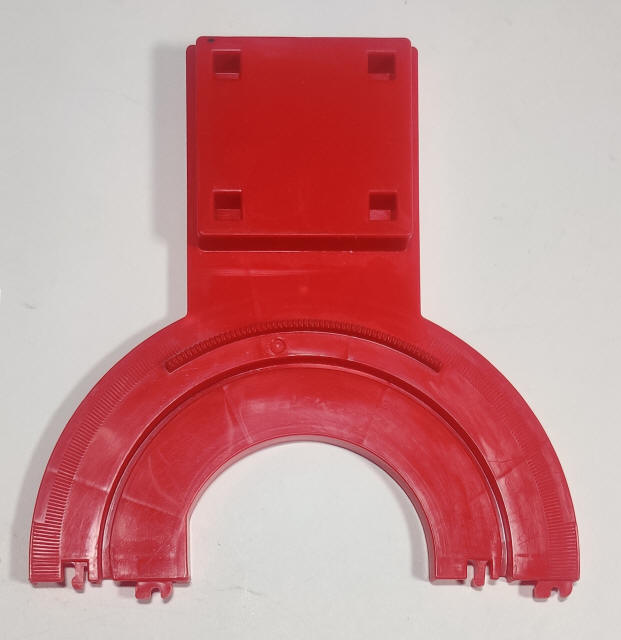 |
| 1 | Short track |
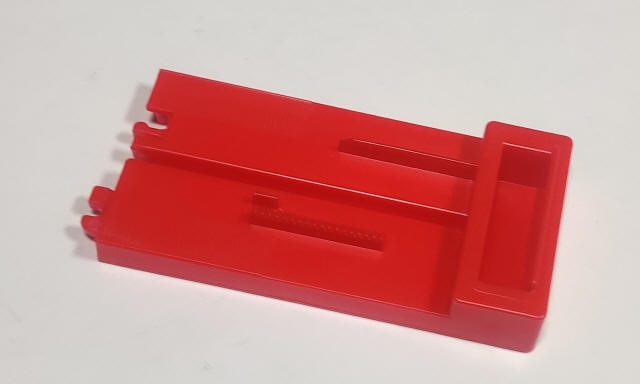 |
| 1 | Ramp track |
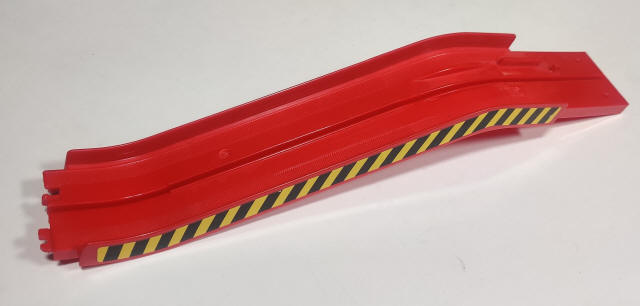 |
| 1 | Transfer ramp |
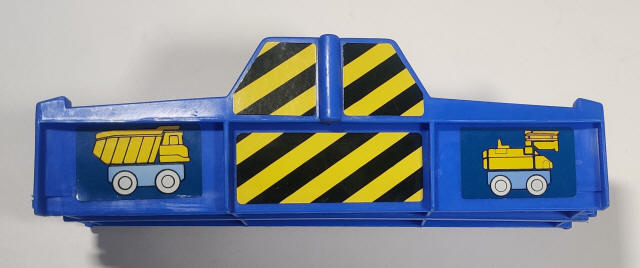 |
| 1 | Loading dock |
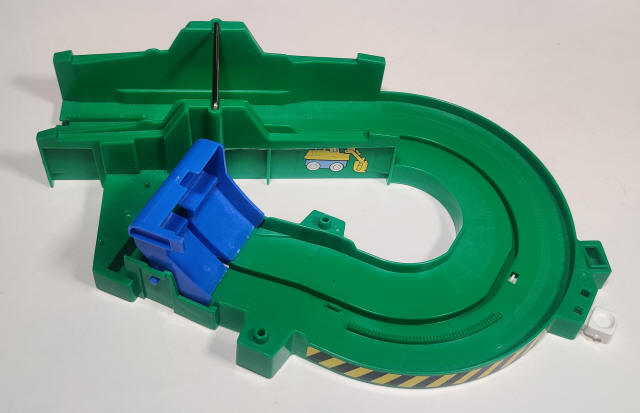 |
| 1 | Loader gate |
 |
| 1 | Loading trough |
 |
| 1 | Hopper |
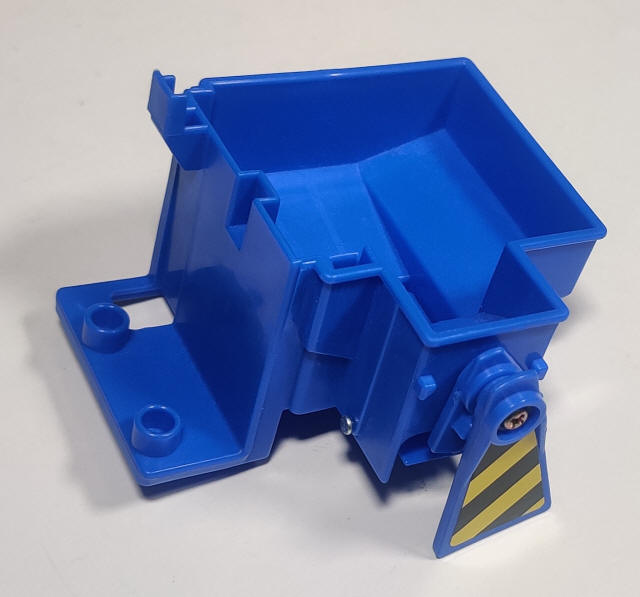 |
| 2 | Hopper supports |
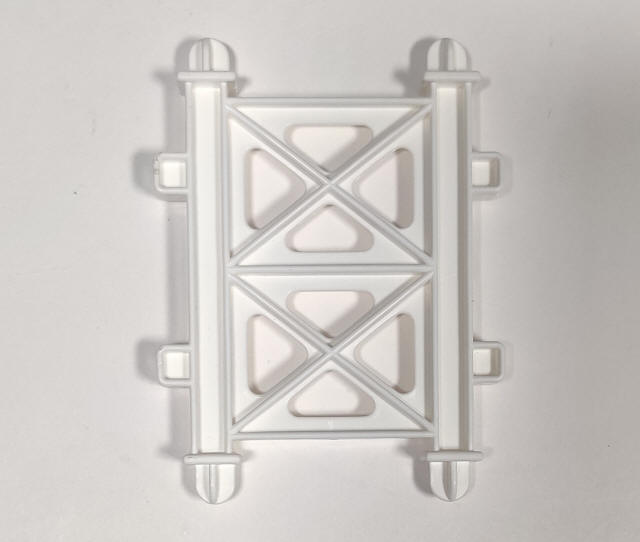 |
| 1 | Delivery chute |
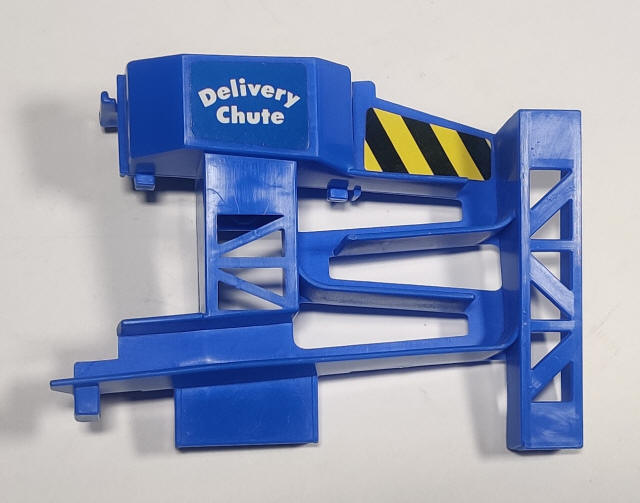 |
| 12 | "Rocks" |
In addition to the new colors and stickers, the chassis has been redesigned slightly to only allow you to insert one AA battery. Some components like straight track pieces seem to be from new Thailand toolings. This design of Big Loader was included in the 2000s Big Big Big Loader.
Big Big Loader (1994)
In 1994 a new larger Big Loader style toy was released as in Japan. This Big Loader can operate by itself or be connected to a regular Big Loader to form Big Big Big Loader. Export Big Big Loaders were released following the same color scheme with some different stickers in the mid-late 1990s.
Thomas Big Loader (1997)
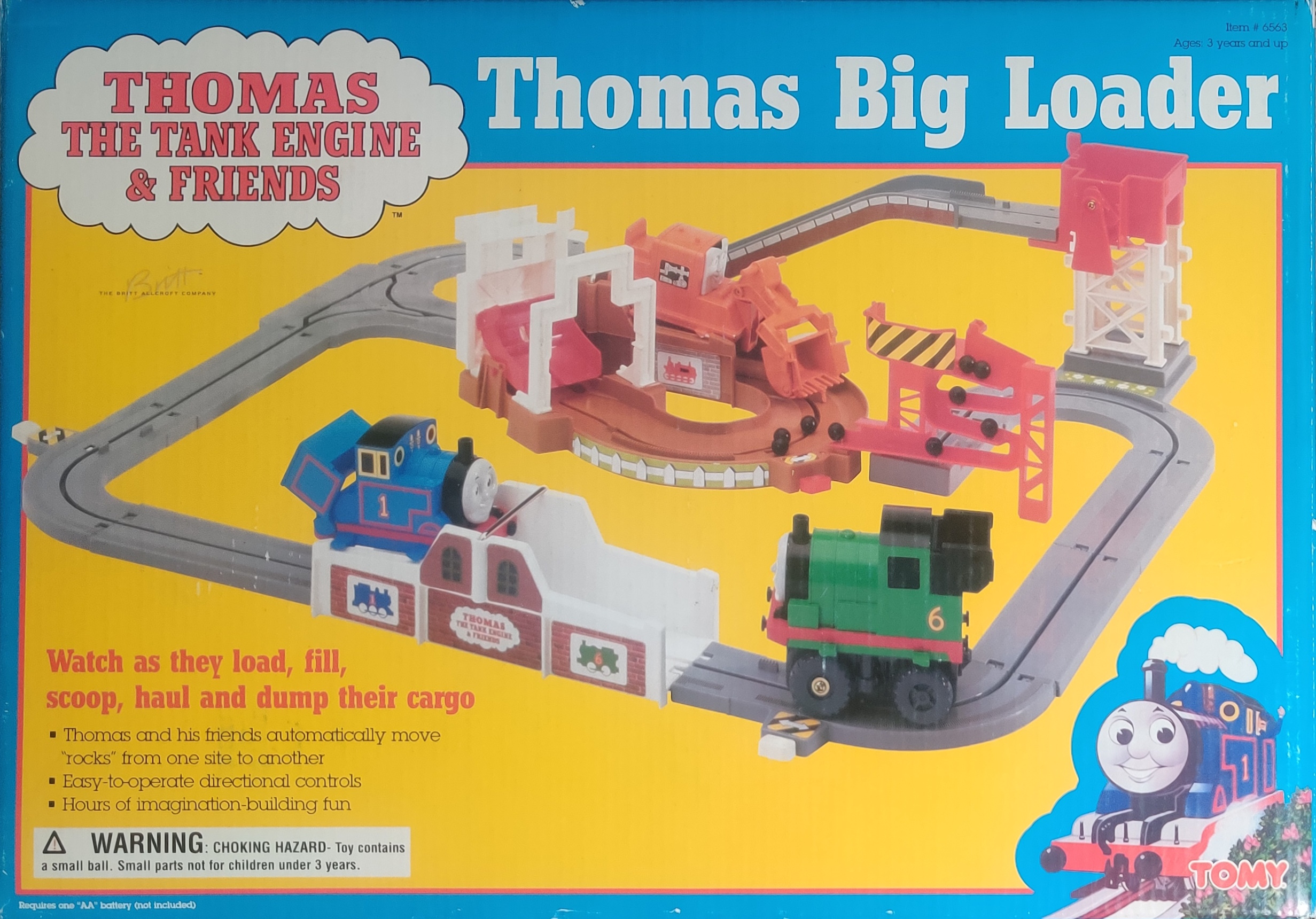

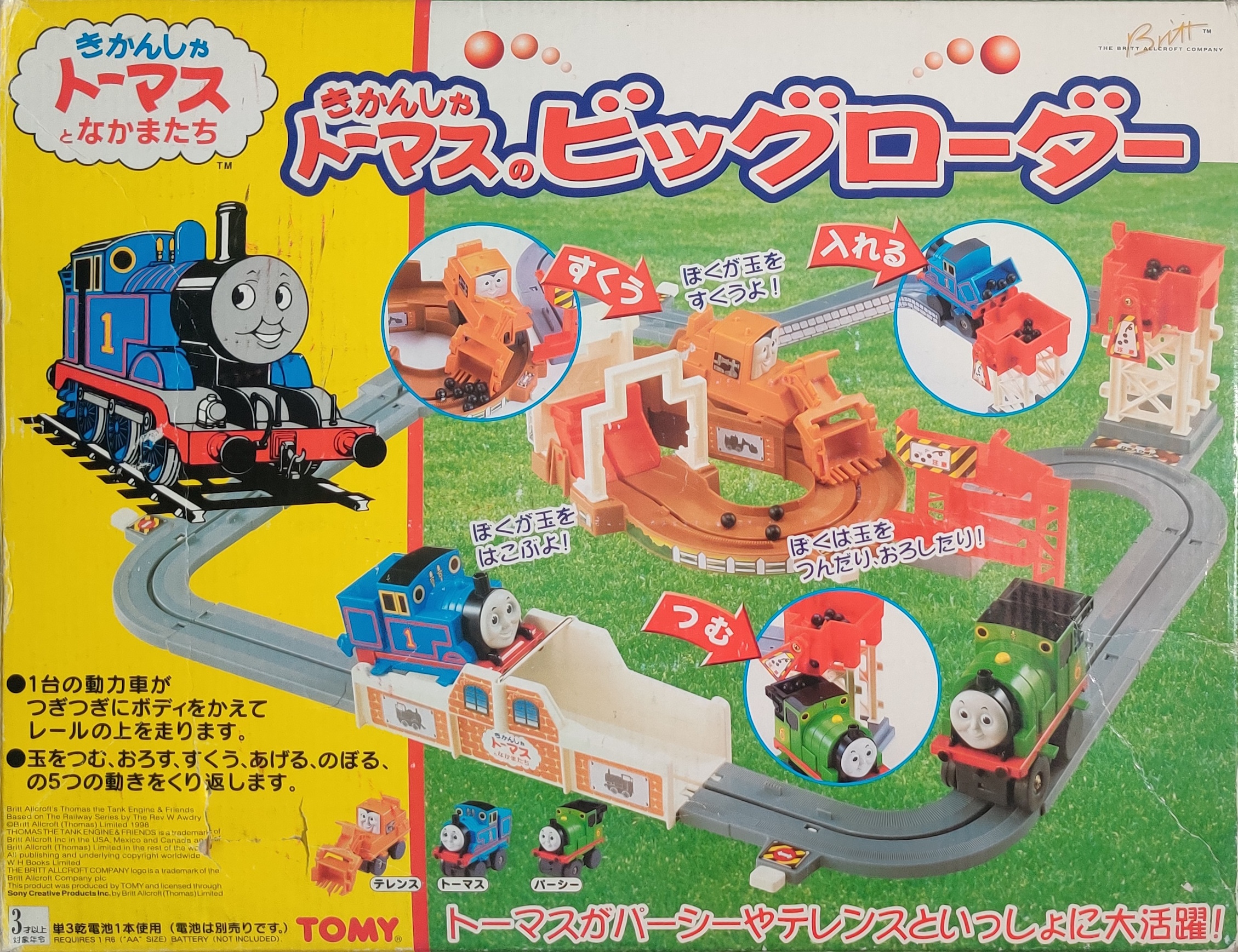
Around 1997 A Thomas the Tank Engine-themed version of the original Big Loader was released in America and Europe with a Japanese release coming around 1998. The loading dock now uses a plastic guide but otherwise the set was similar to other Thailand-produced Big Loaders.
In the 2000s the box styles were updated for the new branding style and some components were updated. Several other box variations exist. Around 2006 Tomy released a new color variation which was also sold by HiT Toy Company in the U.S., and a new version was released internationally in 2018.
The Thomas-series Big Loader, Big Big Loader, and Post Office Loader have all been ripped off by cheap Chinese toy makers who produce illegal Thomas-themed Big Loaders with no licensing. Early examples of these ripoffs were more blatant, being nearly unchanged, while later versions obfuscated the Thomas name and branding somewhat.
2000s Big Loaders
Since 2000 there have been a number of different Big Loader rereleases but I have not yet cataloged the majority of them. They are all colorful and use the new off-the-shelf power switch chassis and if I ever come across one for a good price I will document it here, but to be honest I have a lot of Big Loaders as it is.